Inbox and Environment News: Issue 594
August 13 - 19, 2023: Issue 594
Saving Native Species Grants
- 22 Birds
- 21 Mammals
- 9 Fish
- 6 Frogs
- 11 Reptiles
- 11 Invertebrates
- 30 Plants
Time Of Wiritjiribin
August
Female Lyre bird - Elanora Heights
Photo by Selena Griffith, May 29 2023
Selena says ''this one followed me along the path. Never been so close.''
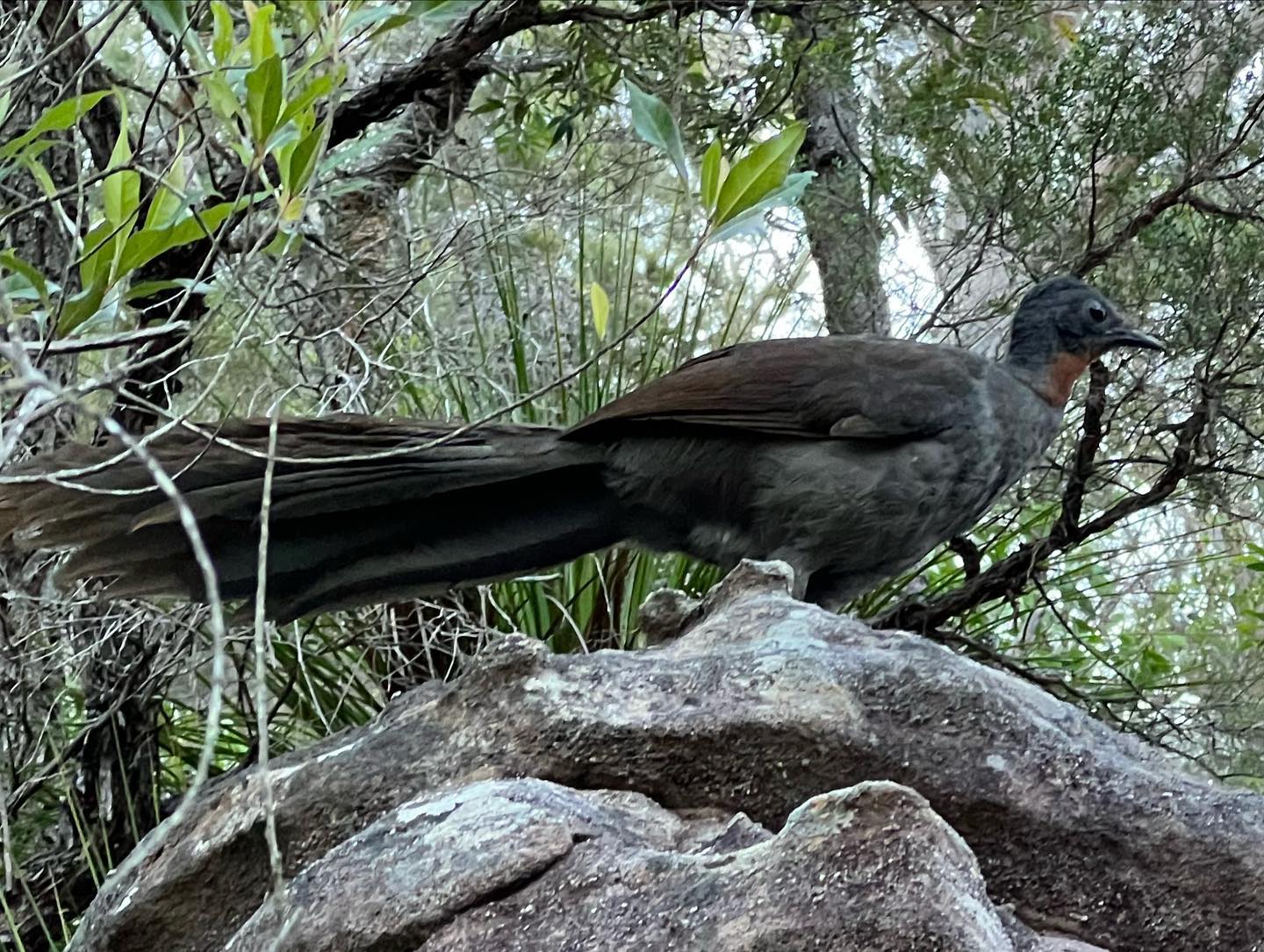
Bushcare Training Day At North Narrabeen
- Weed identification and best practice removal techniques
- Native plant identification and weed species including lookalikes
- Hands-on weed removal
- Bring along your unknown plant species for identification
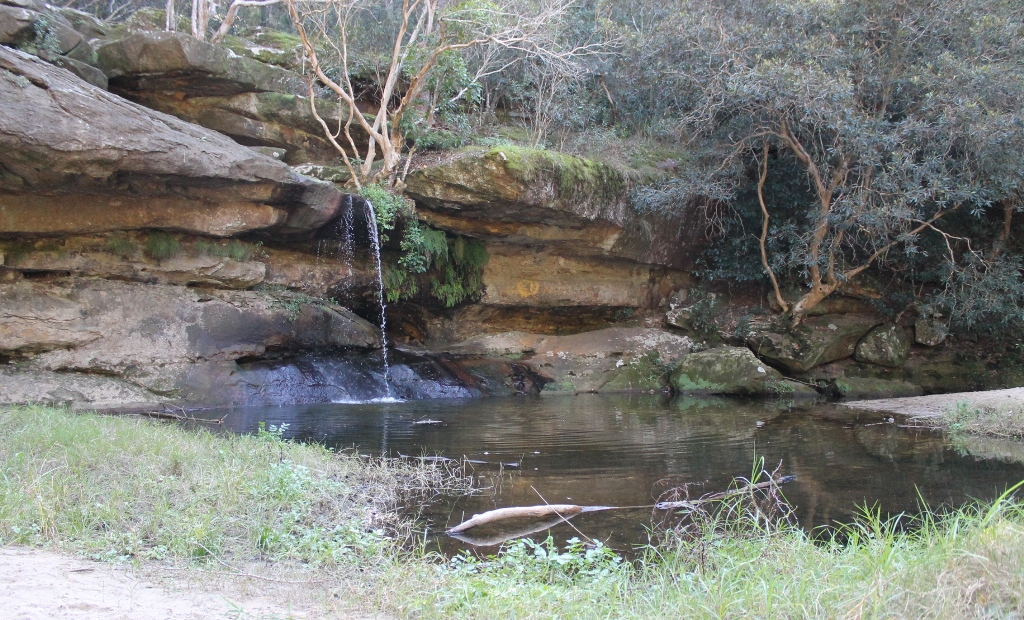
Palmgrove Park Avalon: New Bushcare Group Begins
 Palmgrove Park Avalon is a remnant of the Spotted Gum forest that was once widespread on the lower slopes of the Pittwater peninsula. This bushland’s official name and forest type is Pittwater and Wagstaffe Endangered Ecological Community, endangered because so much has been cleared for suburban development. Canopy trees, smaller trees and shrubs, and ground layer plants make up this community. Though scattered remnant Spotted Gums remain on private land, there is little chance of seedlings surviving in gardens and lawns. More information HERE
Palmgrove Park Avalon is a remnant of the Spotted Gum forest that was once widespread on the lower slopes of the Pittwater peninsula. This bushland’s official name and forest type is Pittwater and Wagstaffe Endangered Ecological Community, endangered because so much has been cleared for suburban development. Canopy trees, smaller trees and shrubs, and ground layer plants make up this community. Though scattered remnant Spotted Gums remain on private land, there is little chance of seedlings surviving in gardens and lawns. More information HERE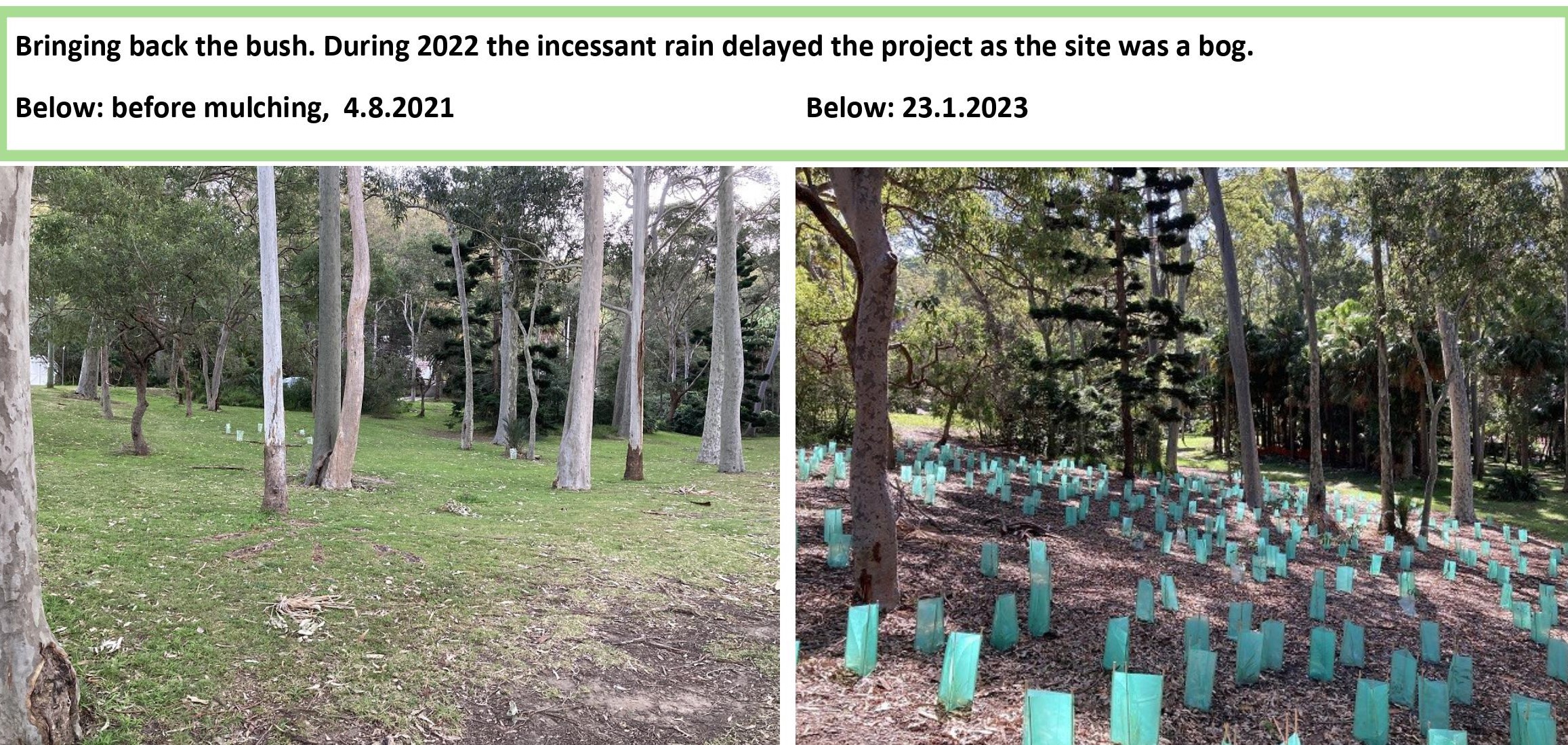
2023 Banksia Foundation NSW Sustainability Awards Open For Nominations
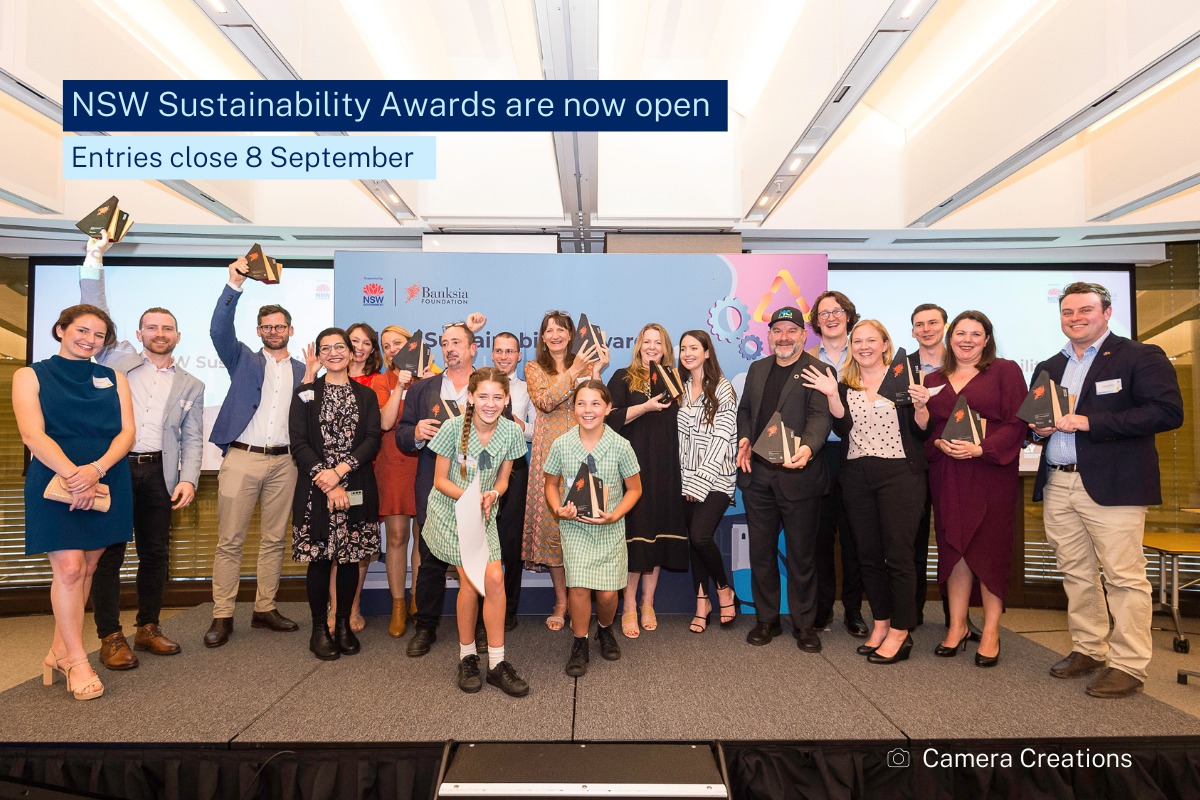
Pittwater Garage Sale Trail Returns: Repurpose Your Items

Northern Beaches Clean Up Crew: Sunday August 27 2023 From 10:00-12:15 - Turimetta Beach Clean Up
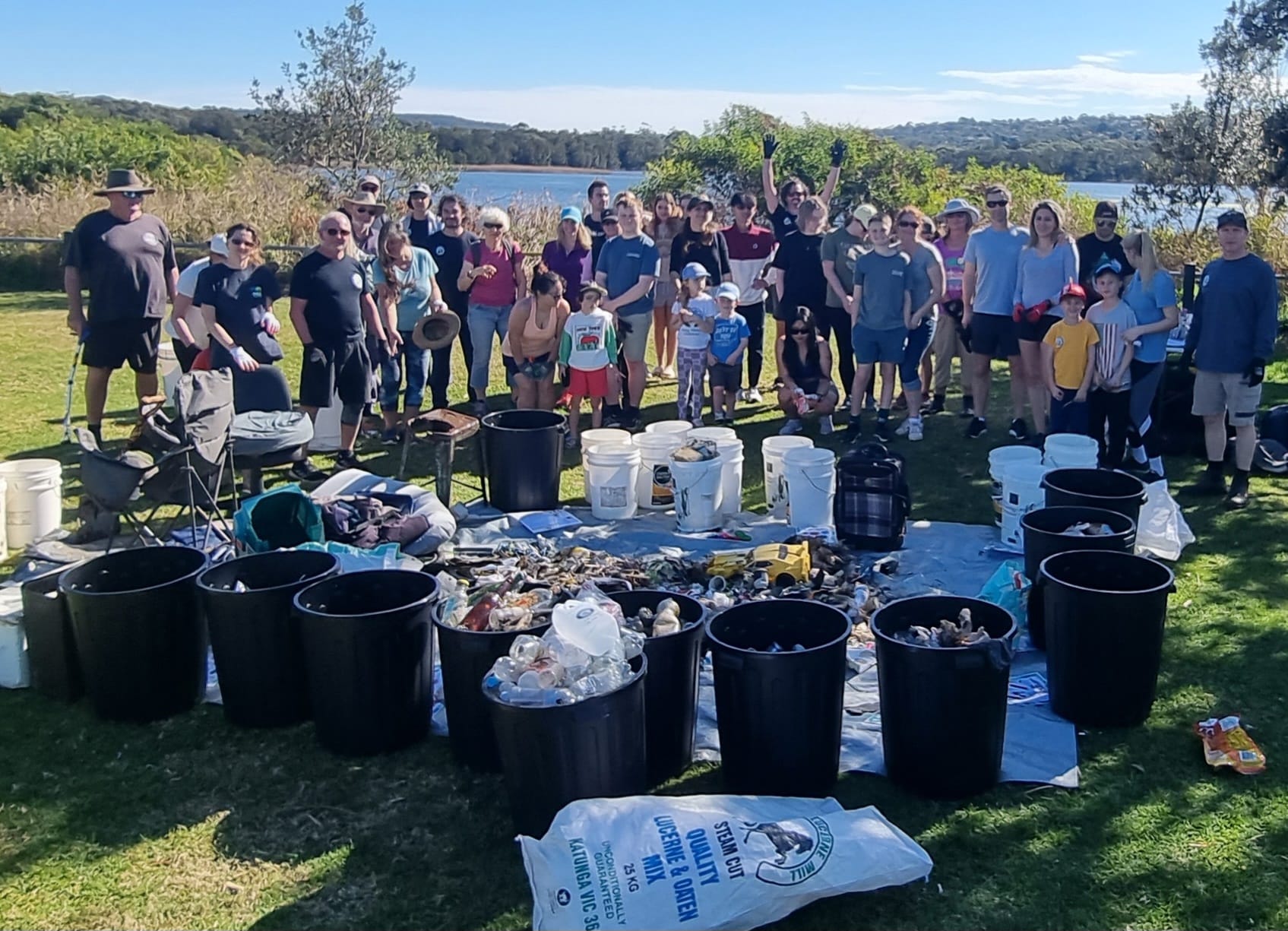
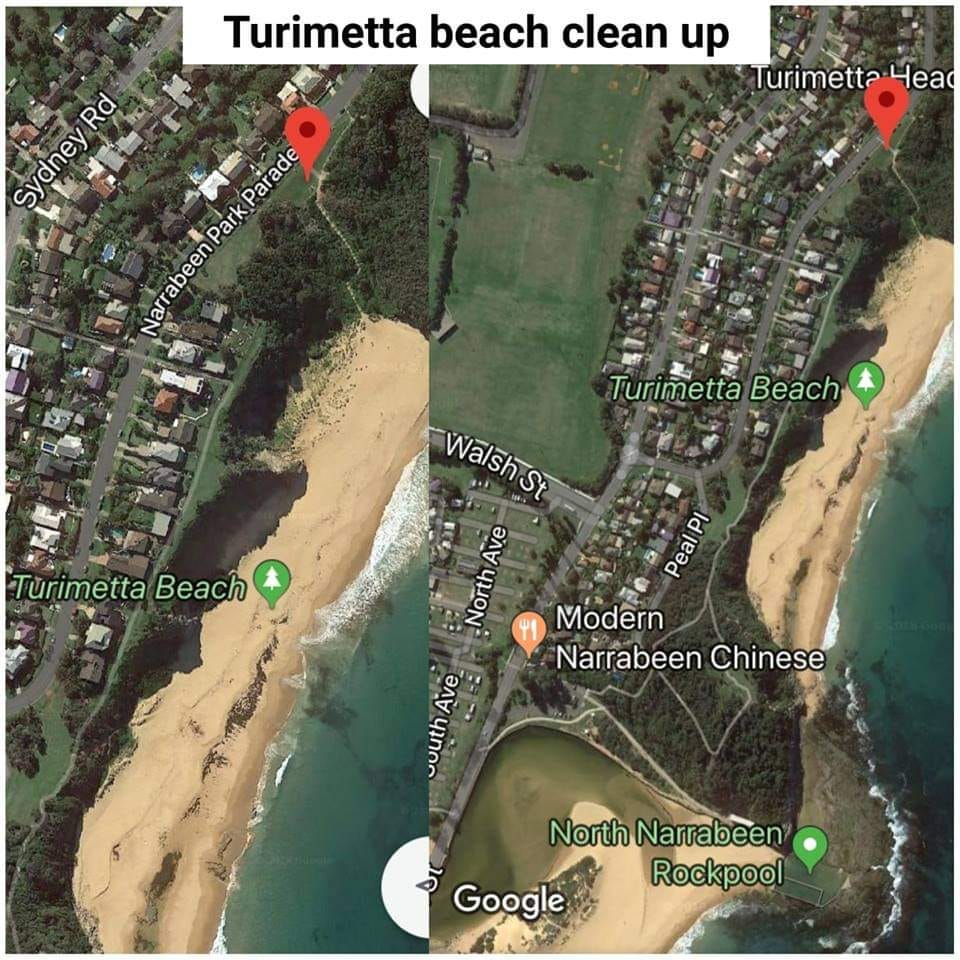
Waste And Sustainability In Schools NR37040: At Kimbriki
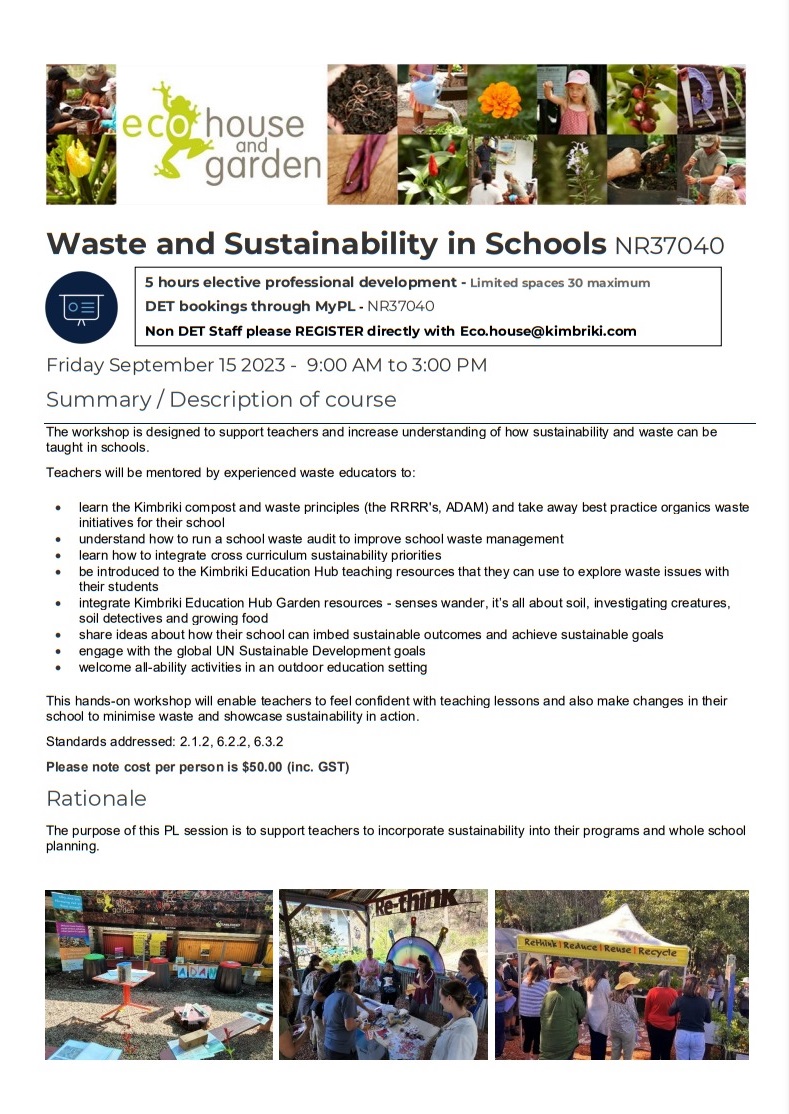
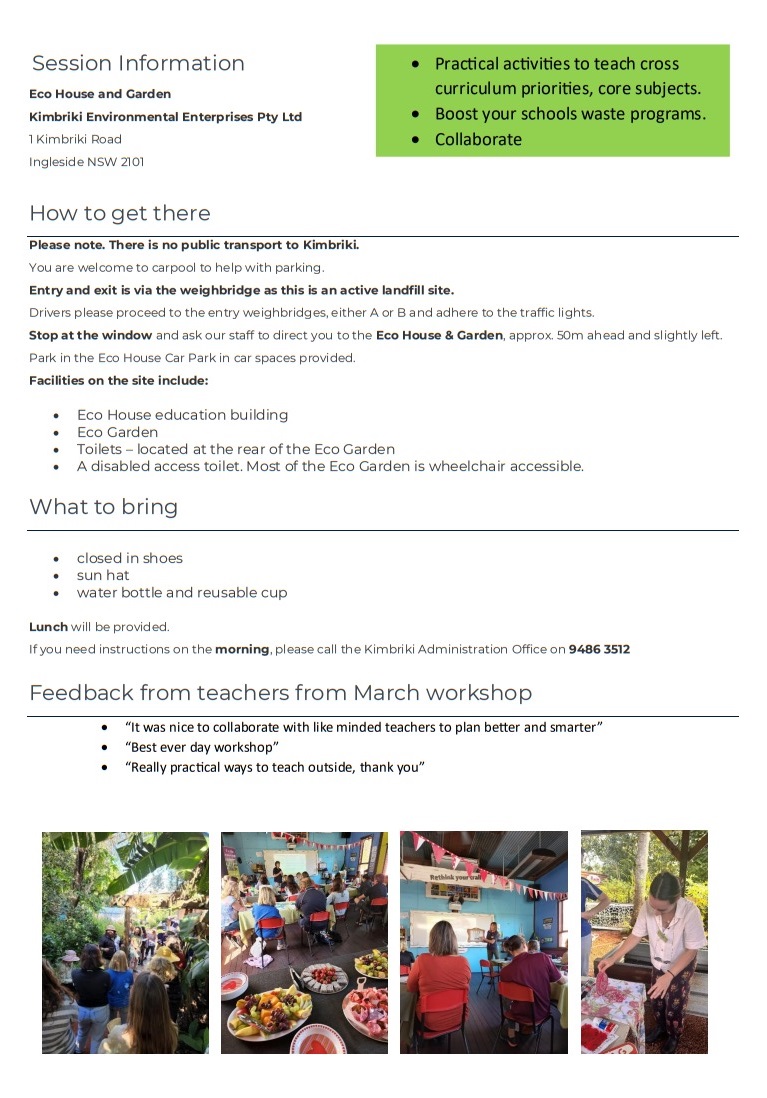
Seen Any Glossies Drinking Around Nambucca, Bellingen, Coffs Or Clarence? Want To Help?: Join The Glossy Squad
- a female bird (identifiable by yellow on her head) begging and/or being fed by a male (with plain black/brown head and body and unbarred red tail feathers)
- a lone adult male, or a male with a begging female, flying purposefully after drinking at the end of the day.

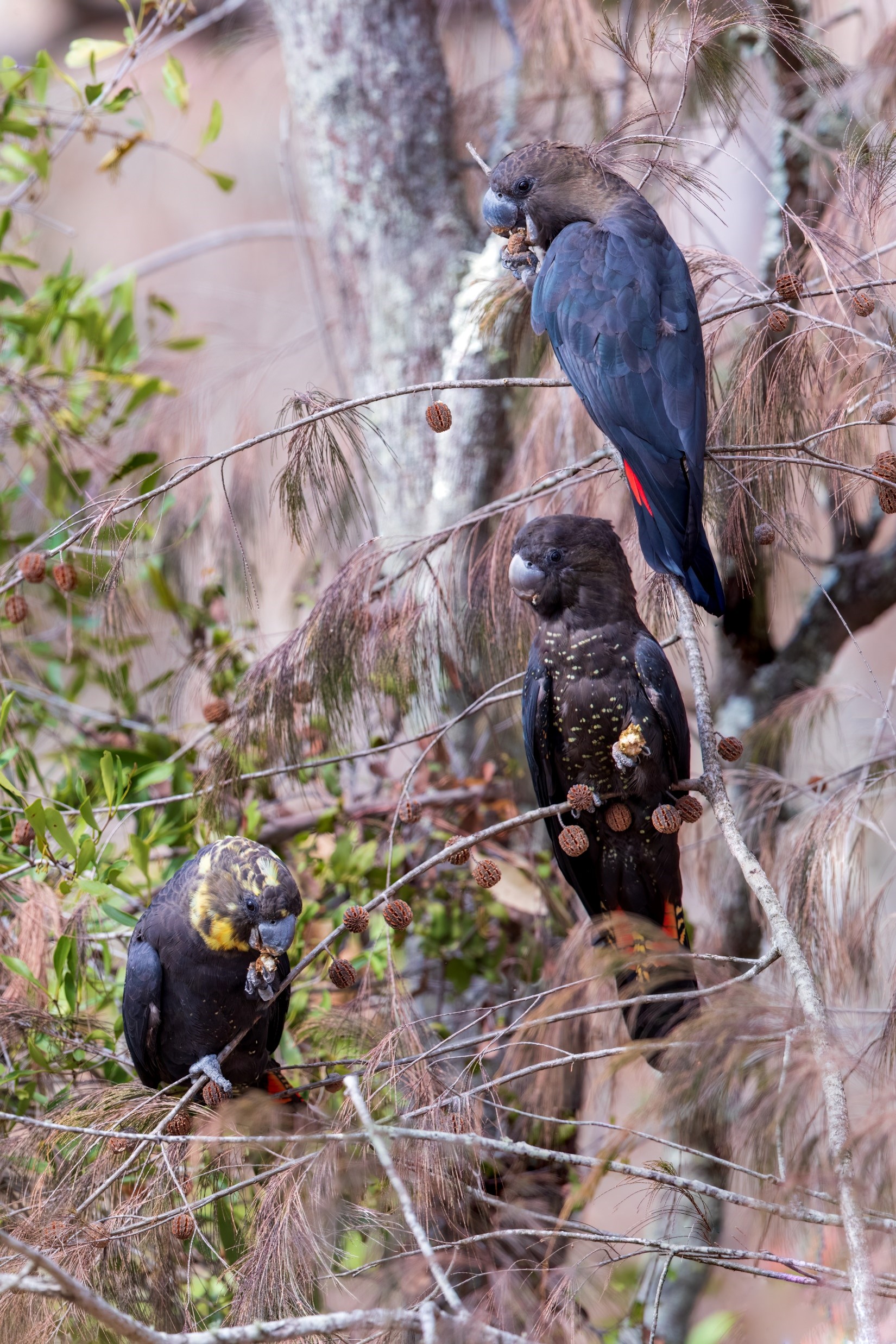
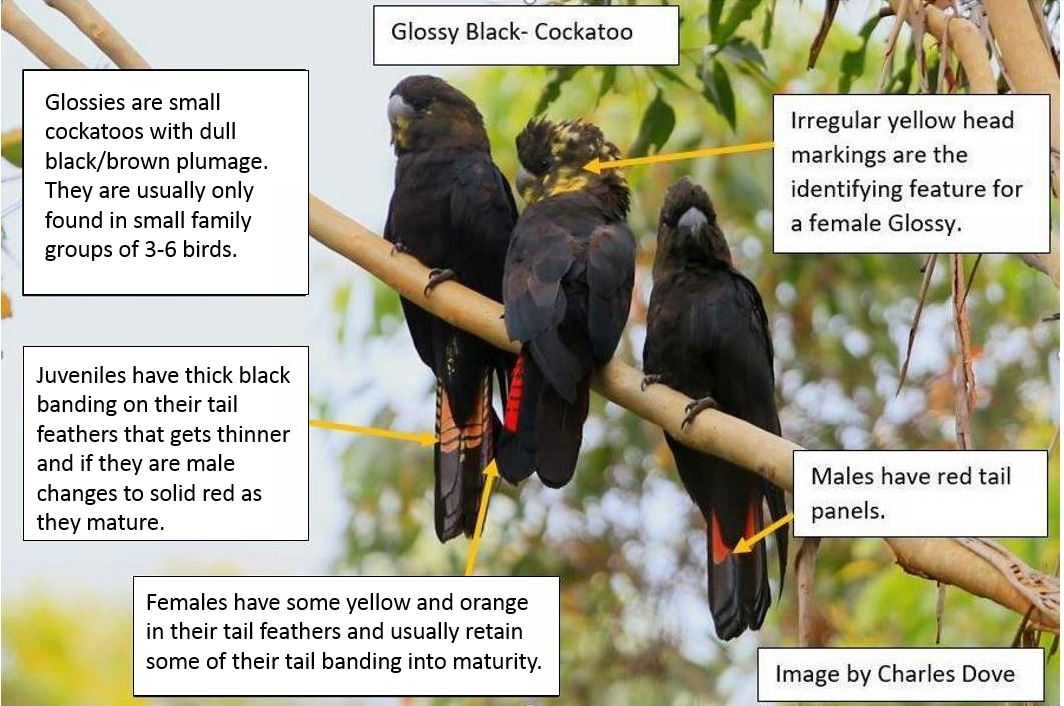
NSW Government Takes Next Steps Towards Future Jobs & Investment Authorities In Coal-Producing Regions
Cleanup Of Former Wallis Lakes Oyster Growing Site
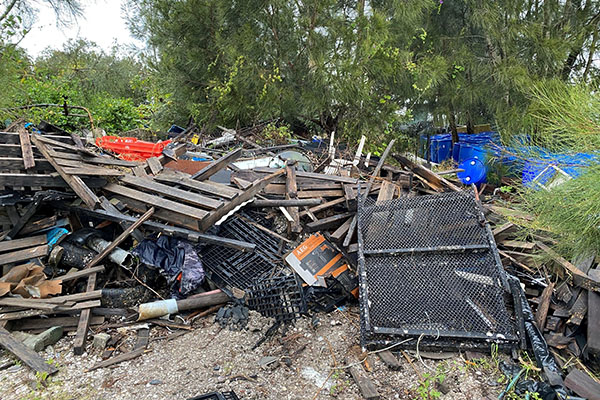
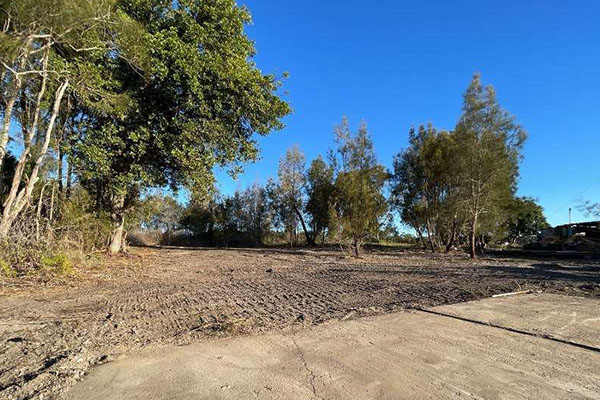
Feedback Sought For Strategic Plan Along The Hume And Hovell Track; Introducing Mountain Bikes Proposed
Community Input To Deliver The Murray-Darling Basin Plan
Blue Mountains National Park And Kanangra-Boyd National Park Draft Plan Of Management: Public Consultation
- improving recognition of the parks significant values, including World and National Heritage values, and providing for adaptive management to protect the values
- recognising and supporting the continuation of partnerships with Aboriginal communities
- providing outstanding nature-based experiences for visitors through improvements to visitor facilities - including:
- Opportunities for supported or serviced camping, where tents and services are provided by commercial tour operators, may be offered at some camping areas in the parks
- Jamison Creek, Jamison Valley Walk-in camping Potential new camping
- Leura Amphitheatre Jamison Valley Walk-in camping Potential new camping
- Mount Solitary Jamison Valley Walk-in camping Potential new camping
- Maxwell’s HuC Kedumba Valley Cabin/hut Potential new accommodation
- Kedumba Valley Maxwell’s Hut (historic slab hut) - Building restoration in progress; potential new Accommodation for bushwalkers
- Government Town Police station; courthouse - Potential new Visitor accommodation
- write clearly and be specific about the issues that are of concern to you
- note which part or section of the document your comments relate to
- give reasoning in support of your points - this makes it easier for us to consider your ideas and will help avoid misinterpretation
- tell us specifically what you agree/disagree with and why you agree or disagree
- suggest solutions or alternatives to managing the issue if you can.
Plans For New Wind Energy Project At Spicers Creek On Public Exhibition
Areas Closed For West Head Lookout Upgrades
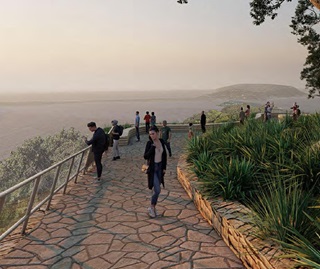 NPWS advise that the following areas are closed from Monday 22 May to Thursday 30 November 2023 while West Head lookout upgrades are underway:
NPWS advise that the following areas are closed from Monday 22 May to Thursday 30 November 2023 while West Head lookout upgrades are underway:
- West Head lookout
- The loop section of West Head Road
- West Head Army track.
Vehicles, cyclists and pedestrians will have access to the Resolute picnic area and public toilets. Access is restricted past this point.
The following walking tracks remain open:
- Red Hands track
- Aboriginal Heritage track
- Resolute track, including access to Resolute Beach and West Head Beach
- Mackeral Beach track
- Koolewong track.
The West Head lookout cannot be accessed from any of these tracks.
Image: Visualisation of upcoming works, looking east from the ramp towards Barrenjoey Head Credit: DPE
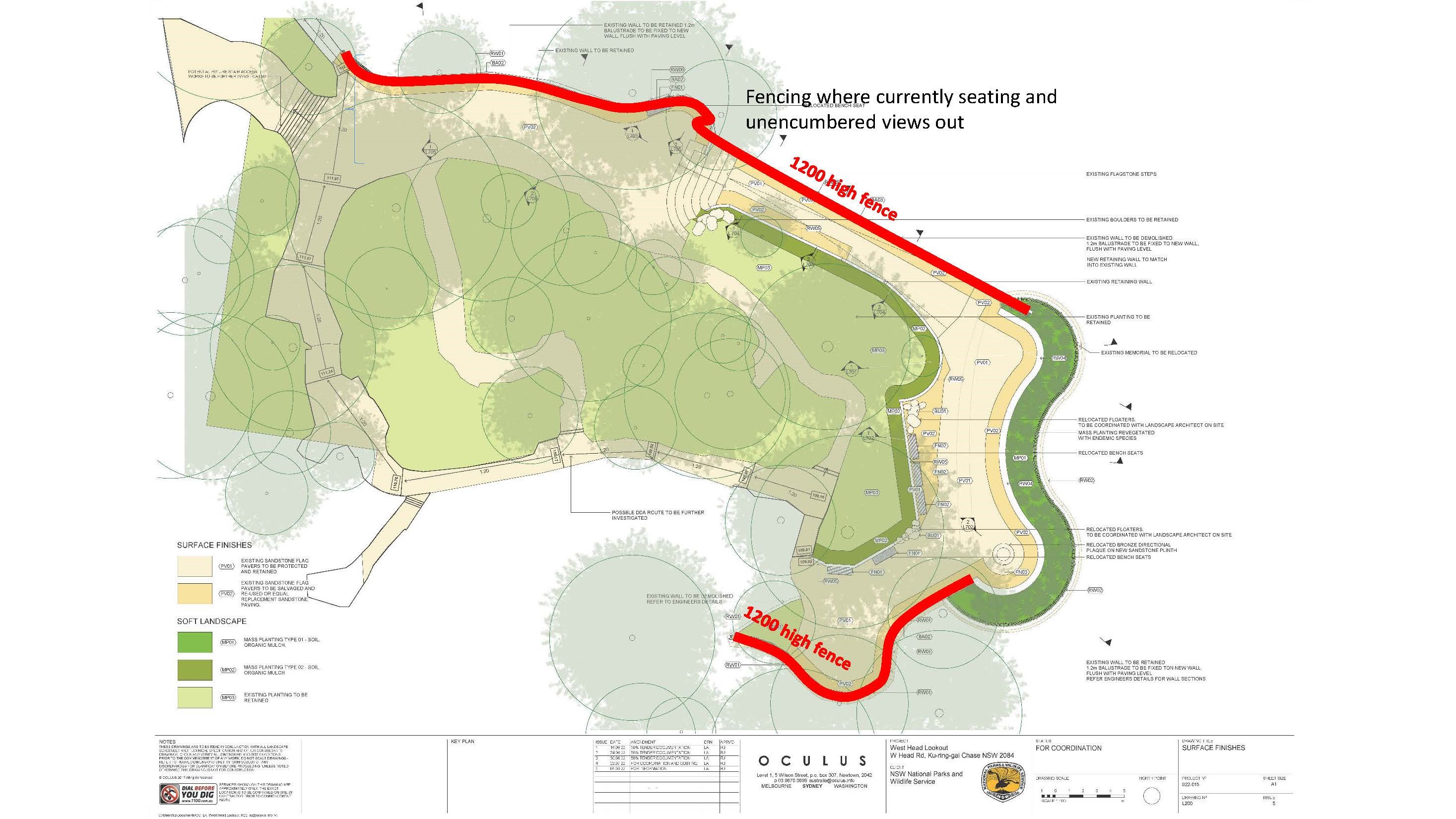
Bush Turkeys: Backyard Buddies Breeding Time Commences In August - BIG Tick Eaters - Ringtail Posse Insights
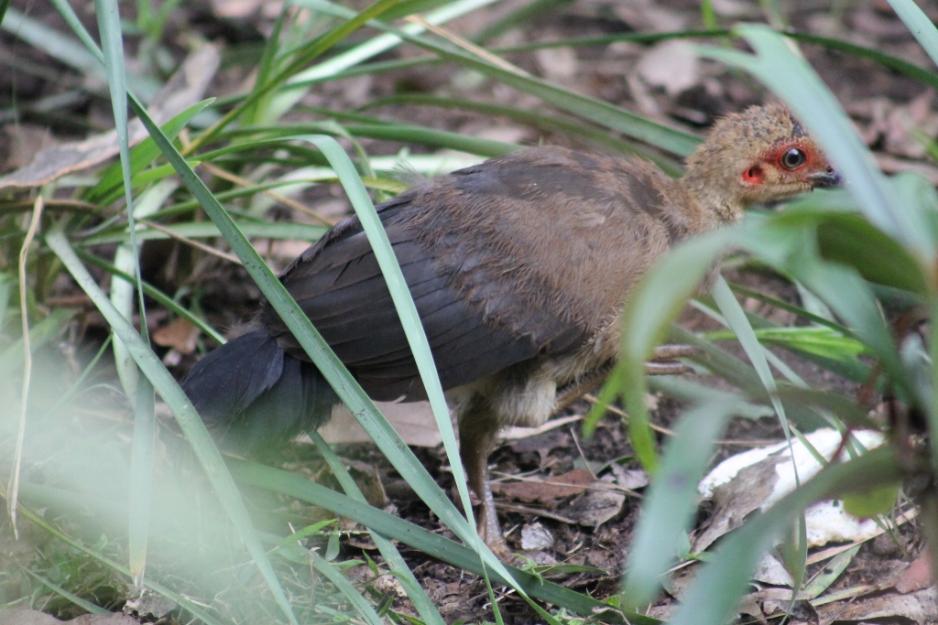
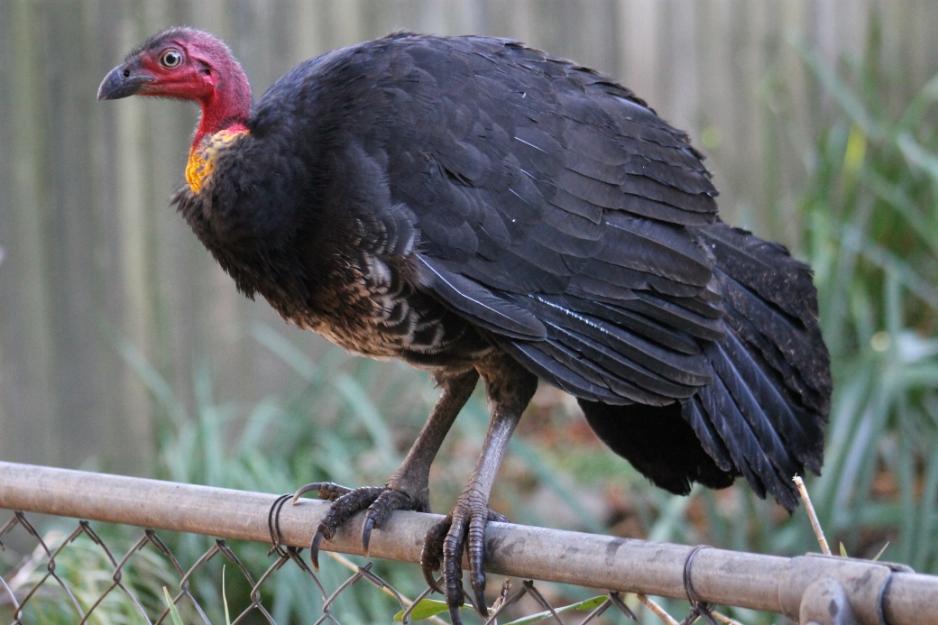
PNHA Guided Nature Walks 2023
Our walks are gentle strolls, enjoying and learning about the bush rather than aiming for destinations. Wear enclosed shoes. We welcome interested children over about 8 years old with carers. All Welcome.
So we know you’re coming please book by emailing: pnhainfo@gmail.com and include your phone number so we can contact you if weather is doubtful.
The whole PNHA 2023 Guided Nature Walks Program is available at: http://pnha.org.au/test-walks-and-talks/
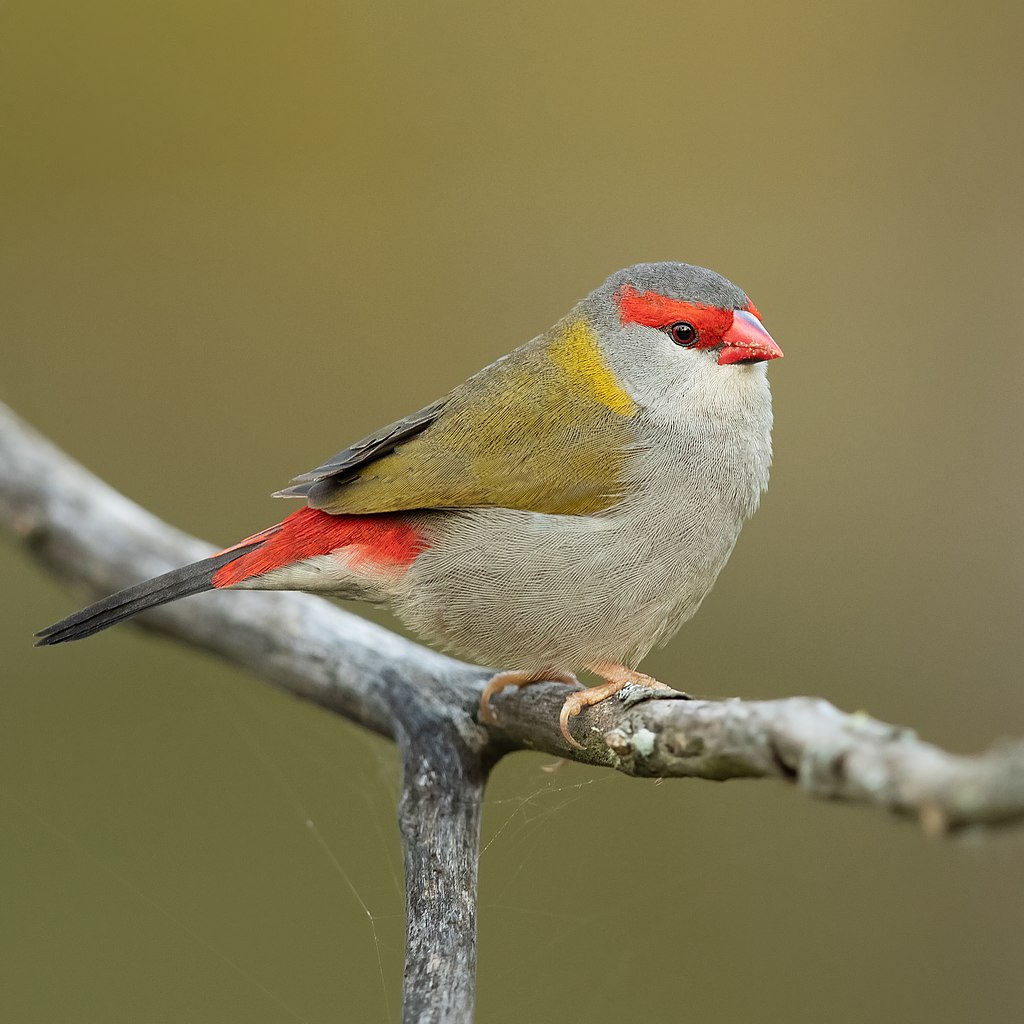
Red-browed finch (Neochmia temporalis). Photo: J J Harrison
Bushcare In Pittwater
Where we work Which day What time
Avalon
Angophora Reserve 3rd Sunday 8:30 - 11:30am
Avalon Dunes 1st Sunday 8:30 - 11:30am
Avalon Golf Course 2nd Wednesday 3 - 5:30pm
Careel Creek 4th Saturday 8:30 - 11:30am
Toongari Reserve 3rd Saturday 9 - 12noon (8 - 11am in summer)
Bangalley Headland 2nd Sunday 9 to 12noon
Bayview
Winnererremy Bay 4th Sunday 9 to 12noon
Bilgola
North Bilgola Beach 3rd Monday 9 - 12noon
Algona Reserve 1st Saturday 9 - 12noon
Plateau Park 1st Friday 8:30 - 11:30am
Church Point
Browns Bay Reserve 1st Tuesday 9 - 12noon
McCarrs Creek Reserve Contact Bushcare Officer To be confirmed
Clareville
Old Wharf Reserve 3rd Saturday 8 - 11am
Elanora
Kundibah Reserve 4th Sunday 8:30 - 11:30am
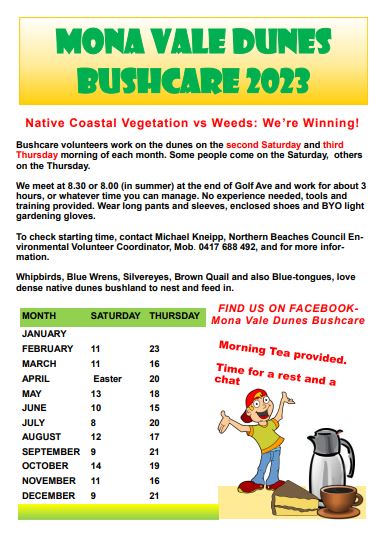 Mona Vale
Mona Vale Mona Vale Beach Basin 1st Saturday 8 - 11am
Mona Vale Dunes 2nd Saturday +3rd Thursday 8:30 - 11:30am
Newport
Bungan Beach 4th Sunday 9 - 12noon
Crescent Reserve 3rd Sunday 9 - 12noon
North Newport Beach 4th Saturday 8:30 - 11:30am
Porter Reserve 2nd Saturday 8 - 11am
North Narrabeen
Irrawong Reserve 2nd Saturday 2 - 5pm
Palm Beach
North Palm Beach Dunes 3rd Saturday 9 - 12noon
Scotland Island
Catherine Park 2nd Sunday 10 - 12:30pm
Elizabeth Park 1st Saturday 9 - 12noon
Pathilda Reserve 3rd Saturday 9 - 12noon
Warriewood
Warriewood Wetlands 1st Sunday 8:30 - 11:30am
Whale Beach
Norma Park 1st Friday 9 - 12noon
Western Foreshores
Coopers Point, Elvina Bay 2nd Sunday 10 - 1pm
Rocky Point, Elvina Bay 1st Monday 9 - 12noon
Friends Of Narrabeen Lagoon Catchment Activities

Gardens And Environment Groups And Organisations In Pittwater
Report Fox Sightings
%20(1).jpg?timestamp=1675893929686)
Marine Wildlife Rescue Group On The Central Coast
A new wildlife group was launched on the Central Coast on Saturday, December 10, 2022.
Marine Wildlife Rescue Central Coast (MWRCC) had its official launch at The Entrance Boat Shed at 10am.
The group comprises current and former members of ASTR, ORRCA, Sea Shepherd, Greenpeace, WIRES and Wildlife ARC, as well as vets, academics, and people from all walks of life.
Well known marine wildlife advocate and activist Cathy Gilmore is spearheading the organisation.
“We believe that it is time the Central Coast looked after its own marine wildlife, and not be under the control or directed by groups that aren’t based locally,” Gilmore said.
“We have the local knowledge and are set up to respond and help injured animals more quickly.
“This also means that donations and money fundraised will go directly into helping our local marine creatures, and not get tied up elsewhere in the state.”
The organisation plans to have rehabilitation facilities and rescue kits placed in strategic locations around the region.
MWRCC will also be in touch with Indigenous groups to learn the traditional importance of the local marine environment and its inhabitants.
“We want to work with these groups and share knowledge between us,” Gilmore said.
“This is an opportunity to help save and protect our local marine wildlife, so if you have passion and commitment, then you are more than welcome to join us.”
Marine Wildlife Rescue Central Coast has a Facebook page where you may contact members. Visit: https://www.facebook.com/profile.php?id=100076317431064
- Ph: 0478 439 965
- Email: marinewildlifecc@gmail.com
- Instagram: marinewildliferescuecc

Watch Out - Shorebirds About
.JPG.opt1460x973o0,0s1460x973.jpg?timestamp=1663629195339)
Possums In Your Roof?: Do The Right Thing

Aviaries + Possum Release Sites Needed

Meet 5 marvellous mammals of the South Pacific you’ve probably never heard of

Islands are renowned for their weird and wonderful wildlife. These isolated ecosystems present unparalleled opportunities to study evolution, and the archipelagos of the southwest Pacific are no exception.
This vast and diverse region encompasses 24 nations and territories. It also includes four “biodiversity hotspots”: the East Melanesian Islands, Polynesia-Micronesia, New Caledonia and New Zealand. Each contains at least 1,500 plant species found nowhere else on Earth. So their total land area may be small, but south-west Pacific islands punch well above their weight in terms of their contributions to global biodiversity.
Our latest book provides glimpses of more than 180 native mammals of the southwest Pacific, on islands that fall under the banners of Polynesia, Micronesia and Melanesia (but excluding the island of New Guinea). Indigenous species of marsupials, bats, rodents and a monotreme are among the animals found here. Not surprisingly, half of these are endemic. Many are found only on a single island or small group of islands.
Let’s meet five charismatic species you’ve probably never have heard of, but simply must get to know.
1. Black Dorcopsis Or Black Forest Wallaby (Dorcopsis Atrata)
Conservation status: critically endangered
Distribution: Goodenough Island (Papua New Guinea)
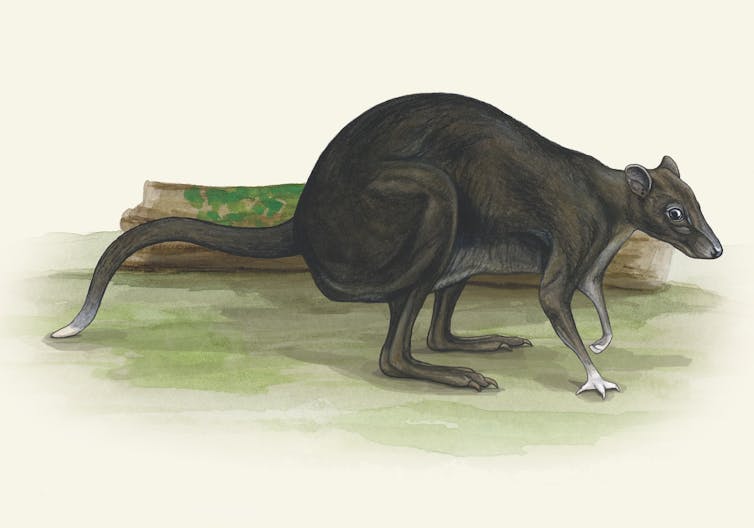
At the southeastern tip of Papua New Guinea is the gravity-defying Goodenough Island. It looms more than 2,500 metres above sea level, but it’s only about 3,900 metres wide – at the widest point.
Goodenough’s higher peaks are covered in rare forests. Here among the clouds is the only place you’ll find black dorcopsis.
Black dorcopsis often have very worn claws, suggesting they spend a great deal of time digging for truffles in the rocky soil. This probably plays an important role in dispersing fungi throughout their habitat.
Curiously, some appear to be wearing white gloves, on one or both front paws. Others do not. No one knows why.
2. Waigeo Cuscus (Spilocuscus Papuensis)
Conservation status: vulnerable
Distribution: Waigeo (Indonesia)
Waigeo cuscus have a remarkable coat. Irregular black splotches stand out against a background of almost pure white. In young animals these contrasting colours are subdued by the presence of blackish-grey tips to the hairs.
The cuscus have been photographed in the branches of fruiting fig (Ficus spp.) and breadfruit (Artocarpus altilis) trees, so they have a taste for fruit.
3. Bougainville Melomys (Melomys Bougainville)
Conservation status: data deficient
Distribution: Bougainville (Papua New Guinea), Choiseul and Mono (Solomon Islands)
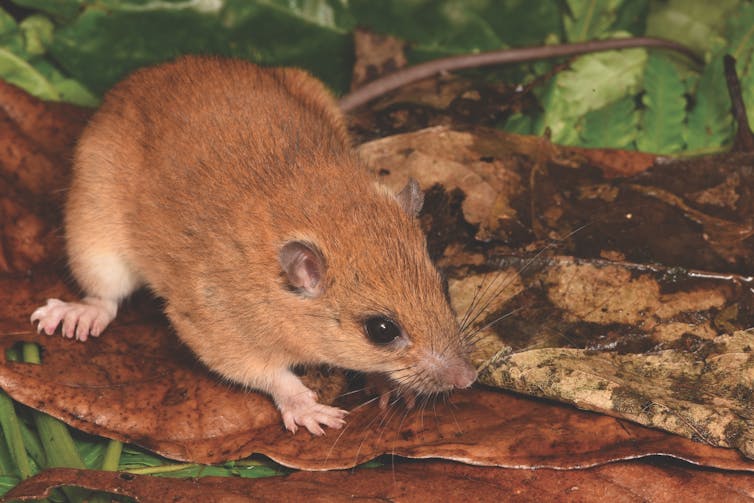
Pacific Island native rodents have proven vulnerable to disturbance, but thankfully Bougainville melomys seems to remain relatively common.
The contrast between orange fur on the head and back, and crisp white fur on the belly is rather attractive.
An active climber, Bougainville melomys can be found tiptoeing along thin woody vines (lianas), in fruiting trees among Bismarck common cuscuses (Phalanger breviceps), or scaling the trunks of wild betel nut palms (Areca spp.). They’ll tolerate disturbance and have been known to visit village edges to nibble on cultivated bananas.
4. Lesser Sheath-Tailed Bat (Mosia Nigrescens)
Conservation status: least concern
Distribution: Widespread throughout Indonesia, Papua New Guinea and Solomon Islands
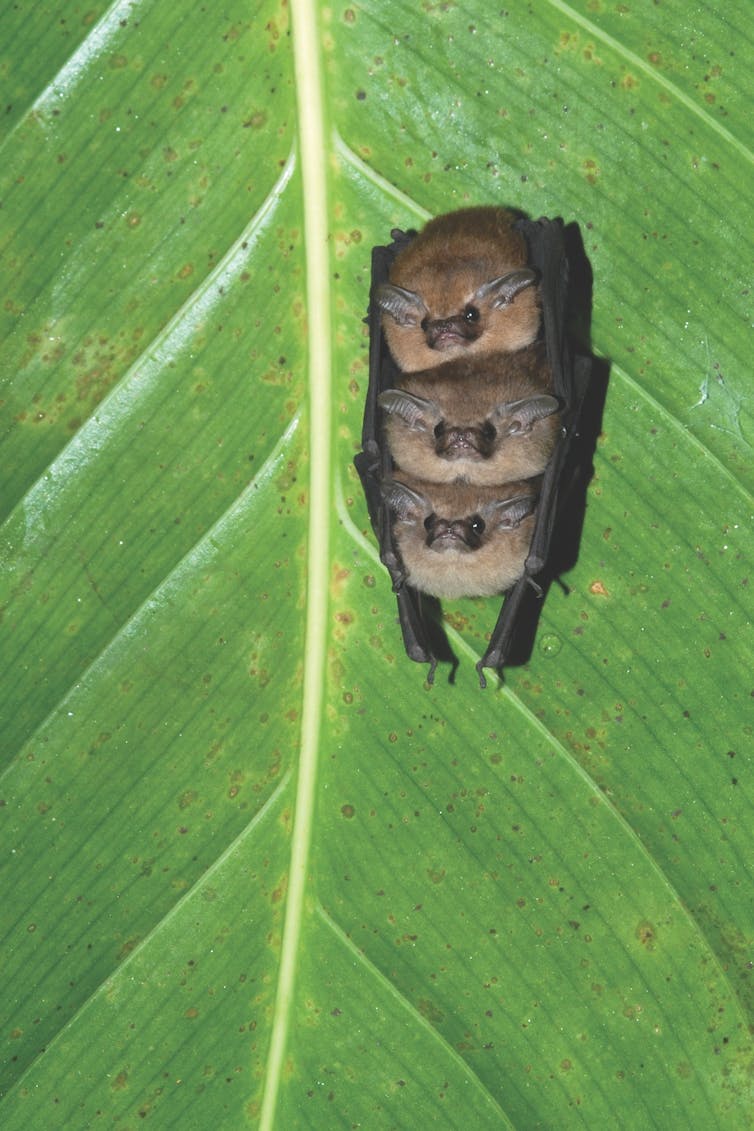
If you’re quiet and patient while walking through the palm-filled lowland forests of Melanesia, you might be lucky enough to spot one of the region’s smallest and most common echo locating bats.
Lesser sheath-tailed bats are alert little creatures with good eyesight. They rest in small groups huddled together under the cover of a palm leaf where they’re sheltered from the rain. Although watchful, they’ll stay in place if approached with caution, allowing time to view how neatly stacked they are.
Lesser sheath-tailed bats are among the first to emerge of an evening, leaving their palm tree tents while there is still plenty of twilight. They fly in sharp circles in the open spaces above forests and villages. Then as darkness falls, they move away to focus on other areas.
Later in the evening you can find them back in the same roosts, again lined up front to back, taking a breather from their busy schedule of hunting for insects on the wing.
5. Palau Flying-Fox (Pteropus Pelewensis)
Conservation status: vulnerable
Distribution: Ulithi, Yap (Federated States of Micronesia), Palau
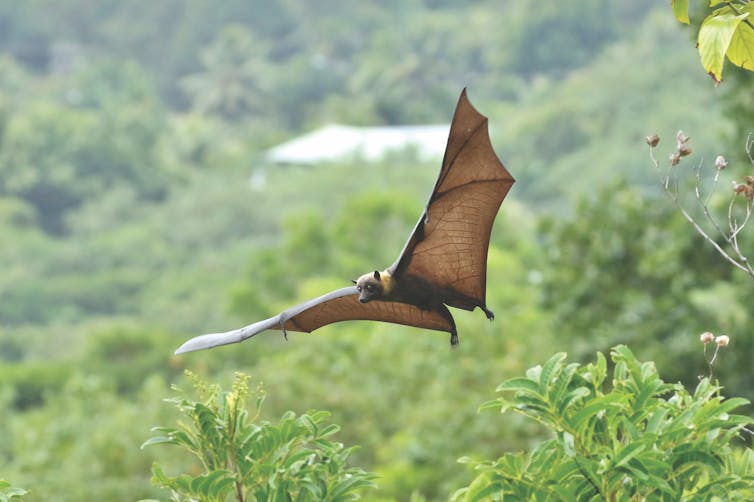
The south-west Pacific supports an incredible diversity of endemic Pteropus flying-foxes. Over-harvesting and international trade for human consumption pushed most of Micronesia’s flying-foxes to the brink of extinction (and in fact did send two species extinct).
Thankfully the introduction of restrictions under the Convention on International Trade in Endangered Species stabilised populations of the Palau fying-fox. However, it remains vulnerable and threatened by habitat loss and climate change.
So Much To Learn
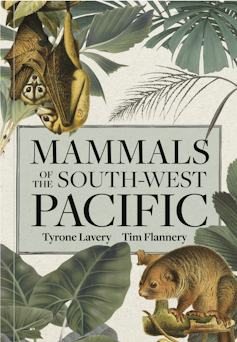
The species showcased here represent just a small fraction of the diversity of south-west Pacific mammals.
So many unique species evolved here, on discrete areas of land separated by ocean.
Unfortunately islands are also vulnerable to human disturbance and extinctions have already occurred here.
There is still much to learn about many of these mammals. We hope this book will inspire more research, including how we can keep these fascinating island inhabitants thriving in a time of such great environmental change. ![]()
Tyrone Lavery, , The University of Melbourne
This article is republished from The Conversation under a Creative Commons license. Read the original article.
Bats are avoiding solar farms and scientists aren’t sure why
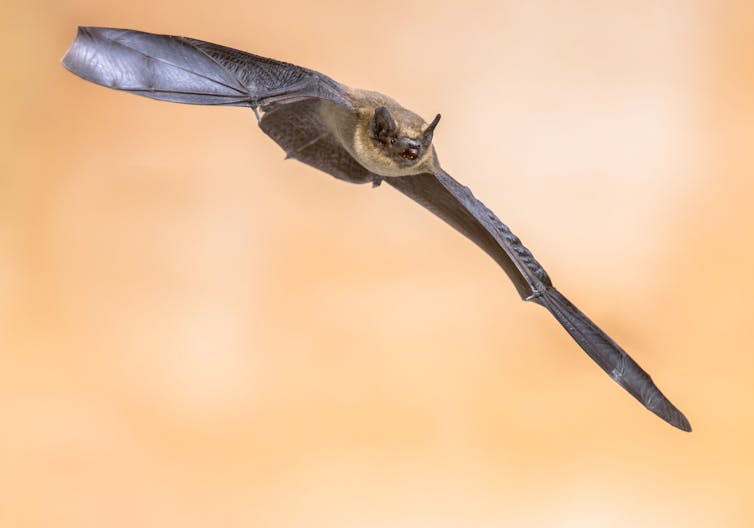
As our planet continues to warm, the need for renewable energy is becoming increasingly urgent. Almost half of the UK’s electricity now comes from renewable sources. And solar accounts for one-fifth of the energy capacity installed since 2019.
Solar farms are now a striking feature of the British landscape. But despite their growth, we’re still largely in the dark about how solar farms impact biodiversity.
This was the focus of a recent study that I co-authored alongside colleagues from the University of Bristol. We found that bat activity is reduced at solar farms compared to neighbouring sites without solar panels.
This discovery is concerning. Bats are top predators of nighttime insects and are sensitive to changes in their habitats, so they are important indicators of ecosystem health. Bats also provide valuable services such as suppressing populations of insect pests.
Nonetheless, our results should not hinder the transition to renewable energy. Instead, they should help to craft strategies that not only encourage bat activity but also support the necessary expansion of clean energy sources.
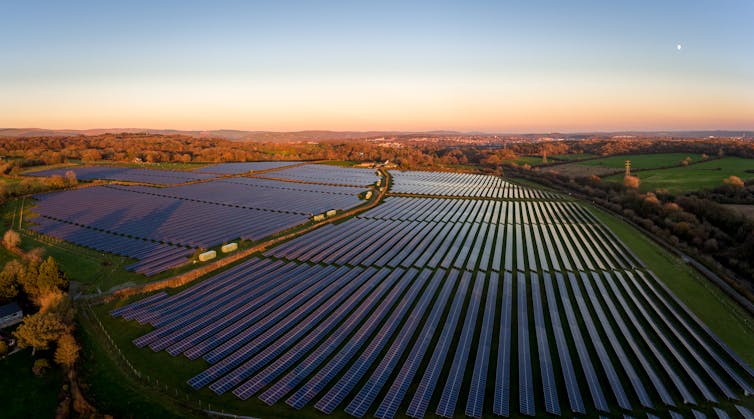
Reduced Activity
We measured bat activity by recording their ultrasonic echolocation calls on bat detectors. Many bat species have distinctive echolocation calls, so we could identify call sequences for each species in many cases. Some species show similar calls, so we lumped them together in species groups.
We placed bat detectors in a solar farm field and a similar neighbouring field without solar panels (called the control site). The fields were matched in size, land use and boundary features (such as having similar hedges) as far as possible. The only major difference was whether they contained solar panels.
We monitored 19 pairs of these sites, each for a week, observing bat activity within the fields’ centre and along their boundaries. Field boundaries are used by bats for navigation and feeding.
Six of the eight bat species or groups studied were less active in the fields with solar panels compared to the fields without them. Common pipistrelles, which made up almost half of all bat activity, showed a decrease of 40% at the edges of solar panel fields and 86% in their centre. Other bat species or groups like soprano pipistrelles, noctules, serotines, myotis bats and long-eared bats also saw their activity drop.
Total bat activity was almost halved at the boundaries of solar panel fields compared to that of control sites. And at the centre of solar panel fields, bat activity dropped by two-thirds.
Why Are Bats Avoiding Solar Farms?
Conflict between clean energy production and biodiversity isn’t just limited to solar farms; it’s an issue at wind farms too. Large numbers of bats are killed by colliding with the blades of wind turbines. In 2012, for example, one academic estimated that around 888,000 bats may have been killed at wind energy facilities in the United States.
The way solar farms affect bats is probably more indirect than this. Solar panels could, in theory, inadvertently reduce the abundance of insects by lowering the availability of the plants they feed on. We’re currently investigating whether there’s a difference in insect numbers at the solar farm sites compared to the control sites.
Solar panels may also reflect a bats’ echolocation calls, making insect detection more difficult. Reduced feeding success around the panels may result in fewer bats using the surrounding hedgerows for commuting, potentially explaining our findings.
However, bats are also known to collide with smooth vertical flat surfaces because they reflect echolocation calls away from bats and hence appear as empty space. Research has also found that bats sometimes attempt to drink from horizontal smooth surfaces because they interpret the perpendicular echoes as coming from still water. But, given the sloped orientation of solar panels, these potential direct effects may not be of primary concern.
Improving Habitats
An important lesson from the development of wind energy is that win-win solutions exist. Ultrasonic acoustic deterrents can keep bats away from wind turbines, while slightly reducing the wind speed that turbines become operational at (known as “cut-in speeds”) has reduced bat fatality rates with minimal losses to energy production. Research suggests that increasing turbine cut-in speeds by 1.5 metres per second can reduce bat fatalities by at least 50%, with an annual loss to power output below 1%.
A slightly different approach could be applied to solar farms. Improving habitats by planting native trees along the boundaries of solar farm fields could potentially increase the availability of insects for bats to feed on.
Research that I have co-authored in recent years supports this theory. We found that the presence of landscape features such as tall hedgerows and even isolated trees on farmland has a positive effect on bat activity.
Carefully selecting solar sites is also important. Prior to construction, conducting environmental impact assessments could indicate the value of proposed sites to bat populations.
More radically, rethinking the siting of these sites so that most are placed on buildings or in areas that are rarely visited by bats, could limit their impact on bat populations.
Solar power is the fastest-growing source of renewable energy worldwide. Its capacity is projected to overtake natural gas by 2026 and coal by 2027. Ensuring that its ecological footprint remains minimal is now particularly important.

Don’t have time to read about climate change as much as you’d like?
Get a weekly roundup in your inbox instead. Every Wednesday, The Conversation’s environment editor writes Imagine, a short email that goes a little deeper into just one climate issue. Join the 20,000+ readers who’ve subscribed so far.![]()
Gareth Jones, Professor of Biological Sciences, University of Bristol
This article is republished from The Conversation under a Creative Commons license. Read the original article.
‘Australia is sleepwalking’: a bushfire scientist explains what the Hawaii tragedy means for our flammable continent
David Bowman, University of TasmaniaAs I hear reports of the fire tearing through the Hawaiian island of Maui, I feel utterly depressed. As a fire scientist, I know the unfolding horror – which has killed 53 people so far – is just the beginning. It’s a portent of what Australia and other countries will experience in a warmer world.
For Australians, the reports inevitably bring back memories of our awful Black Summer in 2019-20. Like the Maui tragedy, those huge, uncontrollable bushfires were a terrifying glimpse of the intense fires we can expect as climate change worsens.
Global warming – the result of fossil fuel burning – means bushfires will become more frequent and severe. Of course, we must reduce greenhouse gas emissions. That is blindingly obvious.
But we must do more than that. Australians must urgently adapt to our fiery future.
Record-Breaking Heat And Fires
The Maui fires have been fuelled by strong winds, dry vegetation and low humidity. People were forced to run into the ocean for safety. Hundreds of structures have been damaged or ruined and many people are injured.
Hawaii is not the only part of the northern hemisphere being ravaged by fire.
In recent weeks, wildfires have ripped through through Canada, Greece, Spain, Portugal and elsewhere. At one point, 1,000 fires were burning in Canada alone.
The fires have in part been fuelled by record-high temperatures. In July, temperatures reached 53.3℃ at California’s Death Valley. In fact, July was Earth’s hottest month on record.
The southern hemisphere is also experiencing highly unusual conditions. Antarctica is struggling to freeze over; it’s reportedly missing a chunk of ice bigger than Greenland.
And Australia is experiencing an unseasonably warm winter. The country looks set for a hot, dry, El Nino-fuelled summer, putting fire crews on high alert.
Australians Must Heed The Warnings
Australia, too, is fast becoming a continent of more uncontrolled fire.
Let’s compare the period of 1988 to 2001, with the period 2002 to 2018. In Australian forests, the average annual burned area in the second period was 350% greater than in the first. If we include 2019 – the year the Black Summer fires began – the increase rises to 800%.
The Black Summer fires were started by lightning and human activity. They were fuelled by extreme heat, record low rainfall and widespread dieback of vegetation. It meant the fires burned at unprecedented intensity.
The Black Summer fires burned more than 24 million hectares nationally. Some 33 people were killed by the fires, more than 429 died from smoke-related effects, and more than 3,000 homes were destroyed.
The drying and warming that drove the Black Summer fires are linked to human-caused climate change. These changes are resulting in longer fire seasons and extended periods of drought.
As I watch the fires blazing in Hawaii, I’m constantly asking myself: when will Australians – who live on one of the most fire-prone continents on Earth – get a grip on this escalating global problem? How many more warning signs do we need?
What Must Be Done
When the bushfire royal commission handed down its report in October 2020, I described it as a “clarion call for change”. Finally, Australia had a map for its journey toward adapting to fires and other natural disasters.
The scope of the commission’s recommendations was vast. For governments alone, it called for changes across land-use planning, infrastructure, emergency management, social policy, agriculture, education, physical and mental health, community development, energy and the environment.
The commission also called for an acknowledgement of the role of Indigenous fire managers in mitigating bushfire risks.
Almost three years on, we haven’t seen the changes needed. We’re behaving as if we’ve got an endless amount of time. Australia is sleepwalking into our fiery future.
The pandemic shows humans are amazingly adaptable. We used an integrated approach to mitigate and adapt to that threat. We need an equivalent response to adapt to fire and climate change – but it’s just not happening.
There is much Australia can do to adapt to fire. We can improve our urban planning regimes and building standards. We can better manage fuel loads in our forests. We can increase our firefighting capacity and get much better at bushfire preparation and early warning systems.
And importantly, we should draw on Indigenous knowledge and the expertise of Aboriginal communities. These approaches could prove vital not only managing extreme fires in Australia, but elsewhere in the world.
Looking Ahead
One thing Australians can all agree on is that we don’t want catastrophically uncontrolled fires.
As our Black Summer showed, these fires not only destroy lives, homes and biodiversity. They actually threaten the Earth’s systems. Black Summer pumped huge amounts of carbon into the atmosphere. It depleted the ozone layer. It created an algal bloom in the Southern Ocean bigger than the Australian continent.
It’s vital that we slash greenhouse gas emissions as quickly as possible, to stabilise Earth’s climate. But that’s not sufficient. Australians have to adapt to fire, too.
The fires in Hawaii remind Australians that our summer is just around the corner. We don’t have much time.
This article has been amended to specify the exact date ranges of the comparison between forest areas burned before and after 2001.![]()
David Bowman, Professor of Pyrogeography and Fire Science, University of Tasmania
This article is republished from The Conversation under a Creative Commons license. Read the original article.
How climate change will affect your pet – and how to help them cope

Earth has just experienced its hottest month since records began and Australia is now gearing up for an El Niño-fuelled summer. Extreme heat isn’t just challenging for humans – it brings suffering to our beloved pets, too.
Research I was involved in examined how climate change affects the welfare of animals, including pets. My colleagues and I used a concept for assessing animal welfare known as the “five-domains model”. It’s a science-based structure for examining an animal’s:
- nutrition
- environment
- physical health
- behaviour
- mental state.
The model evaluates the complete physiological and behavioural responses of animals to environmental stressors. While the effects of climate change on animals have been studied before, ours is the first study to apply the model to animal welfare specifically.
We examined the academic literature and found climate change will harm animals across all five welfare domains. This applies to both wild and domesticated animals, including pets. So let’s take a look at how various types of pets will fare in a warming world – and how we can help them.

Fish
Fish are “ectotherms” – that is, they use external sources of heat to regulate their body temperature. So pet fish are vulnerable to changes in the water temperature of your home aquarium, which may occur during a heatwave.
Extreme water temperatures can cause physical harm to fish. For example, it can increase a fish’s metabolic rate – meaning it needs more oxygen to breathe . It can also cause changes such as slowed growth and reduced feeding.
According to official advice, water in an indoor aquarium should generally be kept at between 20℃ and 25℃ (unless you are keeping tropical fish).
Depending on your budget and aquarium size, you could opt to use a device to control the water temperature. Either way, it’s important to monitor the water temperature regularly.
Also make sure the aquarium isn’t located near a window where it’s exposed to direct sunlight.
Leaving your aquarium unattended for days or weeks in summer can be dangerous, due to the risk of heatwaves. If you’re going on a summer holiday, consider organising a fish sitter to check on the animal regularly.

Birds
Heat stress can change the physiology of birds. For example, research into a wild population of small Australian robins showed during a heatwave, the birds lost body mass and abandoned their nests, and some died.
Heat stress can also cause abnormal behaviour in pet birds such as feather picking, when one bird repeatedly pecks at the feathers of another.
In hot weather, regularly check your bird’s cage to make sure it’s clean and stocked with food and water. If the bird is in an outdoor cage or aviary, ensure it is shaded. And a shallow bird bath will help your feathered friend cool off.

Dogs
Dogs and cats can suffer on hot days. That’s especially true if they are:
- older or overweight
- have thick coats
- have short snouts/flat faces (which restricts air flow and makes it harder for them to cool down).
Heat stress can cause canine hyperthermia, which means the dog’s body temperature becomes dangerously hot.
Watch for early warning signs of heat stress such as excessive panting and erratic movements. These symptoms can quickly escalate, leading to heat stroke and possible death.
More than 80% of dog owners report exercising their dogs less vigorously, or for shorter periods, during hot weather. That can help avoid heat-related illness. But don’t reduce your dog’s activity levels too much, as that may lead to other health problems. Just time the walks to avoid the heat of the day.
Refrain from leaving dogs unattended in vehicles, because they can easily overheat. In fact, it’s better to leave your dog inside home on a hot day, as long as they have a cool place to rest and plenty of water – perhaps even with ice cubes in it. And dogs love to cool off in a kiddie pool or under a sprinkler.
If you take your dog out on a hot day, carry a container of fresh, cool water for them. And don’t forget to slip-slop-slap: apply a sparing amount of pet sunscreen to your dogs’ exposed pink skin such as ear tips and nose.

Cats
Like other animals, cats can overheat in hot weather. Symptoms include panting heavily, drooling and a rapid pulse. Like with other animals, if you suspect your cat is suffering from heatstroke, call a vet immediately.
Climate change and associated heat and floods is likely to aid the spread of parasites and illness including tick-borne diseases, flea infestations and heartworm. This puts both cats and dogs at risk.
In hot weather, the advice for cat owners is similar to that of dog owners: ensure your cat has plenty of shade and water, and put pet sunscreen on their ear tips and noses, especially if the cat is white.
If possible, keep the cat inside during the hottest part of the day. Ensure at least one room is cool and ventilated. And in a heatwave, play with your cat either in the early morning or evening, when the temperature has cooled.
A Helping Human Hand
While humans have the capacity to understand and prepare for climate change, pets will need our help to cope. This includes not just the pets listed above, but others too, including reptiles, guinea pigs and rabbits.
As heatwaves and other extreme weather events become more common, the onus is on us to keep our pets safe.![]()
Edward Narayan, Senior Lecturer in Animal Science, The University of Queensland
This article is republished from The Conversation under a Creative Commons license. Read the original article.
Darwin’s ‘sustainable’ Middle Arm project reveals Australia’s huge climate policy gamble
Timothy Neale, Deakin University; Kari Dahlgren, Monash University, and Matthew Kearnes, UNSW SydneyProtesters rallied at Parliament House in Canberra on Tuesday, railing against Darwin’s controversial Middle Arm venture which critics say would benefit the gas industry.
The project has been thrust into the headlines of late. Northern Territory Chief Minister Natasha Fyles drew the ire of critics last week in a speech to the National Press Club where she insisted her government was “not for turning” on the project.
Fyles describes Middle Arm as a “sustainable development precinct”. But that claim is highly questionable. The site is already home to two gas facilities, and more are planned. Meanwhile, the NT is pursuing a goal of net zero emissions by 2050 and has committed to “no net increase” in emissions from fracking. So what’s going on?
It comes down to a new buzz-term in policymaking: “circular economy”. We’ve heard it applied to realms such as plastics and food waste. It’s increasingly being applied to carbon emissions, to describe an imagined scenario where carbon released from one source is used or stored by others to create a “closed loop” system.
But as our new research finds, this path is a massive gamble. Such offsetting relies on projects and technologies that do not yet exist, or are not yet feasible at scale. In effect, the Middle Arm project, and others like it, are grand experiments with our climate.
The ‘Circular’ Economy
Over the past two decades, international climate policy has increasingly shifted towards a circular model of managing carbon emissions. We’ve seen this happening not just in Australia, but places such as Canada, the United Kingdom, the European Union and Saudi Arabia.
The strategy doesn’t seek to reach net-zero simply by pumping less carbon into the atmosphere – for example, by deploying renewable energy. It also involves activities that remove, capture, store or use carbon, therefore “offsetting” or cancelling out emissions from other sources.
Proponents of the strategy characterise it as a simple matter of inputs (emissions) and outputs (offsets) cancelling each other out. But implementing the model is actually very messy, as our new paper shows.
We analysed how the federal and NT governments have sought to implement circular carbon policies, including through the Middle Arm development.
Due to its existing gas infrastructure and proximity to Darwin, this peninsula has long been the target of grand development plans. In July 2020, the NT government announced it would create an industrial petrochemical precinct there to use gas from the Beetaloo and offshore fields.
The following year, the hub was rebranded as a “sustainable development precinct”. References to “petrochemicals” were abandoned. The NT government now frequently talks up the site’s potential for hydrogen and carbon-capture facilities, and says the precinct will be:
largely powered by renewables, master-planned to achieve a circular economy approach of sustainable and responsible production and will use technology to achieve low-to-zero emissions.
The federal government has committed more than A$1.5 billion to the development.
‘Sustainable’ Claims Called Into Question
There are serious doubts over Middle Arm’s environmental credentials.
For example, internal government documents make clear the precinct is “seen as a key enabler” of the gas industry.
One confirmed future tenant will be Tamboran Resources, which plans to frack and drill for gas in the Beetaloo Basin. Tamboran intends to build a gas plant in the precinct. Federal crossbenchers, including Warringah MP Zali Steggall, have questioned why public money is being spent on infrastructure “for a private gas company to make record profits from exports”.
What’s more, low-emissions projects planned for the precinct rely on highly speculative technologies.
A carbon-capture and storage facility has been mooted at the site. Announcing the project in 2021, the NT government called it a “a game-changer”. But it neglected to mention that the project relies on unproven technology and has no timeline or guarantee of delivery.
For examples of this, we need only look to Chevron’s Gorgon gas project in Western Australia. The project was supposed to capture at least 80% of CO₂ from the gas it produces. After a three-year delay, carbon capture and storage began in 2019 but has consistently failed to reach its targets.
Claims that Middle Arm would substantially be powered by renewable energy are also in doubt. The Sun Cable solar project – once billed as the largest solar energy development in the southern hemisphere – was planning a battery at the site. But in 2023 the company went into administration and its future is unclear.
Questions also surround Middle Arm’s two proposed green hydrogen projects. Neither company involved has ever built a green hydrogen facility. One of the companies, Total Eren, intends to use solar energy from a facility that has not yet been assessed let alone approved for construction.
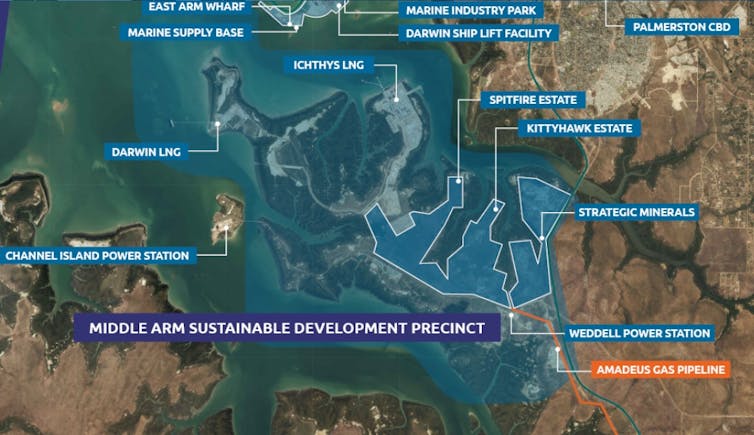
Offsets Won’t Save Us, Either
As part of its “decarbonisation” plan, the NT is set to grow its carbon offset industries.
And in 2021, the then Coalition government released a climate plan in which more than half the carbon savings would be achieved via carbon offsets, as well as unspecified “technology breakthroughs”.
Carbon offsets are used by polluters to compensate for their emissions. It involves buying “carbon credits” from organisations that have undertaken activities to reduce emissions.
Carbon offsets are contentious because they allow companies to keep pumping out carbon. And ensuring carbon credits represent genuine emissions reduction can be difficult.
We’ve seen this in Australia, where the integrity of certain carbon methods has been questioned. An independent review of the overall scheme concluded it was essentially sound, but critics say key questions remain. Further, there are signs we do not have enough credits to meet market demand.
Looking Ahead
The goal of Australian governments to reach net-zero emissions by 2050 increasingly relies on gambits such as the Middle Arm precinct and speculative methods for offsetting and burying emissions.
Meanwhile, the world has just experienced its hottest month on record. And in temperate Australia, a hot, dry El Nino summer is approaching.
At a time like this, we must focus on achieving genuine emissions reductions, rather than playing risky games with our climate. ![]()
Timothy Neale, Senior Research Fellow, Deakin University; Kari Dahlgren, Research Fellow Emerging Technologies Research Lab, Monash University, and Matthew Kearnes, Professor, Environment & Society, School of Humanities and Languages, UNSW Sydney
This article is republished from The Conversation under a Creative Commons license. Read the original article.
Maui’s deadly wildfires burn through Lahaina – it’s a reminder of the growing risk to communities that once seemed safe

Wildfires, pushed by powerful winds, raced through Lahaina, Hawaii, on Aug. 8 and 9, 2023, leaving a charred and smoldering landscape across the tourist town of about 13,000 residents that was once the capital of the Kingdom of Hawaii. At least 67 people died, Maui County officials said. Others were rescued by the U.S. Coast Guard after going into the ocean to escape the flames.
Dry grasses and strong winds, influenced by Hurricane Dora passing far to the south, heightened the risk as wildfires burned both in Maui’s tourist-filled west coast and farther inland and on the Big Island of Hawaii.
Most fires in the U.S. are suppressed before they have a chance to threaten communities, but the winds were too strong to send helicopters into the sky to help contain Maui’s fires on the first day, leaving firefighters to battle the blazes from the ground.
Lt. Gov. Sylvia Luke issued an emergency declaration, activating the National Guard to help, and urged travelers to stay away.
Fires have become an increasing risk in many areas of the U.S. that people once considered safe.
Over the past two decades, a staggering 21.8 million Americans found themselves living within 3 miles (5 kilometers) of a large wildfire. Nearly 600,000 of them were directly exposed to the fire, with their homes inside the wildfire perimeter. That number – people directly exposed to wildfires – more than doubled from 2000 to 2019, my team’s recent research shows.
But while commentators often blame the rising risk on homebuilders pushing deeper into the wildland areas, we found that the population growth in these high-risk areas explained only a small part of the increase in the number of people who were exposed to wildfires.
Instead, three-quarters of this trend was driven by intense fires growing out of control and encroaching on existing communities.
That knowledge has implications for how communities prepare to fight wildfires in the future, how they respond to population growth and whether policy changes such as increasing insurance premiums to reduce losses will be effective.
What Climate Change Has To Do With Wildfires
Hot, dry weather pulls moisture from plants and soil, leaving dry fuel that can easily burn. On a windy day, a spark from a power line, campfire or lightning can start a wildfire that quickly spreads.
Recent research on California’s fires found that almost all of the increase in that state’s burned area in recent decades was due to anthropogenic climate change – meaning climate change caused by human activities.
Our new research looked beyond just the area burned and asked: Where were people exposed to wildfires, and why?
Where Wildfire Exposure Was Highest
I am a climate scientist who studies the wildfire-climate relationship and its socioenvironmental impacts. Colleagues and I analyzed the boundaries of more than 15,000 large wildfires across the lower 48 states and annual population distribution data to estimate the number of people exposed to those fires.
If you picture wildfire photos taken from a plane, fires generally burn in patches rather than as a wall of flame. Pockets of homes within the fire boundary survive, but many also burn.
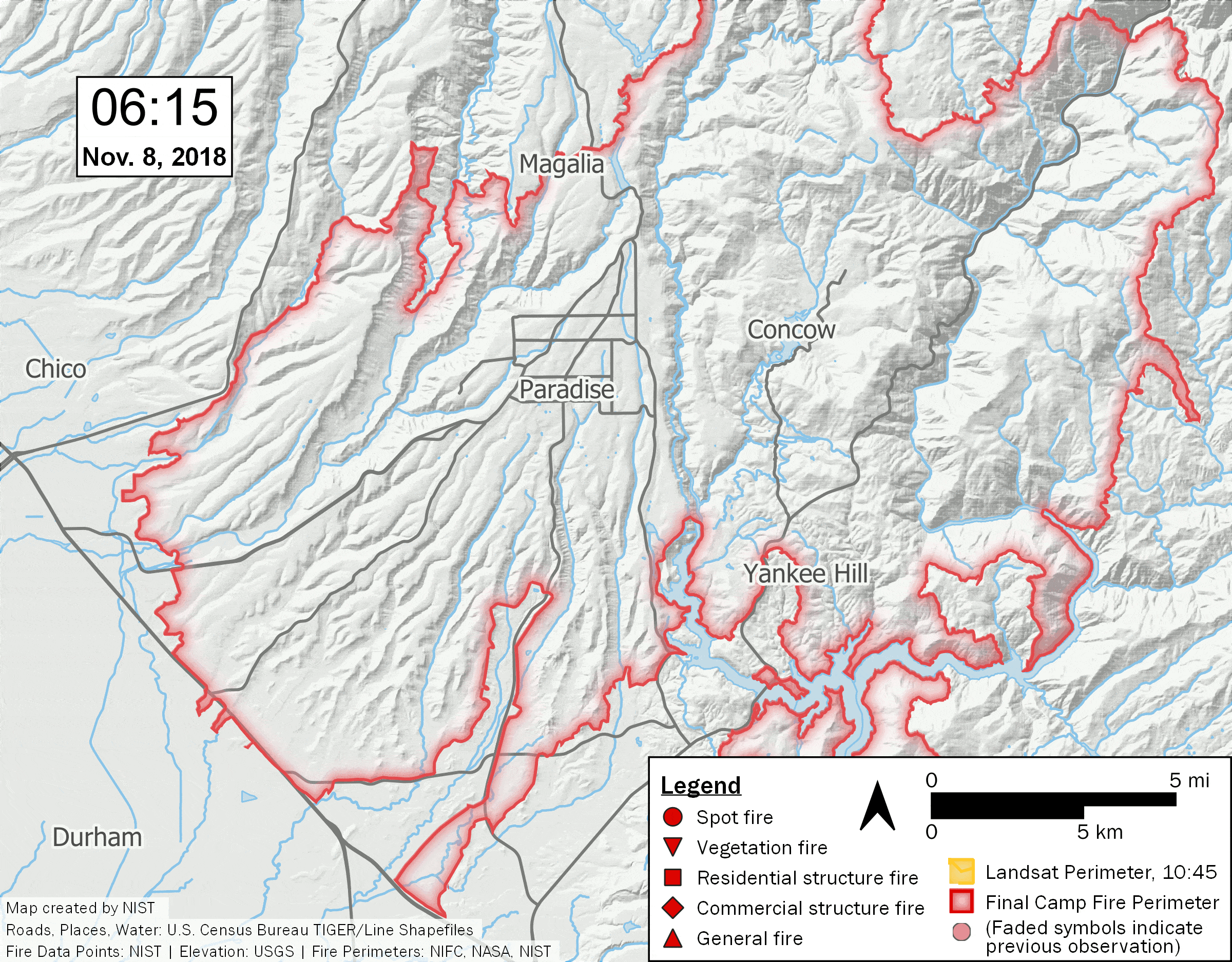
While the population has grown in the wildland-urban interface – the region where houses intermingle with forests, shrublands or grasslands – we found that population growth accounted for only about one-quarter of the increase in the number of humans directly exposed to wildfires across the lower 48 states from 2000 to 2019.
Three-quarters of the 125% increase in exposure was due to fires increasingly encroaching on existing communities. The total burned area increased only 38%, but the locations of intense fires near towns and cities put lives at risk.
In California, the state with the most people exposed to fires, several wildfire catastrophes hit communities that had existed long before 2000. Almost all these catastrophes occurred during dry, hot, windy conditions that have become increasingly frequent because of climate change.

What Communities Can Do To Lower The Risk
Studies have shown that even in conservative scenarios, the amount of area that burns in Western wildfires is projected to grow in the next few decades.
How much these fires grow and how intense they become depends largely on warming trends. Reducing greenhouse gas emissions will help slow warming. But communities will also have to adapt to more wildfires. Developing community-level wildfire response plans, reducing human ignitions of wildfires and improving zoning and building codes can help prevent fires from becoming destructive.
This article was updated Aug. 10, 2023, with a rising death toll. This is an update to an article originally published July 3, 2023.![]()
Mojtaba Sadegh, Associate Professor of Civil Engineering, Boise State University
This article is republished from The Conversation under a Creative Commons license. Read the original article.
Pause In Recent Coral Recovery On Much Of Great Barrier Reef
- Northern region (north of Cooktown) -- 35.7%, down from 36.5% last year;
- Central region (Cooktown to Proserpine) -- 30.8%, down from 32.6%;
- Southern region (south of Proserpine) -- 33.8%, down from 33.9%.
_CopyrightAIMS_2023.jpg?timestamp=1691562432060)
Is the Great Barrier Reef reviving – or dying? Here’s what’s happening beyond the headlines
Mike Emslie, Australian Institute of Marine Science; Daniela Ceccarelli, Australian Institute of Marine Science, and David Wachenfeld, Australian Institute of Marine ScienceThe Great Barrier Reef is not dead. Nor is it in good health. The truth is complex. To understand what’s going on takes more than a headline.
For the last 37 years, our organisation has monitored the health of the world’s largest reef. Each year, we add our findings to our dataset, the Reef’s longest running and largest coverage. This lets us produce annual updates for the northern, central and southern regions of the Reef. That makes us perhaps the team best qualified to answer the question many people have – how is the Reef going?
Released today, this year’s update paints a complex picture. It wasn’t long ago the Great Barrier Reef was reeling from successive disturbances, ranging from marine heatwaves and coral bleaching to crown-of-thorns starfish outbreaks and cyclone damage, with widespread death of many corals especially during the heatwaves of 2016 and 2017.
Since then, the Reef has rebounded. Generally cooler La Niña conditions mean hard corals have recovered significant ground, regrowing from very low levels after a decade of cumulative disturbances to record high levels in 2022 across two-thirds of the reef.
The Reef has shown an impressive ability to recover from widespread disturbances, when it gets a chance – it’s not all just bleaching and death. But it’s also true we’re heading towards a future where hotter water temperatures will likely cause bleaching every year, along with ongoing threats of cyclones and coral-eating starfish. Recovery requires reprieve – and those opportunities will diminish as climate change progresses.
Last year, for instance, parts of the Reef experienced bleaching in the middle of La Niña – the first time that’s happened on record.

What’s Happening On The Reef?
To take the pulse of the Great Barrier Reef, one indicator we use is hard coral cover. It’s a widely used, robust indicator of reef health, but it doesn’t tell the whole story. We also collect detailed data on coral and fish populations, diversity, structural complexity, and abundance of juvenile corals. And we take digital photographs and convert them into 3D photogrammetry models so we can analyse what’s happening in more depth than ever before.
Here’s what our analysis shows.
Over the last few years, the Reef was mostly in La Niña conditions. That gave the hard-hit northern and central parts of the reef a chance to begin recovery. Many reefs had a high proportion of Acropora corals, of which the best known are the staghorn and plate corals. These species have been a vital part of the reef over 37 years of monitoring – and probably for millennia.
These corals are the most common on many reefs, and grow fast. Because of that, they tend to dominate trends in hard coral cover.
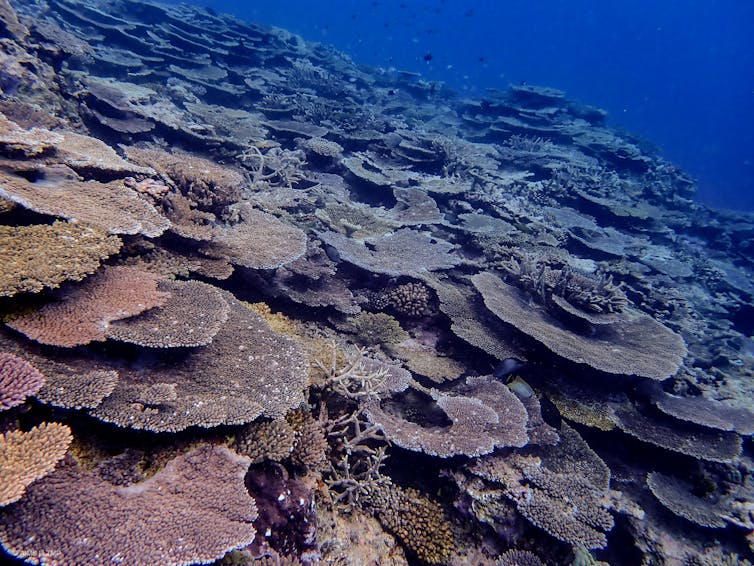
Does this mean the Great Barrier Reef’s recovery in 2022 relied on “weedy” corals which are taking over? Yes and no. The natural ecological niche of Acropora corals has always been to rapidly fill empty space, which means it tends to dominate trends in coral recovery.
Again, the story is more complicated than the headlines. Some reefs have recovered strongly, some very little. Some reefs are recovering with less Acropora than before, some with more. Each reef is charting its own course on the journey from impact to recovery and back again.
Overall, the record high hard coral cover seen last year was welcome news, representing recovery across much of the Reef in the absence of common coral killers.
But What About Recent Heating?
This year, the rapid coral rebound paused. Some reefs continued to recover, but these were offset by others which lost coral. Coral loss came from effects of the 2022 bleaching event in northern and central regions, crown-of-thorns starfish predation in the northern and southern regions, damage from Tropical Cyclone Tiffany in the north and coral disease in some areas of the south.
The picture is complex. Recovery here, fresh losses there.
While the recovery we reported last year was welcome news, there are challenges ahead. The spectre of global annual coral bleaching will soon become a reality.
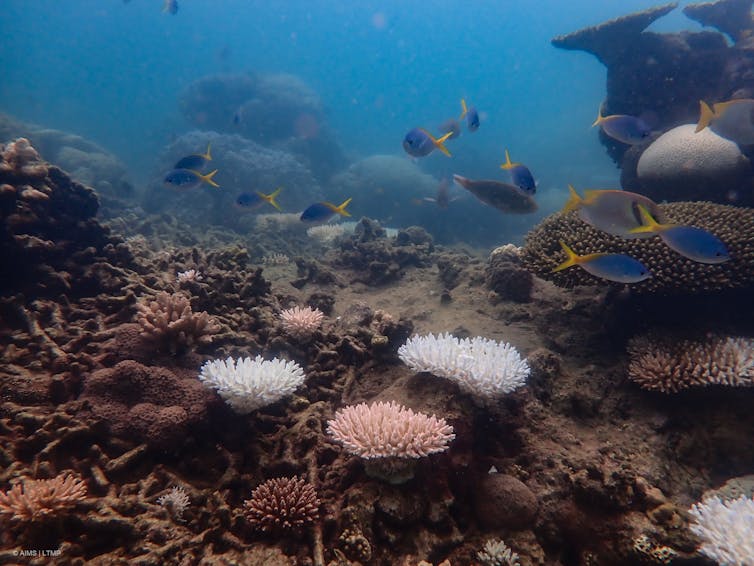
Right now, marine heatwaves are sweeping through ocean basins in the northern hemisphere. Sea surface temperatures are far above long term averages.
At least eight countries are reporting coral bleaching, including the United States and Belize. This summer, it looks likely we’ll see our first El Niño on the Great Barrier Reef since 2016, bringing higher sea surface temperatures. That last El Niño – coupled with global heating – was the direct cause of the 2016–17 mass bleaching and mass death of corals.
The prognosis is, in short, extremely concerning. Yes, the Reef has rebounded beyond our expectations. But now the heat is back on. If we get mass bleaching like 2016 – or even worse – it could undo all the recent recovery.
![]()
Mike Emslie, Senior Research Scientist, Australian Institute of Marine Science; Daniela Ceccarelli, Research fellow, Australian Institute of Marine Science, and David Wachenfeld, Research Program Director- Reef Ecology and Monitoring, Australian Institute of Marine Science
This article is republished from The Conversation under a Creative Commons license. Read the original article.
Controversial ‘forever chemicals’ could be phased out in Australia under new restrictions. Here’s what you need to know

There’s growing global concern about potential risks to human health and the environment from a group of industrial chemicals commonly known as PFAS, or “forever chemicals”.
While the full extent of harm from PFAS is still emerging, the fact these chemicals persist in the environment and accumulate in the body is alarming enough. Some scientists believe they will never break down.
Until now, Australia has not restricted the trade or use of most PFAS chemicals. But that’s about to change.
The federal government intends to stop the import, manufacture and use of some types of PFAS within two years. We want to raise awareness and encourage industry to be proactive about finding alternatives. The sooner industry acts on this, the faster we can eliminate PFAS from the products we use and our waste. With untold benefits for people and our planet.
Hang On, What Is PFAS Again?
PFAS (or per- and poly-fluoroalkyl substances) are a group of around 9,000 individual chemical compounds found in many everyday products.
These complex substances are made by joining carbon and fluorine atoms, creating one of the strongest bonds in organic chemistry. As a result, they are stain-resistant, water-resistant, grease-resistant and heat-resistant. That makes them enormously useful in products such as food packaging, non-stick cookware, semiconductors and other electronics, refrigerants, stain or waterproof textiles and cosmetics. PFAS has even been found in toilet paper.
But PFAS chemicals also appear to be toxic. They have been linked to a range of human and environmental health problems.
The use of potentially hazardous chemicals such as PFAS also undermines recycling and the circular economy. Compost made from food and garden organics may be contaminated through packaging and other sources. PFAS in sewage also challenges the use of biosolids as fertiliser on farms.
What Is Changing And What Will This Mean?
The federal government recently reviewed the industrial chemical regulatory frameworks protecting human and environmental health. As a result, the federal, state and territory governments established the new Australian Industrial Chemical Environmental Management Standard in 2021.
Chemicals with industrial applications are placed into one of seven categories or “schedules”, according to the level of environmental risk they represent. The standard sets out the measures required to manage such risks.
Schedule 7 is reserved for industrial chemicals likely to cause serious or irreversible harm to the environment.
Last month, the federal Department of Climate Change, Energy, the Environment and Water announced its intention to regulate three groups of PFAS chemicals and pentachlorobenzene (PeCB) under Schedule 7.
This means businesses will have to stop importing, manufacturing or using these PFAS groups, either as bulk chemicals or in consumer products.
Schedule 7 also states “no essential uses”. This means the chemicals cannot be used, even when it is necessary for the health, safety or functioning of society, or when there are no other available alternatives.
The timing of the proposed Australian restrictions aligns with the EU phase-out. The United States and Canada are also pursuing similar action.
Increasingly, countries are pursuing coordinated regulatory actions that will shift market standards around industrial chemical use and management.
What Should Business Do?
At this stage, research indicates low levels of industry awareness and action globally. Industry risks being caught short, facing the economic and administrative consequences of compliance when new rules come into effect.
Phasing out potentially hazardous chemicals such as PFAS will require careful consideration of both risk and technical function. In many cases, products have been designed around these chemicals. This means substitutions will need to be found. However, businesses also need to be aware of the potential for “regrettable substitution”, where a potentially hazardous chemical is replaced by a similar, but lesser-known chemical that also threatens human health and the environment.
There are some tools available to help find safe alternatives. For example, the European non-government organisation ChemSec has compiled a database of hazardous chemicals that are likely to be regulated in future, if not already, and a marketplace for safe substitutions.
In some cases, avoiding regrettable substitution will necessitate rethinking how the function of a product can be delivered in an entirely new way.
Market-leading businesses are experimenting with recent advances in engineering, material sciences, and technology to redesign products without hazardous chemicals.
For example, outdoor-wear companies have redesigned textiles to deliver waterproof products without PFAS chemicals. The North Face has started using an advanced material called “FUTURELIGHT”, which uses nanotechnology to create a waterproof nano-fibre structure. Helly Hansen introduced “Lifa Infinity Pro” that uses advanced textile engineering to create a hydrophobic (water-hating) material, without having to add chemicals.
Emerging new services design-out problematic products entirely. For example, reusable food packaging services, intended to address the environmental impacts of single-use-packaging, generally use reusable materials such as stainless steel that do not require hazardous chemicals to function.
In support of industry action, governments industry, universities and non-governmental organisations are helping support better chemical management. For example, ChemSec has convened an Investor Initiative on Hazardous Chemicals to help reduce the impacts of hazardous chemicals, while also reducing financial risks to investors. Or in Australia, the Product Stewardship Centre of Excellence is providing tools for business and government to ensure safe, clean supply chains.
Governments also have a role to play in helping business transition away from hazardous chemicals. They can encourage business to take a whole-of-system approach to reducing chemicals across supply chains. This might involve tracking and tracing mechanisms, certification and labelling, or supporting research into safer alternatives.
The Department of Climate Change, Energy, the Environment and Water is inviting feedback on the proposed scheduling decisions before submissions close on September 1 this year. The government says feedback will help Australian governments and businesses to better manage the environmental risks of these chemicals.![]()
Sarah Wilson, PhD Candidate in Nanotechnology & Innovation Governance, University of Technology Sydney and Rachael Wakefield-Rann, Senior Research Consultant, Institute for Sustainable Futures, University of Technology Sydney
This article is republished from The Conversation under a Creative Commons license. Read the original article.
The Kimba nuclear waste plan bites the dust. Here’s what went wrong and how to do better next time
Ian Lowe, Griffith UniversityThe federal government has scrapped plans to build the nation’s first radioactive waste storage facility on farmland near Kimba in South Australia. Frankly, it was never going to work. The plan was doomed from the start.
That’s because the “decide and defend” model, where a government decides to put radioactive waste somewhere and then attempts to defend it against the community, hasn’t worked anywhere. It hasn’t worked in the United Kingdom. It hasn’t worked in the United States. Those countries still don’t have any process for long-term management of radioactive waste.
The only country to successfully manage the process is Finland, where the community was engaged. Over a period of several years, the government worked with its people to find a place where the community as a whole was happy to have the radioactive waste, in return for compensation. They’re now building a deep underground repository for permanently storing their radioactive waste.
But Australia’s national government has made the same mistake three times now: a proposal in the Woomera area 20 years ago, Muckaty station in the Northern Territory ten years ago and now Napandee near Kimba. Deciding on a site and then trying to defend it against the community doesn’t work. The government really needs to understand this. The only way to manage our radioactive waste is to engage the community from the start. That means the whole community, including the land’s traditional owners.
Stacking The Deck
The Federal Court last month ruled against plans by the former Coalition government to build the Kimba facility, after a court challenge by the traditional owners, the Barngarla people.
The traditional owners had not been consulted – in fact they were specifically excluded from the consultation process. And that’s why the Federal Court overturned the decision.
On Thursday morning, Federal Resources Minister Madeleine King told the House of Representatives she would not challenge the Federal Court decision.
She described Kimba as “a town divided” and emphasised broad community support would have included “the whole community, including the traditional owners of the land”.
But she also drew attention to flaws in the plan, saying:
The previous Government sought to temporarily store intermediate level radioactive waste on agricultural land and contemplated the double handling of the transport of this waste; first from Lucas Heights in NSW, to temporary storage in SA, then on to an undetermined permanent disposal site.
This approach has raised concerns regarding international best practice and safety standards.
King noted the amount of radioactive waste will keep growing, and said her department has begun work on alternative proposals.
Consulting Traditional Owners Is Crucial
The Barngarla people understandably objected to nuclear waste being imposed on their land without their prior informed consent.
It might have been possible for the federal government to persuade them to accept low-level waste, which is given that classification because it has relatively low levels of radiation. If buried under a few metres of earth, the radiation reaching the surface is not much above normal background levels.
But the decision to use the site for temporary storage of the intermediate level waste from the Lucas Heights reactor in New South Wales was unlikely to get their approval.
And that raises a quite fundamental issue. Anywhere we want to store radioactive waste in Australia is the traditional land of a group of Indigenous people. Given the history of the Menzies government allowing nuclear weapons to be tested here and the impacts that had on Indigenous people, it’s going to be very difficult to persuade Indigenous people to allow the permanent storage of radioactive waste on their land.
If it’s going to happen, it will require a long process of engagement and communication with Indigenous people to find a group somewhere that’s happy to manage the radioactive waste the community is producing.
What Should Happen Next?
The vast majority (97%) of the nuclear waste produced in this country is coming from Australia’s Nuclear Science and Technology Organisation (ANSTO), the research reactor at Lucas Heights in Sydney.
The idea of shifting intermediate-level waste from Lucas Heights to another temporary store 1,700km away is particularly silly. The waste is quite nasty stuff that requires serious management. There’s no obvious reason it would have been better in a temporary store at Kimba than in the current temporary store of Lucas Heights.
People have accepted it at Lucas Heights. The sensible approach would be to leave it there until we find somewhere people are happy to have it permanently.
In the fine print of the AUKUS agreement, the Australian government has agreed to manage the radioactive waste from nuclear submarines sourced from the UK and the US. That raises a much more difficult issue.
The Virginia class submarines use highly enriched uranium, which is weapons-grade material. It produces a more complex and intractable set of waste products than what’s produced at Lucas Heights. I’m not sure how many people understand Australia has taken that task on.
Looking Ahead
Naturally, anti-nuclear campaigners welcomed this week’s announcement. But they also held out an olive branch to the federal government, recognising the waste problem hasn’t gone away.
The Australian Conservation Foundation campaigner Dave Sweeney said:
ACF looks forward to constructive dialogue with the Albanese government to help develop a new and responsible approach to radioactive waste management in Australia.
Similarly, Conservation SA chief executive Craig Wilkins said:
Now that the Kimba plan is officially dumped, the real work can finally begin to find a more credible and respectful approach to identifying a long-term storage and disposal site for Australia’s nuclear waste that is consistent with international best practice.
Ian Lowe, Emeritus Professor, School of Environment and Science, Griffith University
This article is republished from The Conversation under a Creative Commons license. Read the original article.
The heroic effort to save Florida’s coral reef from devastating ocean heat
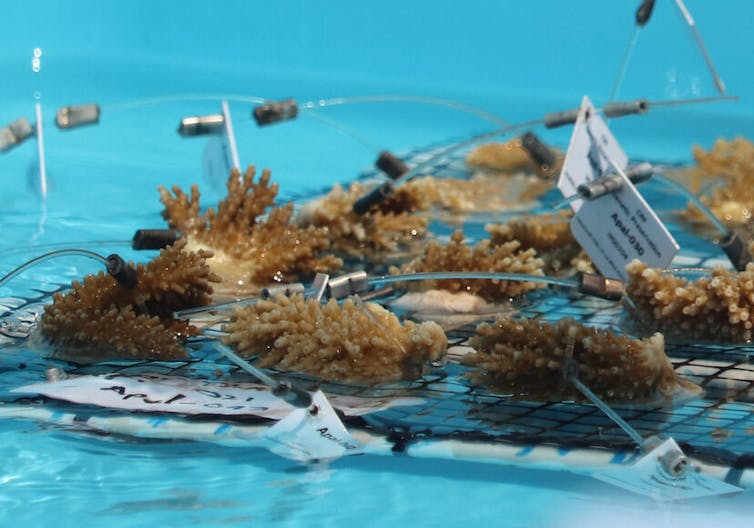
Armed with scrub brushes, young scuba divers took to the waters of Florida’s Alligator Reef in late July to try to help corals struggling to survive 2023’s extraordinary marine heat wave. They carefully scraped away harmful algae and predators impinging on staghorn fragments, under the supervision and training of interns from Islamorada Conservation and Restoration Education, or I.CARE.
Normally, I.CARE’s volunteer divers would be transplanting corals to waters off the Florida Keys this time of year, as part of a national effort to restore the Florida Reef. But this year, everything is going in reverse.
As water temperatures spiked in the Florida Keys, scientists from universities, coral reef restoration groups and government agencies launched a heroic effort to save the corals. Divers have been in the water every day, collecting thousands of corals from ocean nurseries along the Florida Keys reef tract and moving them to cooler water and into giant tanks on land.
Marine scientist Ken Nedimyer and his team at Reef Renewal USA began moving an entire coral tree nursery from shallow waters off Tavernier to an area 60 feet deep and 2 degrees Fahrenheit (1.1 Celsius) cooler. Even there, temperatures were running about 85 to 86 F (30 C).
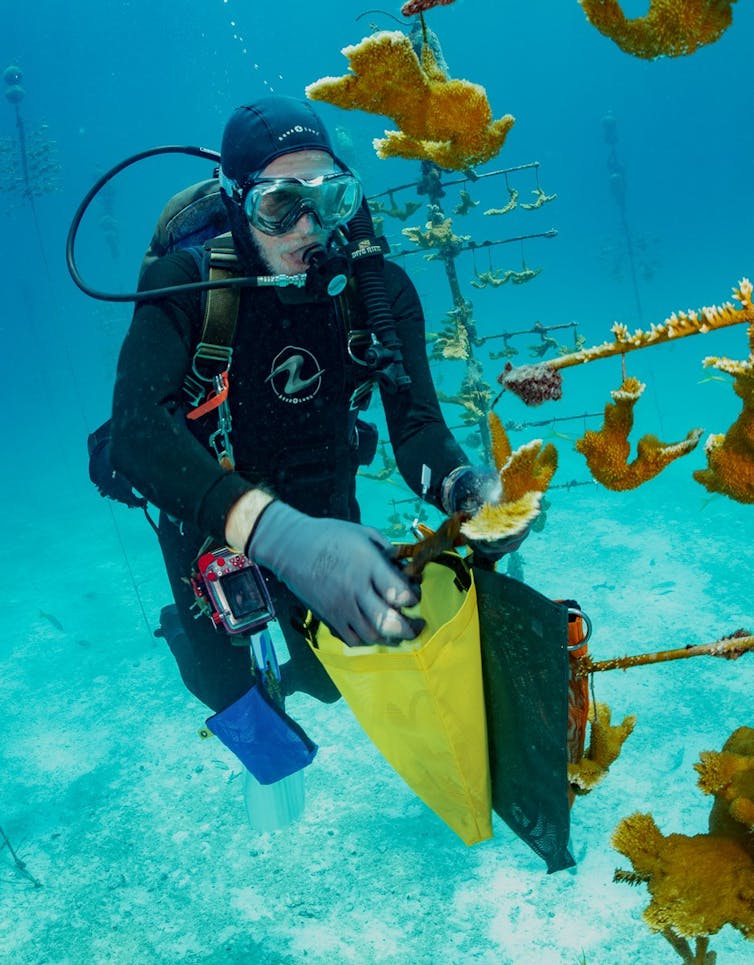
Their efforts are part of an emergency response on a scale never before seen in Florida.
The Florida Reef – a nearly 350-mile arc along the Florida Keys that is crucial to fish habitat, coastal storm protection and the local economy – began experiencing record-hot ocean temperatures in June 2023, weeks earlier than expected. The continuing heat has triggered widespread coral bleaching.

While corals can recover from mass bleaching events like this, long periods of high heat can leave them weak and vulnerable to disease that can ultimately kill them.
That’s what scientists and volunteers have been scrambling to avoid.
The Heartbeat Of The Reef
The Florida Reef has struggled for years under the pressure of overfishing, disease, storms and global warming that have decimated its live corals.
A massive coral restoration effort – the National Oceanic and Atmospheric Administration’s Mission: Iconic Reef – has been underway since 2019 to restore the reef with transplanted corals, particularly those most resilient to the rising temperatures. But even the hardiest coral transplants are now at risk.
Reef-building corals are the foundation species of shallow tropical waters due to their unique symbiotic relationship with microscopic algae in their tissues.
During the day, these algae photosynthesize, producing both food and oxygen for the coral animal. At night, coral polyps feed on plankton, providing nutrients for their algae. The result of this symbiotic relationship is the coral’s ability to build a calcium carbonate skeleton and reefs that support nearly 25% of all marine life.
Unfortunately, corals are very temperature sensitive, and the extreme ocean heat off South Florida, with some reef areas reaching temperatures in the 90s, has put them under extraordinary stress.

When corals get too hot, they expel their symbiotic algae. The corals appear white – bleached – because their carbonate skeleton shows through their clear tissue that lack any colorful algal cells.
Corals can recover new algal symbionts if water conditions return to normal within a few weeks. However, the increase in global temperatures due to the effects of greenhouse gas emissions from human activities is causing longer and more frequent periods of coral bleaching worldwide, leading to concerns for the future of coral reefs.
A MASH Unit For Corals
This year, the Florida Keys reached an alert level 2, indicating extreme risk of bleaching, about six weeks earlier than normal.
The early warnings and forecasts from NOAA’s Coral Reef Watch Network gave scientists time to begin preparing labs and equipment, track the locations and intensity of the growing marine heat and, importantly, recruit volunteers.
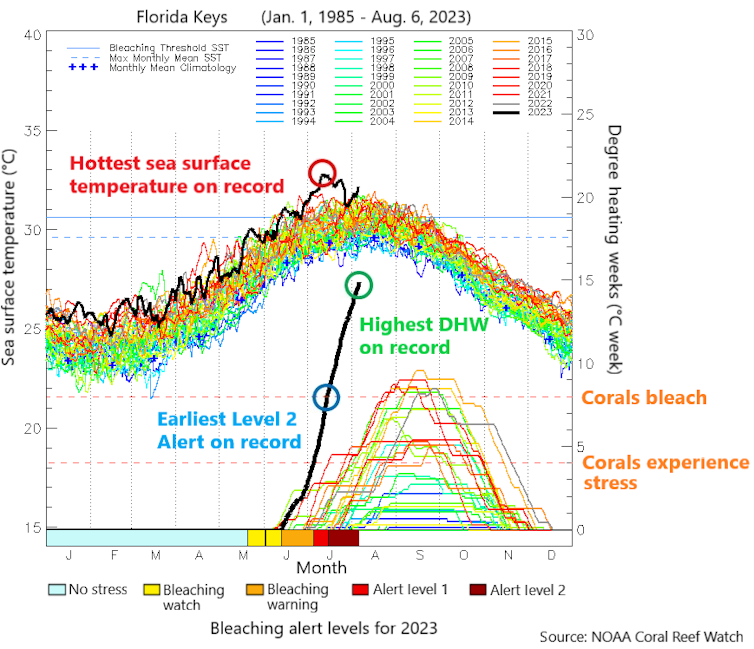
At the Keys Marine Laboratory, scientists and trained volunteers have dropped off thousands of coral fragments collected from heat-threatened offshore nurseries. Director Cindy Lewis described the lab’s giant tanks as looking like “a MASH unit for corals.”
Volunteers there and at other labs across Florida will hand-feed the tiny creatures to keep them alive until the Florida waters cool again and they can be returned to the ocean and eventually transplanted onto the reef.
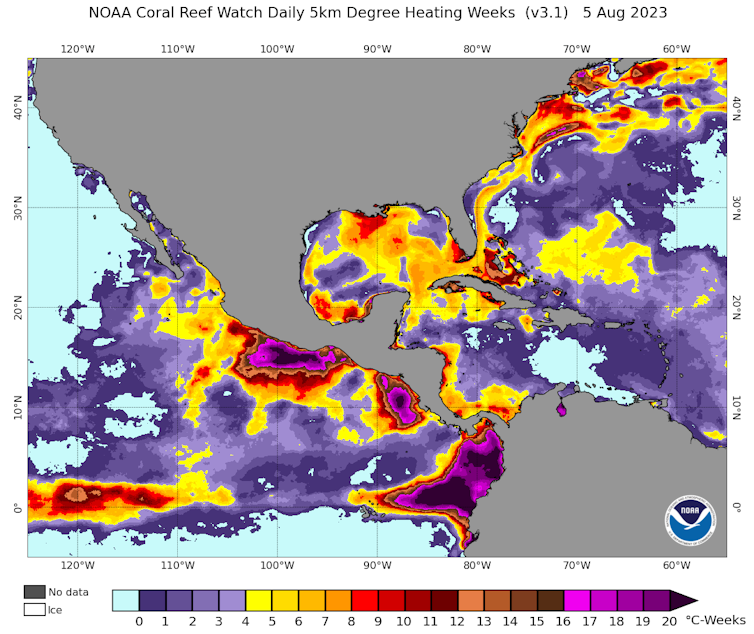
Protecting Corals Still In The Ocean
I.CARE launched another type of emergency response.
I.CARE co-founder Kylie Smith, a coral reef ecologist and a former student of mine in marine sciences, discovered a few years ago that coral transplants with large amounts of fleshy algae around them were more likely to bleach during times of elevated temperature. Removing that algae may give corals a better chance of survival.
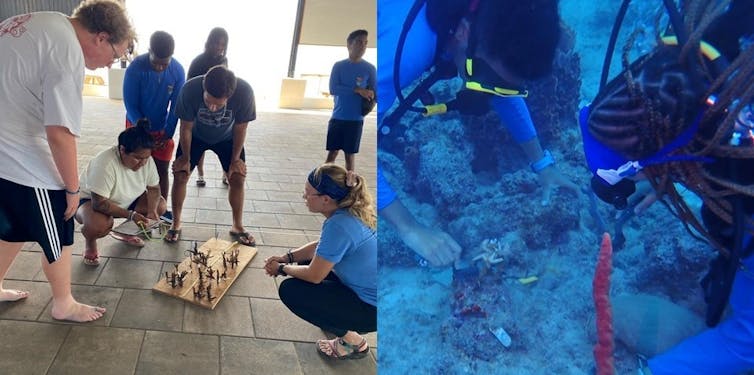
Smith’s group typically works with local dive operators to train recreational divers to assist in transplanting and maintaining coral fragments in an effort to restore the reefs of Islamorada. In summer 2023, I.CARE has been training volunteers, like the young divers from Diving with a Purpose, to remove algae and coral predators, such as coral-eating snails and fireworms, to help boost the corals’ chances of survival.
Monitoring For Corals At Risk
To help spot corals in trouble, volunteer divers are also being trained as reef observers through Mote Marine Lab’s BleachWatch program.
Scuba divers have long been attracted to the reefs of the Florida Keys for their beauty and accessibility. The lab is training them to recognize bleached, diseased and dead corals of different species and then use an online portal to submit bleach reports across the entire Florida Reef.
The more eyes on the reef, the more accurate the maps showing the areas of greatest bleaching concern.
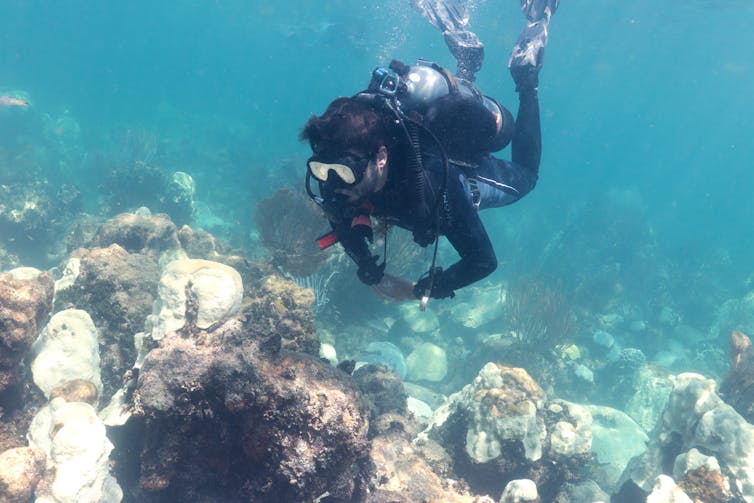
Rebuilding The Reef
While the marine heat wave in the Keys will inevitably kill some corals, many more will survive.
Through careful analysis of the species, genotypes and reef locations experiencing bleaching, scientists and practitioners are learn valuable information as they work to protect and rebuild a more resilient coral reef for the future.
That is what gives hope to Smith, Lewis, Nedimyer and hundreds of others who believe this coral reef is worth saving. Volunteers are crucial to the effort, whether they’re helping with coral reef maintenance, reporting bleaching or raising the awareness of what is at stake if humanity fails to stop warming the planet.![]()
Michael Childress, Associate Professor of Biological Sciences & Environmental Conservation, Clemson University
This article is republished from The Conversation under a Creative Commons license. Read the original article.
Forests are breaking up in the tropics but coming together elsewhere – here’s what it means for wildlife and the climate

In 2015, research on global forest cover revealed a concerning fact: 70% of the world’s remaining forest now lies within 1km of the forest’s edge. This process, called fragmentation, is causing the deepest and darkest parts of the world’s forests to shrink.
Forest fragmentation is bad news for many unique animal and plant species that rely on these forests for their survival. It also reduces the forest’s ability to capture and store carbon, which is an important part of tackling climate change.
Researchers from Fudan University in China recently conducted a study that mapped changes in global forest fragmentation between 2000 and 2020. Their results show that the most biodiverse forests on the planet – those found in the tropics – continue to suffer increasing fragmentation, mainly due to clearance for agriculture.
However, the picture is different in certain boreal, temperate and sub-tropical regions. In particular, patches of forest in western Canada, western and far-eastern Russia, and central and southern China seem to be coming together.
Less fragmentation should, in theory, benefit forest biodiversity and increase carbon removal. But the outcome ultimately depends on the type of forests that are regrowing or being planted. It’s unclear from the study whether the regrowth consists of single-species plantations for timber or bioenergy, or if it’s natural regeneration.
However, a different study in 2022 shed some light on the situation. It highlighted the presence of large areas of planted forest in temperate and boreal regions, alongside natural regenerated forests with signs of human management such as logging.
These forests host very different biodiversity to natural, old-growth forests, and are less effective at storing carbon.
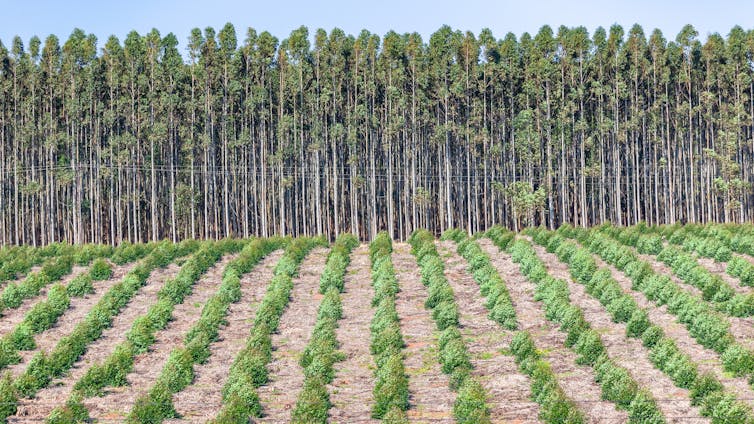
Measuring A Forest
The new study classifies forests only by tree cover – defined as a 30- by 30-metre pixel on a satellite image, where more than 50% of the pixel area is covered with trees that are over 5 metres tall. This is a common way to identify forests but has a limitation: it doesn’t distinguish between different forest types.
In the tropics, for example, this analysis would treat an intact rainforest and a mature Hevea brasiliensis rubber tree plantation as the same thing. But they have different biodiversity, ecosystem functions and capacity for carbon drawdown and storage.
Rubber tree plantations, for example, support far fewer (and different) plant and animal species than natural tropical forests. In fact, a study conducted in the Mekong region of south-east Asia found that, in most cases, monoculture rubber plantations harbour less than half the plant- and animal-species richness of natural forest.
Capturing the cyclical patterns of forest clearance and planting in such an analysis is also difficult. Demand for timber and wood for biofuel is increasing, so there might have been recent growth in tree planting, and now these trees could be reaching maturity. However, this growth is part of a cyclical felling process, so it may not indicate a long-term trend. As these plantations mature, forests may once again become fragmented.
Why Are Forests Being Lost Or Gained?
Understanding the reasons behind forest loss or gain is also challenging. The Fudan University study found that wildfires were linked to increased forest fragmentation in both the southern Amazon and central Siberia. But the reasons for these fires are probably very different and can often be complicated.
In central Siberia, unusually high temperatures have led to forest fires in recent years. Some of these fires may start in agricultural areas, but there are also underground peat fires (known as “zombie fires”) that smoulder throughout winter and reignite the surface during periods of drought. These fires do not represent intentional forest clearance by people.
On the other hand, fires are used deliberately as a tool to clear land for agriculture in the southern Amazon. These fires can also become worse during drought conditions.
Forest gains may result from changes in land management practices that do not necessarily represent natural forest regrowth. Switching from traditional, shifting cultivation (a form of agriculture where plots of land are cultivated temporarily before being abandoned to recover) to permanent tree cover crops, as seen with rubber in south-east Asia, would show up as decreased fragmentation. And yet, it also signifies a decline in natural forest cover because areas are no longer being left to regrow naturally. This could lead to a decrease in biodiversity and possible hydrological consequences.

Large Tracts Of Forests Are Important
What’s clear is that large “intact” forest landscapes need to be protected. Forests create their own microclimates, with depths of shade, humidity and specific soils. These microclimates are significantly altered at the edges of forests.
In intact forests, animals can move over large distances without having to leave the habitat they depend upon. Similarly, plants, insects and amphibians that rely on specific forest microclimates can find new areas to establish and grow within the forest ecosystem.
Many animal and plant species can only thrive in these deep forests. The Mendolong bubble-nest frog, for example, inhabits a single mountain in Borneo and has never been found in a disturbed forest. Keeping tropical forests intact and unfragmented is critical for species such as this.
We need to keep a close eye on where we are losing and gaining forests – both for the sake of biodiversity and the climate.

Don’t have time to read about climate change as much as you’d like?
Get a weekly roundup in your inbox instead. Every Wednesday, The Conversation’s environment editor writes Imagine, a short email that goes a little deeper into just one climate issue. Join the 20,000+ readers who’ve subscribed so far.![]()
Eleanor Warren-Thomas, Lecturer in Conservation and Forestry, Bangor University
This article is republished from The Conversation under a Creative Commons license. Read the original article.
One of 2023’s most extreme heatwaves is happening in the middle of winter
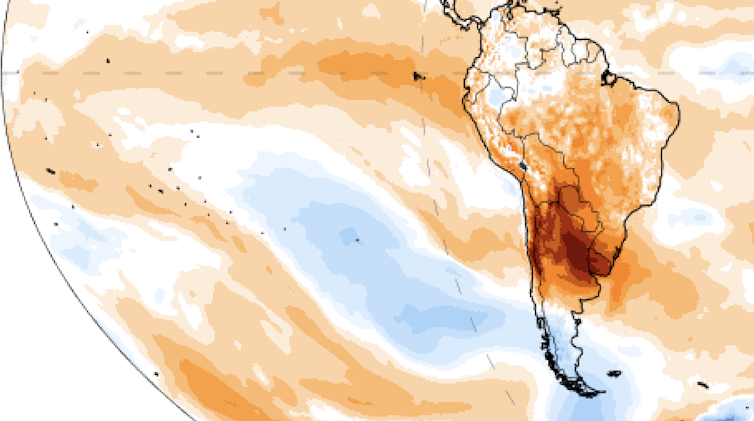
Temperatures in parts of Chile and northern Argentina have soared to 10°C-20°C above average over the last few days. Towns in the Andes mountains have reached 38°C or more, while Argentina’s capital, Buenos Aires, saw temperatures above 30°C – breaking its previous August record by more than 5°C. Temperatures peaked at 39°C in the town of Rivadavia.
Bear in mind it’s mid-winter in this part of the world. And it’s far south enough that seasonal variations have a substantial impact on temperatures. Buenos Aires, for instance, is as far south as Japan, Tibet or Tennessee are north.
In terms of deviation from temperatures you might expect at a certain place and time of year, this heatwave is comparable to, if not greater than, the recent heatwaves in southern Europe, the US and China. In Vicuña, one of the towns in the Chilean Andes that recently reached 38°C, a typical August day might be 18°C or so – just imagine it being a whole 20°C warmer than normal wherever you are now.
No wonder some climate scientists have already suggested this could be one of the most extreme heatwaves on record.
What’s Causing The Extreme Heat?
Over the past six days, a persistent area of high pressure, or anticyclone, has lingered to the east of the Andes. Also known as a “blocking high”, this appears to be the key driver of the intense heat.
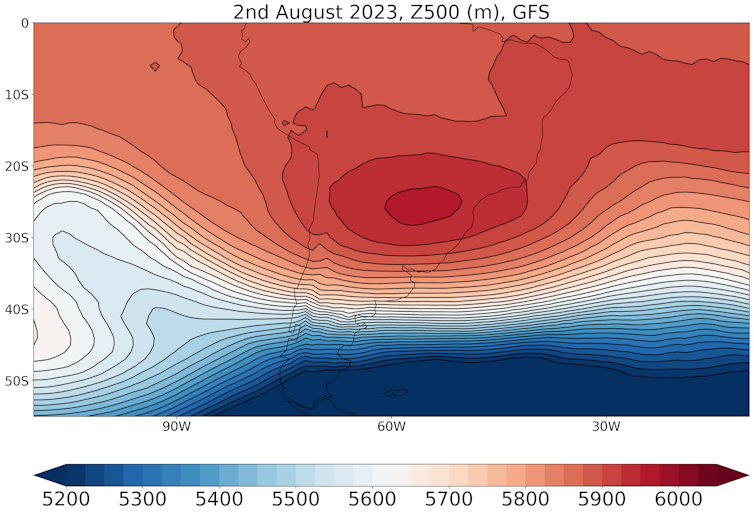
Blocking anticyclones can drive heatwaves in three main ways. Firstly, they pull warmer air from closer to the equator towards them. The system also compresses and traps the air, heating it up, as was the case for the 2021 heatwave in the Pacific Northwest, which shattered the Canadian temperature record by nearly 5°C. Finally, the high pressure means there is little ascending air and hence little cloud cover. This allows the sun to heat the land continuously during the day, building up heat.
However, scientists need to analyse the meteorology of this unprecedented event in more detail to gain a more complete understanding.
El Niño Made This More Likely
The Chile-Argentina heatwave may have been made more likely by the developing El Niño in the Pacific Ocean. El Niño events, which typically occur every four years or so, are characterised by warm sea surface temperatures in the central-to-eastern tropical Pacific. Temperatures in the central Pacific are currently about 1°C above average for the time of year.
These warmer ocean temperatures make air more buoyant over the central Pacific, causing the air to rise. This drives changes to atmospheric circulation patterns further afield. El Niño-induced changes to atmospheric circulation typically mean higher pressure and warmer winter temperatures for this part of South America.
Climate Change Made It Worse
The blocking system driving the extreme heat would probably have led to warm temperatures even in the absence of anthropogenic climate change. However, the rapid warming of climate change allowed the heatwave to become truly unprecedented.
Climate scientists expect to see temperature records broken as our planet continues to heat up. This is because the distribution of possible temperatures is shifting higher and higher.
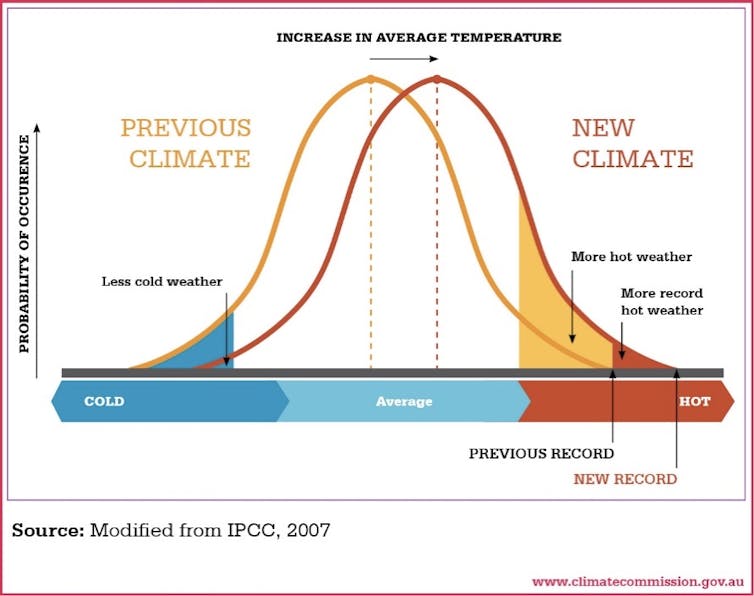
Chile has already experienced the effects of climate change recently through a severe heatwave in February – late summer – resulting in several deaths from wildfires, as well as a decade-long mega-drought. The country recently rejected a rewrite of the constitution which would have mandated its government to take action against the nature and climate crises.
The Longer-Term Impact Of A Winter Heatwave
The hottest temperatures now appear to have largely subsided in the Andes. However, temperatures are still well above average for northern Argentina, Bolivia and Paraguay, and will remain so for the next five days or so.
The impacts of winter heatwaves are less well understood than summer heatwaves. For Chile, the most likely impact is on snowpack in the mountains, which provides water for drinking, agriculture and power generation. Any melting of the snowpack will probably also affect the diverse flora and fauna found in the Andes.
Overall, this heatwave is a startling reminder of how humans are changing Earth’s climate. We will continue to see such unprecedented extremes until we stop burning fossil fuels and emitting greenhouse gases into the atmosphere.

Don’t have time to read about climate change as much as you’d like?
Get a weekly roundup in your inbox instead. Every Wednesday, The Conversation’s environment editor writes Imagine, a short email that goes a little deeper into just one climate issue. Join the 20,000+ readers who’ve subscribed so far.![]()
Matthew Patterson, Postdoctoral Research Assistant in in Atmospheric Physics, University of Oxford
This article is republished from The Conversation under a Creative Commons license. Read the original article.
Computer science can help farmers explore alternative crops and sustainable farming methods

Humans have physically reconfigured half of the world’s land to grow just eight staple crops: maize (corn), soy, wheat, rice, cassava, sorghum, sweet potato and potato. They account for the vast majority of calories that people around the world consume. As global population rises, there’s pressure to expand production even further.
Many experts argue that further expanding modern industrialized agriculture – which relies heavily on synthetic fertilizer, chemical pesticides and high-yield seeds – isn’t the right way to feed a growing world population. In their view, this approach isn’t sustainable ecologically or economically, and farmers and scientists alike feel trapped within this system.
How can societies develop a food system that meets their needs and is also more healthy and diverse? It has proved hard to scale up alternative methods, such as organic farming, as broadly as industrial agriculture.
In a recent study, we considered this problem from our perspectives as a computer scientist and a crop scientist. We and our colleagues Bryan Runck, Adam Streed, Diane R. Wang and Patrick M. Ewing proposed a way to rethink how agricultural systems are designed and implemented, using a central idea from computer science - abstraction - that summarizes data and concepts and organizes them computationally, so we can analyze and act upon them without having to constantly examine their internal details.
Big Output, Big Impacts
Modern agriculture intensified over just a few decades in the mid-20th century – a blink of an eye in human history. Technological improvements led the way, including the development of synthetic fertilizer and statistical methods that improved plant breeding.
These advances made it possible for farms to produce much larger quantities of food, but at the expense of the environment. Large-scale agriculture has helped drive climate change, polluted lakes and bays with nutrient runoff and accelerated species losses by turning natural landscapes into monoculture crop fields.
Many U.S. farmers and agricultural researchers would like to grow a wider range of crops and use more sustainable farming methods. But it’s hard for them to figure out what new systems could perform well, especially in a changing climate. Lower-impact farming systems often require deep local knowledge, plus an encyclopedic understanding of plants, weather and climate modeling, geology and more.
That’s where our new approach comes in.

Farms As State Spaces
When computer scientists think about complex problems, they often use a concept called a state space. This approach mathematically represents all of the possible ways in which a system can be configured. Moving through the space entails making choices, and those choices change the state of the system, for better or worse.
As an example, consider a game of chess with a board and two players. Each configuration of the board at a moment in time is a single state of the game. When a player makes a move, it shifts the game to another state.
The whole game can be described by its “state space” – all possible states the game could be in through valid moves the players make. During the game, each player is searching for states that are better for them.
We can think of an agricultural system as a state space in a particular ecosystem. A farm and its layout of plant species at any moment in time represent one state in that state space. The farmer is searching for better states and trying to avoid bad ones.
Both humans and nature shift the farm from one state to another. On any given day, the farmer might do a dozen different things on the land, such as tilling, planting, weeding, harvesting or adding fertilizer. Nature causes minor state transitions, such as plants growing and rain falling, and much more dramatic state transitions during natural disasters such as floods or wildfires.
Finding Synergies
Viewing an agricultural system as a state space makes it possible to broaden choices for farmers beyond the limited options today’s farming systems offer.
Individual farmers don’t have the time or ability to do trial and error for years on their land. But a computing system can draw on agricultural knowledge from many different environments and schools of thought to play a metaphorical chess game with nature that helps farmers identify the best options for their land.
Conventional agriculture limits farmers to a few choices of plant species, farming methods and inputs. Our framework makes it possible to consider higher-level strategies, such as growing multiple crops together or finding management techniques that are best suited to a particular piece of land. Users can search the state space to consider what mix of methods, species and locales could achieve those goals.
For example, if a scientist wants to test five crop rotations – raising planned sequences of crops on the same fields – that each last four years, growing seven plant species, that represents 721 potential rotations. Our approach could use information from long-term ecological research to help find the best potential systems to test.
One area where we see great potential is intercropping – growing different plants in a mixture or close together. Many combinations of specific plants have long been known to grow well together, with each plant helping the others in some way.
The most familiar example is the “three sisters” – maize, squash and beans – developed by Indigenous farmers of the Americas. Corn stalks act as trellises for climbing bean vines, while squash leaves shade the ground, keeping it moist and preventing weeds from sprouting. Bacteria on the bean plants’ roots provide nitrogen, an essential nutrient, to all three plants.
Cultures throughout human history have had their own favored intercropping systems with similar synergies, such as tumeric and mango or millet, cowpea and ziziphus, commonly known as red date. And new work on agrivoltaics shows that combining solar panels and farming can work surprisingly well: The panels partially shade crops that grow underneath them, and farmers earn extra income by producing renewable energy on their land.
Modeling Alternative Farm Strategies
We are working to turn our framework into software that people can use to model agriculture as state spaces. The goal is to enable users to consider alternative designs based upon their intuition, minimizing the costly trial and error that’s now required to test out new ideas in farming.
Today’s approaches largely model and pursue optimizations of existing, often unsustainable systems of agriculture. Our framework enables discovery of new systems of agriculture and then optimization within those new systems.
Users also will be able to specify their objectives to an artificial intelligence-based agent that can perform a search of the farm state space, just as it might search the state space of a chessboard to pick winning moves.
Modern societies have access to many more plant species and much more information about how different species and environments interact than they did a century ago. In our view, agricultural systems aren’t doing enough to leverage all that knowledge. Combining it computationally could help make agriculture more productive, healthy and sustainable in a rapidly changing world.![]()
Barath Raghavan, Associate Professor of Computer Science and Electrical and Computer Engineering, University of Southern California and Michael Kantar, Associate Professor of Tropical Plants & Soil Sciences, University of Hawaii
This article is republished from The Conversation under a Creative Commons license. Read the original article.
Pittwater Reserves: Histories + Notes + Pictorial Walks
A History Of The Campaign For Preservation Of The Warriewood Escarpment by David Palmer OAM and Angus Gordon OAM
A Stroll Through Warriewood Wetlands by Joe Mills February 2023
A Walk Around The Cromer Side Of Narrabeen Lake by Joe Mills
America Bay Track Walk - photos by Joe Mills
An Aquatic June: North Narrabeen - Turimetta - Collaroy photos by Joe Mills
Angophora Reserve Angophora Reserve Flowers Grand Old Tree Of Angophora Reserve Falls Back To The Earth - History page
Annie Wyatt Reserve - A Pictorial
Avalon's Village Green: Avalon Park Becomes Dunbar Park - Some History + Toongari Reserve and Catalpa Reserve
Bairne Walking Track Ku-Ring-Gai Chase NP by Kevin Murray
Bangalley Headland Bangalley Mid Winter
Banksias of Pittwater
Barrenjoey Boathouse In Governor Phillip Park Part Of Our Community For 75 Years: Photos From The Collection Of Russell Walton, Son Of Victor Walton
Barrenjoey Headland: Spring flowers
Barrenjoey Headland after fire
Bayview Baths
Bayview Wetlands
Beeby Park
Bilgola Beach
Botham Beach by Barbara Davies
Bungan Beach Bush Care
Careel Bay Saltmarsh plants
Careel Bay Birds
Careel Bay Clean Up day
Careel Bay Playing Fields History and Current
Careel Creek
Careel Creek - If you rebuild it they will come
Centre trail in Ku-ring-gai Chase National Park
Chiltern Track- Ingleside by Marita Macrae
Clareville Beach
Clareville/Long Beach Reserve + some History
Coastal Stability Series: Cabbage Tree Bay To Barrenjoey To Observation Point by John Illingsworth, Pittwater Pathways, and Dr. Peter Mitchell OAM
Cowan Track by Kevin Murray
Curl Curl To Freshwater Walk: October 2021 by Kevin Murray and Joe Mills
Currawong and Palm Beach Views - Winter 2018
Currawong-Mackerel-The Basin A Stroll In Early November 2021 - photos by Selena Griffith
Currawong State Park Currawong Beach + Currawong Creek
Deep Creek To Warriewood Walk photos by Joe Mills
Drone Gives A New View On Coastal Stability; Bungan: Bungan Headland To Newport Beach + Bilgola: North Newport Beach To Avalon + Bangalley: Avalon Headland To Palm Beach
Duck Holes: McCarrs Creek by Joe Mills
Dunbar Park - Some History + Toongari Reserve and Catalpa Reserve
Dundundra Falls Reserve: August 2020 photos by Selena Griffith - Listed in 1935
Elsie Track, Scotland Island
Elvina Track in Late Winter 2019 by Penny Gleen
Elvina Bay Walking Track: Spring 2020 photos by Joe Mills
Elvina Bay-Lovett Bay Loop Spring 2020 by Kevin Murray and Joe Mills
Fern Creek - Ingleside Escarpment To Warriewood Walk + Some History photos by Joe Mills
Iluka Park, Woorak Park, Pittwater Park, Sand Point Reserve, Snapperman Beach Reserve - Palm Beach: Some History
Ingleside
Ingleside Wildflowers August 2013
Irrawong - Ingleside Escarpment Trail Walk Spring 2020 photos by Joe Mills
Irrawong - Mullet Creek Restoration
Katandra Bushland Sanctuary - Ingleside
Lucinda Park, Palm Beach: Some History + 2022 Pictures
McCarrs Creek
McCarr's Creek to Church Point to Bayview Waterfront Path
McKay Reserve
Mona Vale Beach - A Stroll Along, Spring 2021 by Kevin Murray
Mona Vale Headland, Basin and Beach Restoration
Mona Vale Woolworths Front Entrance Gets Garden Upgrade: A Few Notes On The Site's History
Mount Murray Anderson Walking Track by Kevin Murray and Joe Mills
Mullet Creek
Narrabeen Creek
Narrabeen Lagoon Catchment: Past Notes Present Photos by Margaret Woods
Narrabeen Lagoon State Park
Narrabeen Lagoon State Park Expansion
Narrabeen Rockshelf Aquatic Reserve
Nerang Track, Terrey Hills by Bea Pierce
Newport Bushlink - the Crown of the Hill Linked Reserves
Newport Community Garden - Woolcott Reserve
Newport to Bilgola Bushlink 'From The Crown To The Sea' Paths: Founded In 1956 - A Tip and Quarry Becomes Green Space For People and Wildlife
Pittwater Reserves: The Green Ways; Bungan Beach and Bungan Head Reserves: A Headland Garden
Pittwater Reserves, The Green Ways: Clareville Wharf and Taylor's Point Jetty
Pittwater Reserves: The Green Ways; Hordern, Wilshire Parks, McKay Reserve: From Beach to Estuary
Pittwater Reserves - The Green Ways: Mona Vale's Village Greens a Map of the Historic Crown Lands Ethos Realised in The Village, Kitchener and Beeby Parks
Pittwater Reserves: The Green Ways Bilgola Beach - The Cabbage Tree Gardens and Camping Grounds - Includes Bilgola - The Story Of A Politician, A Pilot and An Epicure by Tony Dawson and Anne Spencer
Pittwater spring: waterbirds return to Wetlands
Pittwater's Lone Rangers - 120 Years of Ku-Ring-Gai Chase and the Men of Flowers Inspired by Eccleston Du Faur
Pittwater's Parallel Estuary - The Cowan 'Creek
Resolute Track at West Head by Kevin Murray
Resolute Track Stroll by Joe Mills
Riddle Reserve, Bayview
Salvation Loop Trail, Ku-Ring-Gai Chase National Park- Spring 2020 - by Selena Griffith
Seagull Pair At Turimetta Beach: Spring Is In The Air!
Stapleton Reserve
Stapleton Park Reserve In Spring 2020: An Urban Ark Of Plants Found Nowhere Else
Stony Range Regional Botanical Garden: Some History On How A Reserve Became An Australian Plant Park
The Chiltern Track
The Resolute Beach Loop Track At West Head In Ku-Ring-Gai Chase National Park by Kevin Murray
Topham Track Ku-Ring-Gai Chase NP, August 2022 by Joe Mills and Kevin Murray
Towlers Bay Walking Track by Joe Mills
Trafalgar Square, Newport: A 'Commons' Park Dedicated By Private Landholders - The Green Heart Of This Community
Tranquil Turimetta Beach, April 2022 by Joe Mills
Turimetta Beach Reserve by Joe Mills, Bea Pierce and Lesley
Turimetta Beach Reserve: Old & New Images (by Kevin Murray) + Some History
Turimetta Headland
Warriewood Wetlands - Creeks Deteriorating: How To Report Construction Site Breaches, Weed Infestations + The Long Campaign To Save The Warriewood Wetlands & Ingleside Escarpment March 2023
Warriewood Wetlands and Irrawong Reserve
Whale Beach Ocean Reserve: 'The Strand' - Some History On Another Great Protected Pittwater Reserve
Wilshire Park Palm Beach: Some History + Photos From May 2022
Winji Jimmi - Water Maze

Pictures From The Past: Bilgola-Newport-Manly
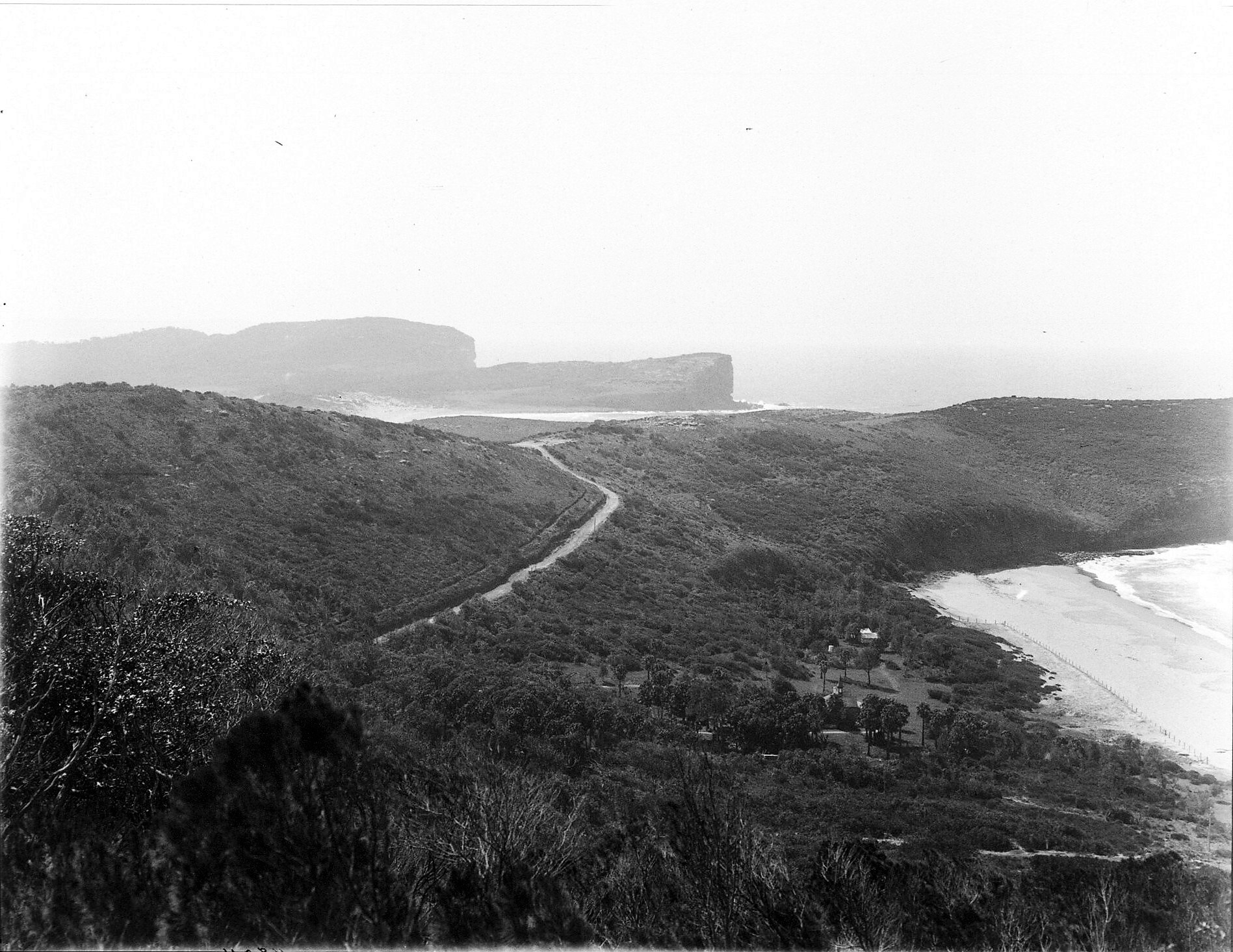
Bilgola in 1912
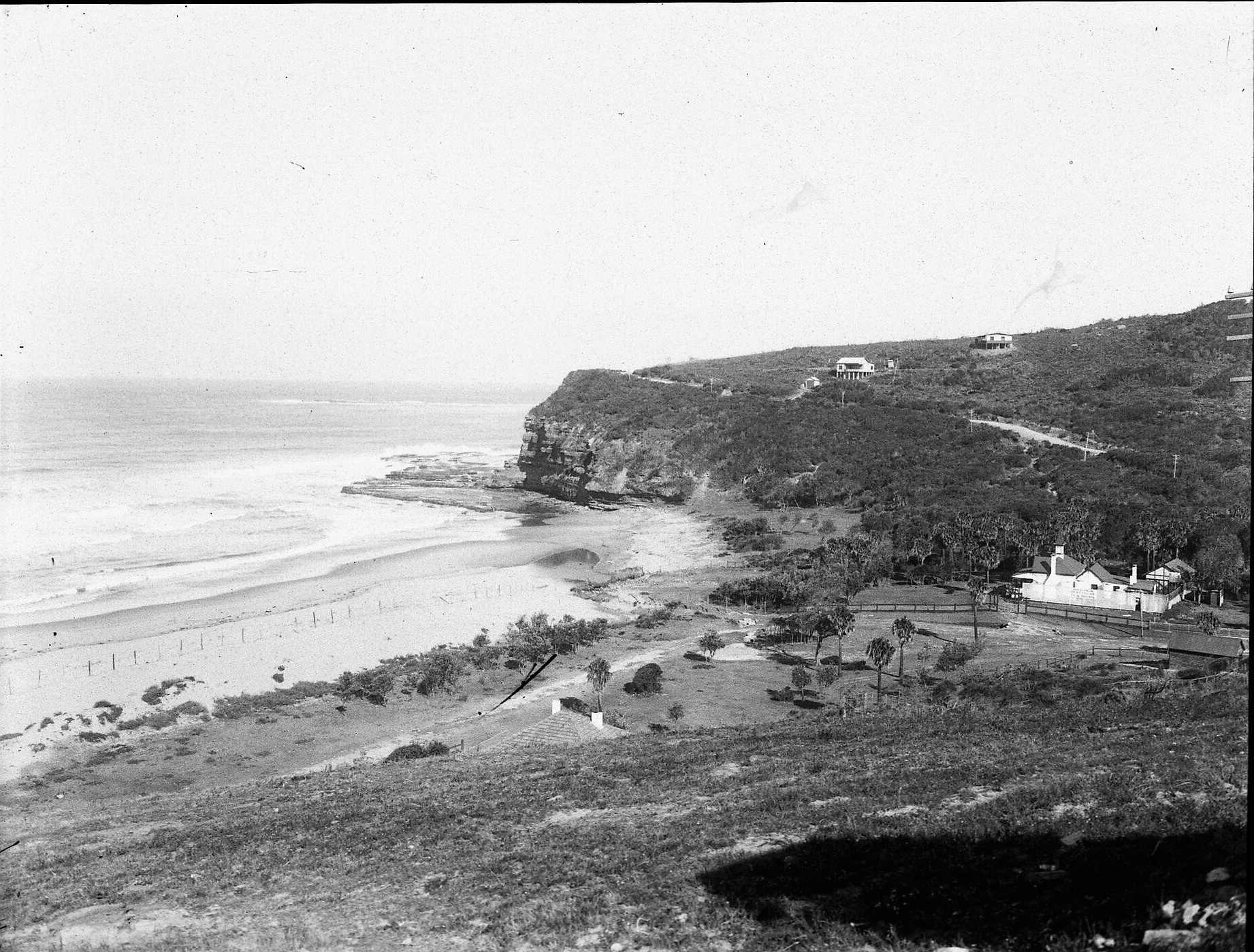
Bilgola in 1925 - photos courtesy NSW Records and Archives
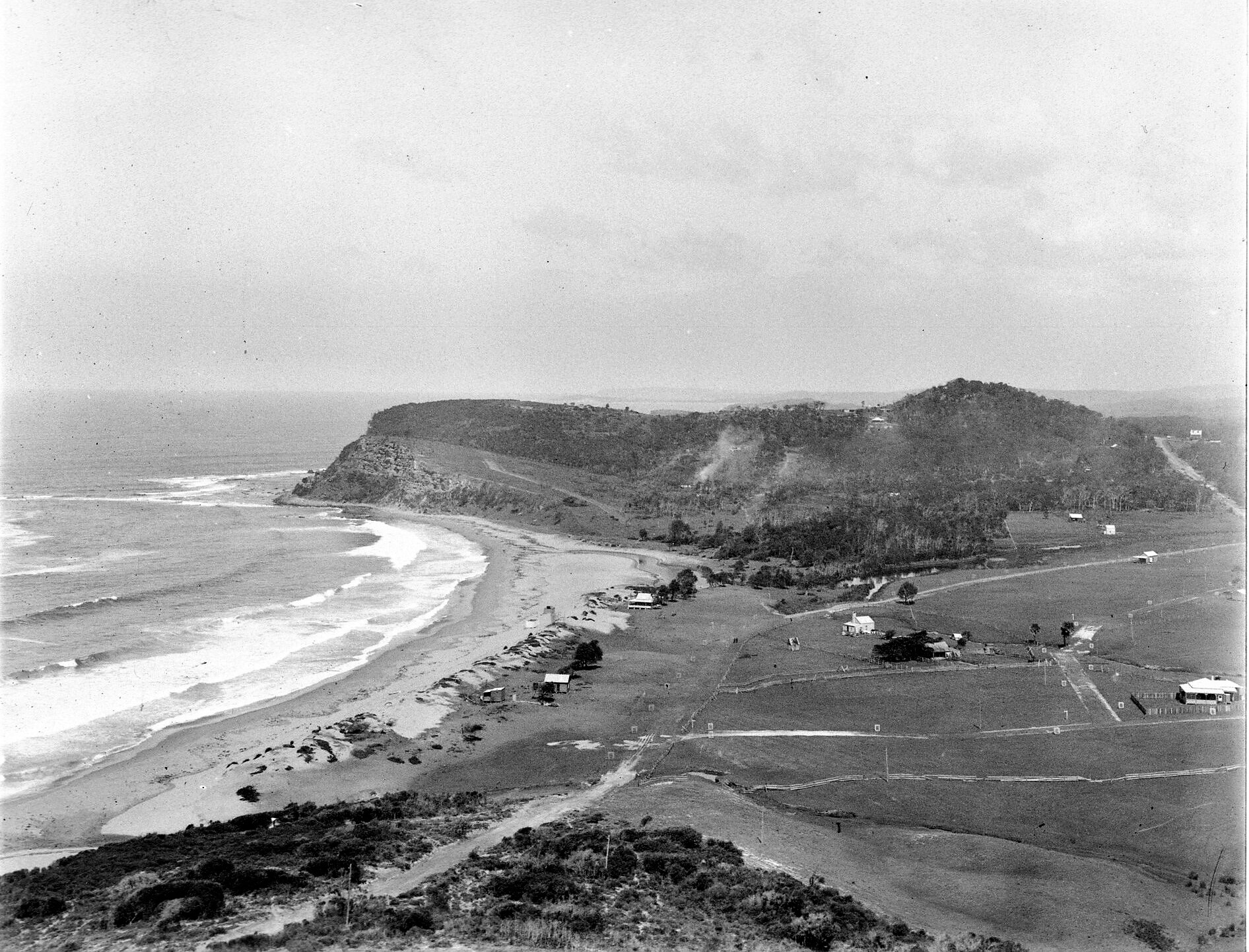
Newport in 1912 - above and below - photos courtesy NSW Records and Archives
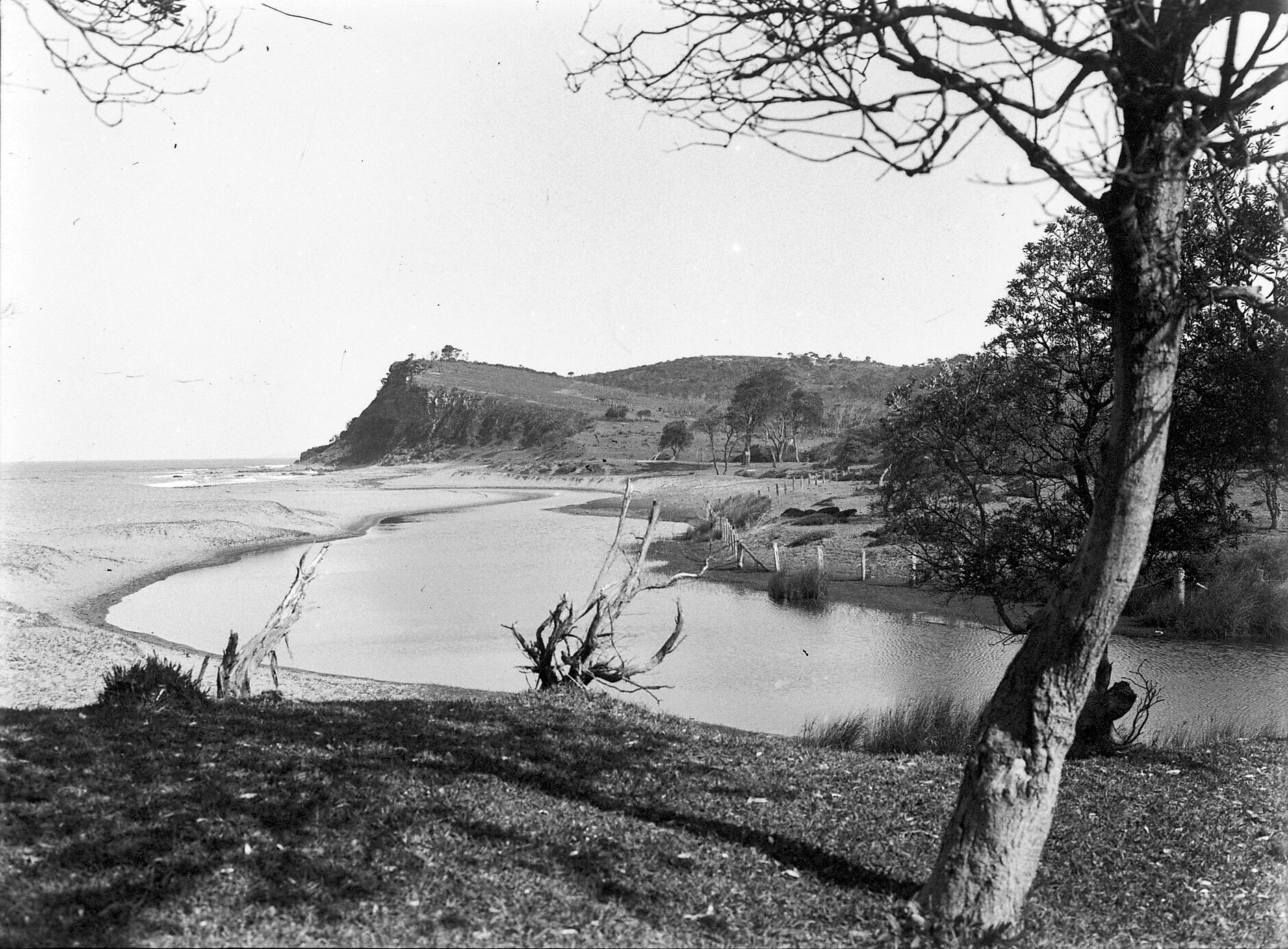
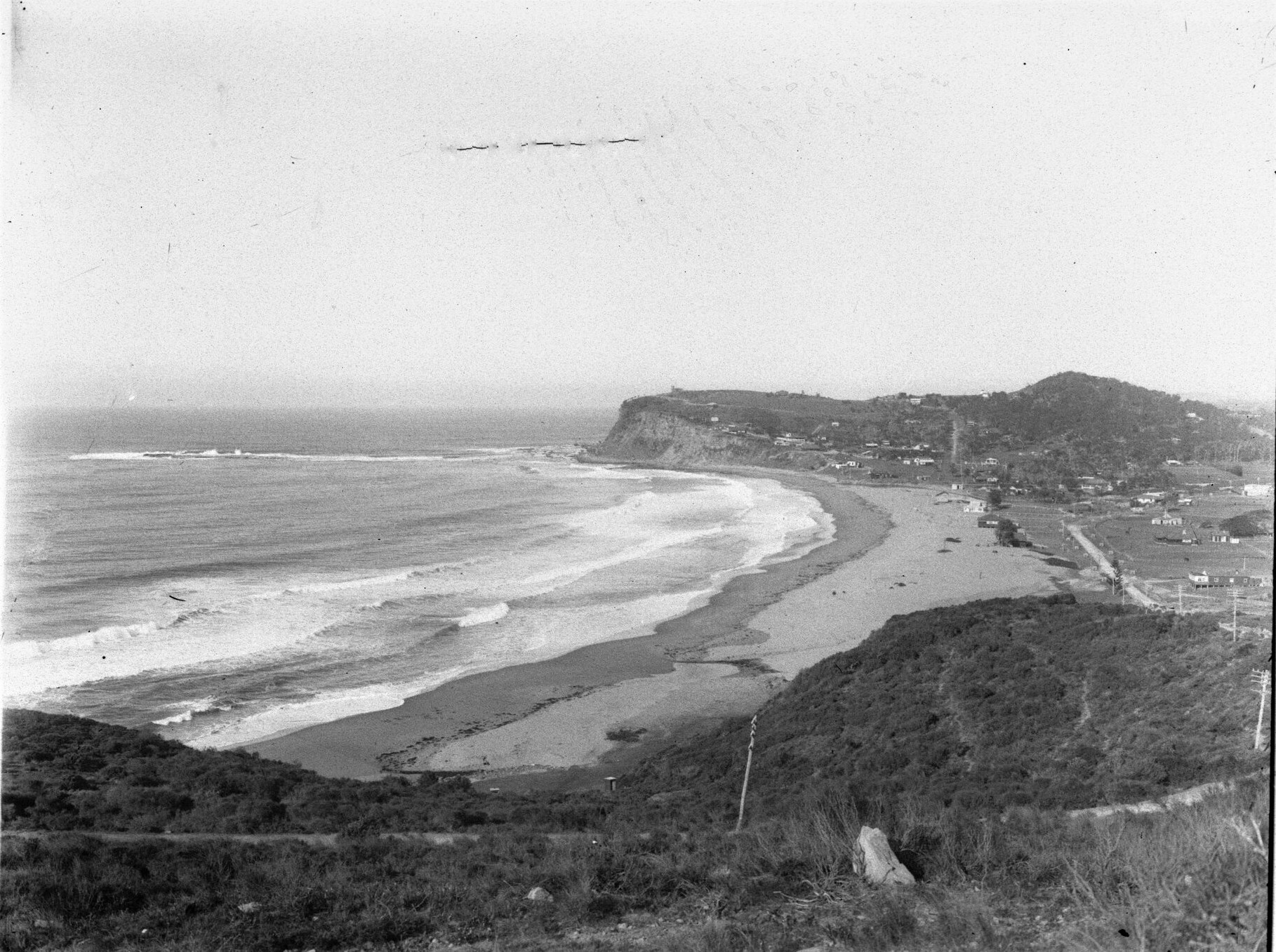
Newport in 1925 - above and below - photos courtesy NSW Records and Archives
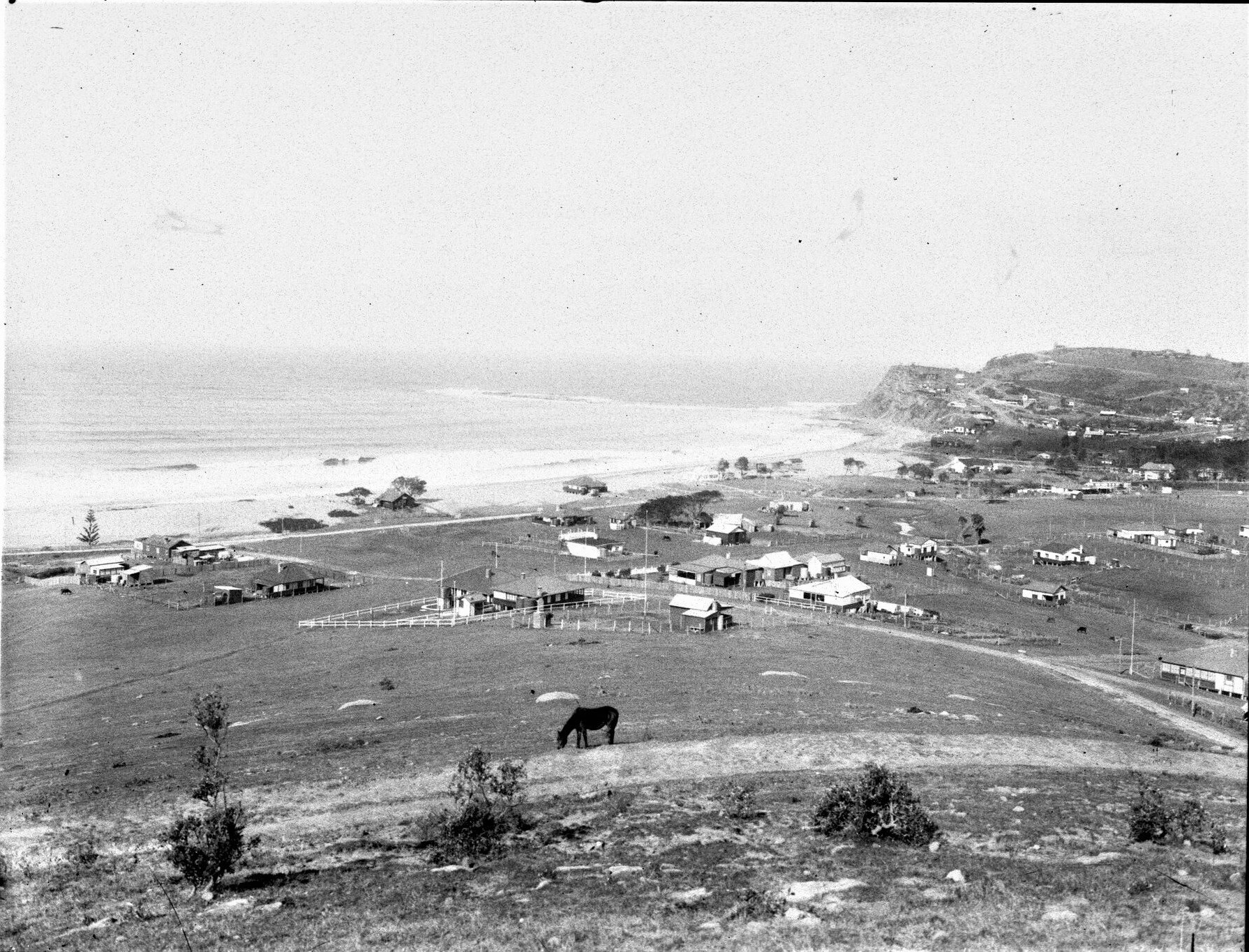

Manly Corso circa 1927. Photo courtesy State Library of NSW

Manly Beach; site of to come Corso - circa 1860 - courtesy State Library of Victoria - Image No.: H3671.
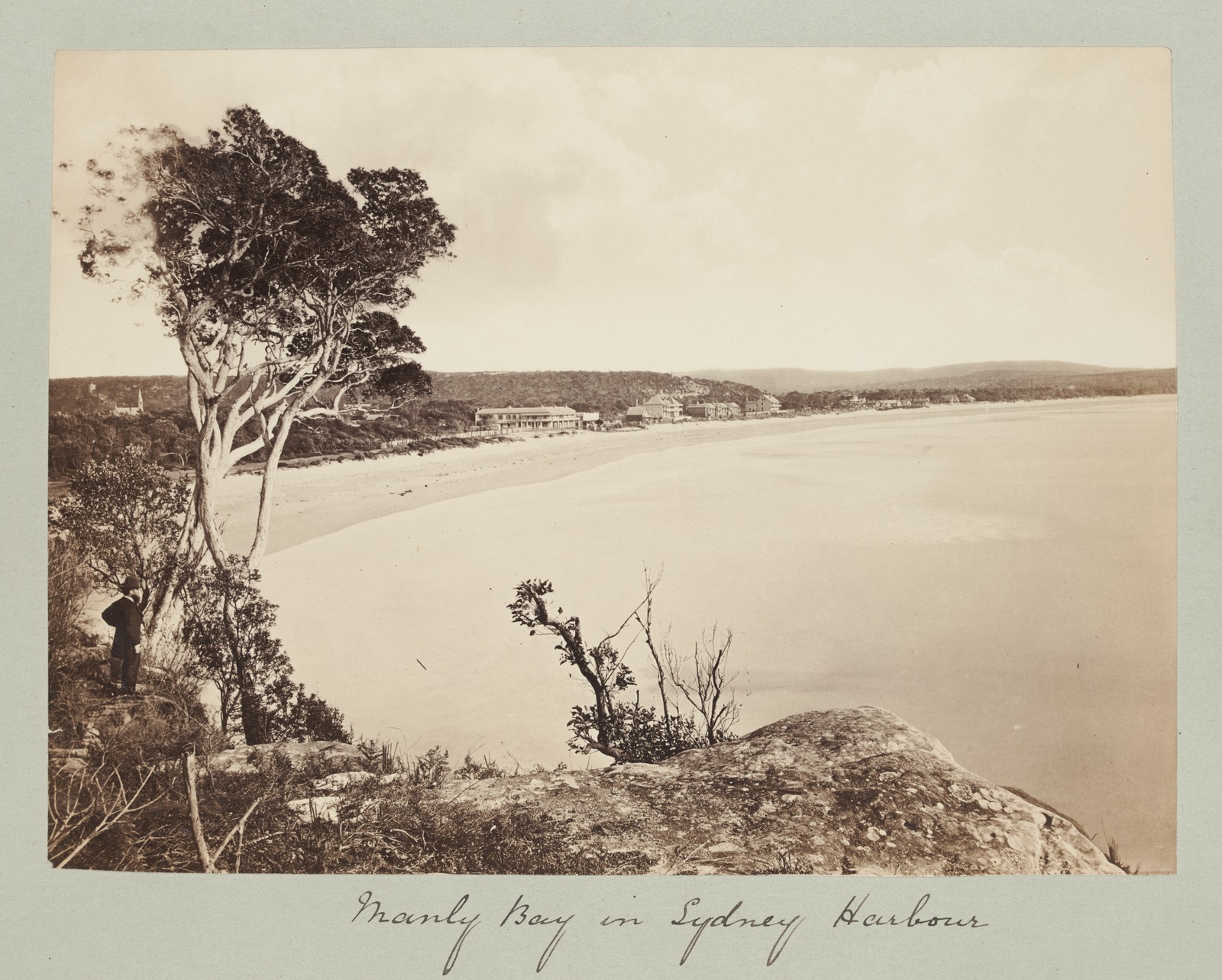
'Manly Bay in Sydney Harbour' circa 1860-1870, courtesy State Library of Victoria Item: FL16409129
Sydney Scientists Name New Species Of Giant Amphibian Found In Retaining Wall
August 9, 2023
Arenaerpeton supinatus was discovered in rocks cut from a nearby quarry that were intended for the building of a garden wall.
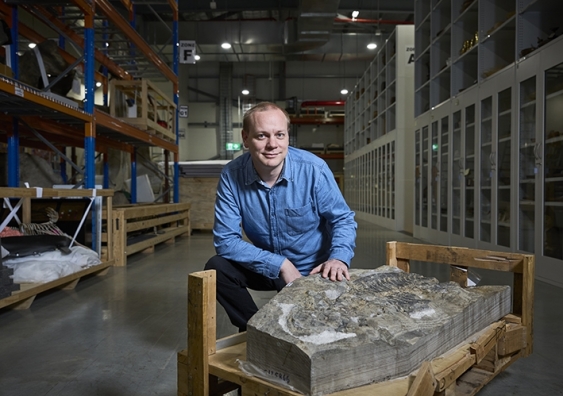
Lachlan Hart says the fossil is a unique example of a group of extinct animals known as temnospondyls, which lived before and during the time of the dinosaurs. Photo: UNSW Sydney/Richard Freeman
A 240-million-year-old fossil of an amphibian that was found in a retaining wall in the 1990s has been formally named and described by scientists at UNSW Sydney and the Australian Museum.
The fossil was originally found by a retired chicken farmer in rocks obtained from a local quarry intended for use in the construction of a garden retaining wall and was subsequently donated to the Australian Museum in Sydney.
Palaeontologist Lachlan Hart, who holds joint roles with UNSW Science and the Australian Museum, says the fossil – named Arenaerpeton supinatus, meaning ‘supine sand creeper’ – shows nearly the entire skeleton, and remarkably, the outlines of its skin.
“This fossil is a unique example of a group of extinct animals known as temnospondyls, which lived before and during the time of the dinosaurs,” says Mr Hart, a PhD candidate in the School of Biological, Earth and Environmental Sciences (BEES) at UNSW.
“We don’t often find skeletons with the head and body still attached, and the soft tissue preservation is an even rarer occurrence.”
Arenaerpeton inhabited freshwater rivers in what is now known as the Sydney Basin during the Triassic period, 240 million years ago. Mr Hart says it most likely hunted other ancient fish such as Cleithrolepis, but apart from that, there is not much evidence that tells us about the other animals that Arenaerpeton shared the land and waters with.
“Superficially, Arenaerpeton looks a lot like the modern Chinese Giant Salamander, especially in the shape of its head,” Mr Hart says.
“However, from the size of the ribs and the soft tissue outline preserved on the fossil we can see that it was considerably more heavyset than its living descendants. It also had some pretty gnarly teeth, including a pair of fang-like tusks on the roof of its mouth.”

An artist's impression of Arenaerpeton supinatus, the ancestor of today's Chinese Giant Salamander. Credit: Jose Vitor Silva
Mr Hart says what is exciting about the discovery is that Arenaerpeton is large – estimated to be about 1.2m from head to tail – when most other closely related animals that lived at the same time were small.
“The last of the temnospondyls were in Australia 120 million years after Arenaerpeton, and some grew to massive sizes. The fossil record of temnospondyls spans across two mass extinction events, so perhaps this evolution of increased size aided in their longevity.”
Dr Matthew McCurry, Senior Lecturer in UNSW’s School of BEES and Curator of Palaeontology at the Australian Museum says the fossil is a significant find in Australian paleo history.
“This is one of the most important fossils found in New South Wales in the past 30 years, so it is exciting to formally describe it,” says Dr McCurry, who is also a co-author on the study. “It represents a key part of Australia’s fossil heritage.”
The study has been published in the Journal of Vertebrate Paleontology, and the fossil will be on display at the Australian Museum, Sydney, later this year.
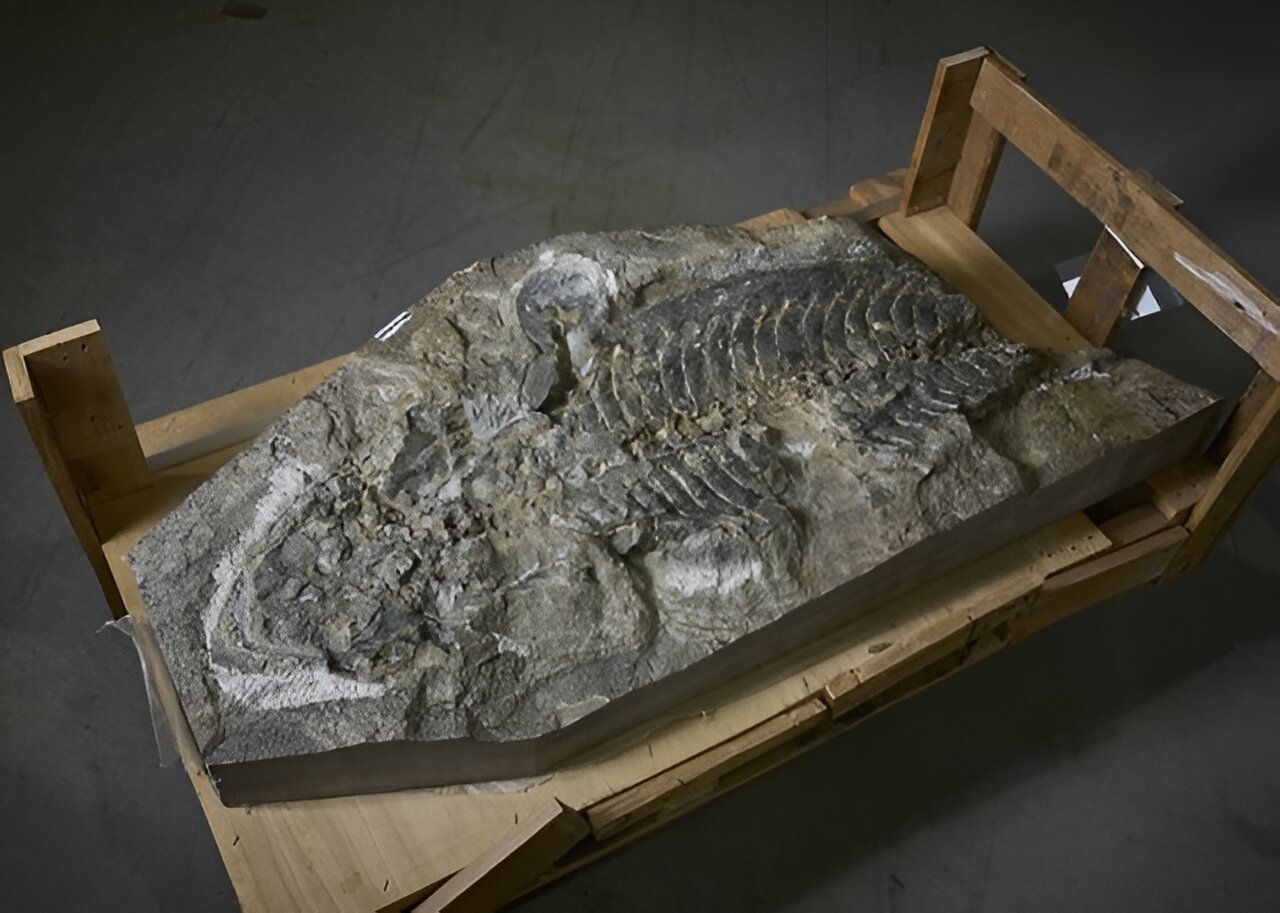
Arenaerpeton looks a lot like the modern Chinese Giant Salamander. Credit: UNSW Sydney/Richard Freeman
Lachlan J. Hart et al, A new chigutisaurid (Brachyopoidea, Temnospondyli) with soft tissue preservation from the Triassic Sydney Basin, New South Wales, Australia. Journal of Vertebrate Paleontology (2023). DOI: 10.1080/02724634.2023.2232829
Remember When Pittwater Online Ran ''WRITTEN IN STONE: A 245 Million Year Old Mass Breeding Event?'' In 2022??
Published 4 Aug 2022 by Pittwater Pathways
Paul Cronk’s discovery of fossil trackways at Turimetta indicates a mass breeding event took place there about 245 million years ago. In this video scientists from the Australian Museum and Macquarie University are examining the fossils. Their discussion and reasoning makes a fascinating record of the scientific process in action.
Lachlan Hart is a vertebrate palaeontologist currently undertaking his PhD at the University of New South Wales and the Australian Museum. His research focuses on the evolution, systematics and palaeobiology of Mesozoic tetrapods, including temnospondyl amphibians, crocodyliformes and dinosaurs. Lachlan is particularly interested in exploring what can be learnt about extinct animals from studying their living descendants
Dr Patrick Smith is a taxonomist and biostratigrapher researching the Cambrian and Ordovician of Australia and New Zealand. He primarily has worked on fossil arthropods (trilobites and their close relatives). However, he's also occasionally worked on other fossil groups, including brachiopods, gastropods and echinoderms. Patrick is particularly interested in using fossils as key time markers to correlate sequences of rocks on a regional, national, and global scale.
Prof Glenn Brock, palaeobiologist, Macquarie University.
My research activities focus on elucidating the evolution, phylogeny, biodiversity, ecology and biostratigraphy of the earliest (stem group) bilaterian animals that arose during the Cambrian Explosion. My work focuses on studying exceptionally preserved macro- and microfossils from a variety of localities in Australasia and Antarctica. I am particularly interested in the phylogenetic, ecological and biostratigraphic significance of early Cambrian "Small Shelly Fossils" (SSF).
Dr Peter Mitchell OAM is one of Australia’s most respected and experienced geomorphologists.
Texting While Walking Makes College Students More Likely To Fall
August 9, 2023
When it comes to college-aged adults who are glued to their smartphones, experts argue over whether texting while walking increases the risk of an accident. Some studies have shown that texting pedestrians are more likely to walk into oncoming traffic, while other studies suggest that young adults have mastered the art of multitasking and are able to text accurately while navigating obstacles. However, few studies have measured how texters respond to unpredictable hazard conditions. By simulating an environment with random slipping threats, researchers report in the journal Heliyon on August 8th that texting increases the risk of falling in response to walkway hazards.
"On any day it seems as many as 80% of people, both younger and older, may be head down and texting. I wondered: is this safe?" says senior author Matthew A. Brodie, a neuroscientist and engineer at the University of New South Wales (UNSW) Graduate School of Biomedical Engineering.
"This has made me want to investigate the dangers of texting while walking. I wanted to know if these dangers are real or imagined and to measure the risk in a repeatable way."
The team recruited 50 UNSW undergraduate students from his "Mechanics of the Human Body" course for this experiment. Brodie and co-author Yoshiro Okubo invented a tiled hazard walkway at Neuroscience Research Australia's gait laboratory, which halfway through had a tile that could be adjusted to slide out of place, so anyone who stepped on it would slip as if on a banana peel. Students wore a safety harness -- preventing any slip from becoming a fall -- and sensors that collected their motion data. They then were asked to go along the walkway either without texting or while typing "The quick brown fox jumps over the lazy dog."
To better simulate the uncertainty of real life, students were only told that they may or may not slip. This allowed the researchers to study how texting pedestrians might anticipate and try to prevent a potential slip, such as by leaning forward.
"What surprised me is how differently people responded to the threat of slipping," says Brodie. "Some slowed down and took a more cautious approach. Others sped up in anticipation of slipping. Such different approaches reinforce how no two people are the same, and to better prevent accidents from texting while walking, multiple strategies may be needed."
Despite motion data showing that texting participants tried to be more cautious in response to a threat, this did not counteract their risk of falling. When participants went from leaning forwards (such as over a phone) to slipping backwards, their motion sensors showed an increase in the range of their "trunk angle." Researchers used this number to measure whether the texting condition was making students more likely to fall, and they found that the average trunk angle range during a fall significantly increased if a student was texting.
Walking also caused the texters' accuracy to decrease. The highest texting accuracy occurred when participants were seated, but accuracy decreased even as walking participants were cautioned about a potential slip that did not occur. The lowest accuracy, however, occurred in conditions where participants did slip.
The researchers note that young people may be more likely to take risks even if they are aware that texting and walking could increase their likelihood of falling. For that reason, the authors suggest that educational initiatives such as signs might be less effective in reaching this population. In addition to education, the researchers also suggest that phones could implement locking technology similar to what is used when users are driving. The technology could detect walking activity and activate a screen lock to prevent texting during that time. In future research, the team plans on looking into the effectiveness of this intervention.
Paulo H.S. Pelicioni, Lloyd LY. Chan, Shuotong Shi, Kenny Wong, Lauren Kark, Yoshiro Okubo, Matthew A. Brodie. Impact of mobile phone use on accidental falls risk in young adult pedestrians. Heliyon, 2023; e18366 DOI: 10.1016/j.heliyon.2023.e18366
ACCC: Record Penalties Of $438m Ordered Against Phoenix Institute And CTI For Acting Unconscionably And Misleading Students
Kickstart Your Dreams With A $3,000 Grant To Follow Your Inspiration
Calling all young Aussies – want to take a shot at making your dreams come true? This FIFA Women’s World Cup 2023™ there are 64 games live on Optus Sport with 64 opportunities for epic inspiration.
To celebrate, Optus are going to help you say yes to achieving your dreams by awarding 64 Optus Inspiration Grants – each grant will be $3,000. The program is open to anyone aged 13-19, and recipients will be picked from all over the country.
The grants are open for Australians aged 13 to 19 to ignite their passion across all disciplines – sports, science, arts, and beyond.
Simply tell Optus in 100 words or less ‘What future goal are you inspired to say yes to, and how would this grant help you achieve this goal?’
This FIFA Women’s World Cup 2023™, inspiration starts with yes.
Applications close 20 August 2023. T&Cs apply.
Visit: www.optus.com.au/connected/topic/sport/grants

Best And Brightest To Help Build Schools For The Future
August 8, 2023
University graduates can get a head start on their careers thanks to an innovative new School Infrastructure NSW program

Left, Myles Pymble is a SINSW cadet, and right, James Cavallaro recently completed the Traineeship Program and now has a full-time job with SINSW, working in IT support.
Recent university graduates are being offered the chance to get a head start on their career in School Infrastructure NSW (SINSW), contributing to the building of new or upgraded schools across NSW.
SINSW has launched its Graduate Program in August 2023, available in metropolitan Sydney for people who’ve completed a diploma or degree qualification in Engineering, Property, Project Management, Information Technology/Computer Science, Sustainability, Procurement, Planning, Business or similar areas.
The School Infrastructure Graduate Program is the third level of the Educational Development Program, following on from the NSW Infrastructure Traineeship for Year 12 school leavers and the School Infrastructure Cadetship aimed at tertiary students in their last year of a diploma or the second last year of a bachelor degree.
James Cavallaro recently completed the Traineeship Program and now has a full-time job with SINSW, working in IT support.
“It introduced me to an awesome network of people that helped me grow and helped me learn from being a student with no knowledge to someone with a pretty good sense of what the industry means and what it can do,” he said.
The SINSW Graduate Program offers recent graduates a two-year opportunity to gain on-the-job experience in their area of expertise within the infrastructure industry.
Graduates will contribute to the planning, delivery and maintenance of new and upgraded schools across NSW.
Anthony Manning, the Chief Executive of SINSW, said the program will tap into the most talented graduates across the state.
“As a key organisation in the build of major infrastructure across NSW, SINSW is constantly searching for talent to fill the various opportunities in its workforce,” he said.
“Graduates will engage in work that has a positive impact on NSW communities.”
SINSW is delivering new school buildings, major upgrades and maintenance strategies to ensure every school-aged child has access to high-quality education facilities at their local public school.
Tiana Riley is one of the current trainees.
“I’m learning a lot of skills and applying them in the workplace which brings it all together in a practical environment,” she said.
Myles Pymble is a cadet and is thoroughly enjoying the experience.
“It offers challenges outside of my comfort zone, with real stakes that offered problem solving and innovative thinking.”
The Educational Development Program will enable School Infrastructure to deliver against the NSW Government Action Plan: A Ten-point Commitment to the Construction Sector for government-procured infrastructure.
Find out more about the SINSW Graduate Program, SINSW Cadet Program and Infrastructure Traineeship Program.
Guess Who Runs As Profile Next Week? The RIONS!
New single/video 'Minivan' out now! Debut EP 'Minivan' debuted August 11, 2023. Visit: https://linktr.ee/therionsband
Stream here: https://therions.lnk.to/minivan-single
'Minivan' EP out Aug 11 - here: https://therions.lnk.to/minivan
The Rions will run as Profile of the Week Sunday August 20th.
Call Of The Surf
Published by NFSA
From the National Collection. Directed by Jack Fletcher 1932. Shot famous Bondi Beach the film reflects on the prominence of beach culture in Australia. It includes demonstrations of surf lifesaving and carnivals as well as recreational pastimes such as body surfing, or "body shooting" as it is referred to here, rubber surf mats and early wooden surf boards with reference to their Hawaiian origins. Another unusual pastime is that of "duck diving" where the the participant hurls themselves on the hard, wet sand and slides along on their stomach.
The opening shows scenes of Avalon and Bilgola from that year are interesting - bare hills and empty beaches.
School Leavers Support
- Download or explore the SLIK here to help guide Your Career.
- School Leavers Information Kit (PDF 5.2MB).
- School Leavers Information Kit (DOCX 0.9MB).
- The SLIK has also been translated into additional languages.
- Download our information booklets if you are rural, regional and remote, Aboriginal or Torres Strait Islander, or living with disability.
- Support for Regional, Rural and Remote School Leavers (PDF 2MB).
- Support for Regional, Rural and Remote School Leavers (DOCX 0.9MB).
- Support for Aboriginal and/or Torres Strait Islander School Leavers (PDF 2MB).
- Support for Aboriginal and/or Torres Strait Islander School Leavers (DOCX 1.1MB).
- Support for School Leavers with Disability (PDF 2MB).
- Support for School Leavers with Disability (DOCX 0.9MB).
- Download the Parents and Guardian’s Guide for School Leavers, which summarises the resources and information available to help you explore all the education, training, and work options available to your young person.
School Leavers Information Service
- navigate the School Leavers Information Kit (SLIK),
- access and use the Your Career website and tools; and
- find relevant support services if needed.
Word Of The Week: Surf
Noun
1. the mass or line of foam formed by waves breaking on a seashore or reef. 2. a spell of surfing.
Verb
1. stand or lie on a surfboard and ride on a wave towards the shore. 2. to go surf bathing (catch a wave while swimming). 3. move from page to page or site to site on (the World Wide Web).
From - noun; 1680s, possibly from earlier suffe (1590s), of uncertain origin. Originally used in reference to the coast of India, hence perhaps of Indic origin. Or perhaps a phonological respelling of sough, which meant "a rushing sound." or surge. verb; "ride the crest of a wave," 1917, from surf (n.). NB: Surfboards or Paipo boards, similar to a bodyboard/boogie board were first encountered by Europeans in the Pacific from the late 1700's on. These boards date back to 400 A.D. in some researchers thesis. The Paipo developed as small wooden prone board, used thoughout the Pacific Islands primarily as juvenile sport. In Tahiti and Hawaii the boards were ridden prone, kneeling and, occasionally, standing. Other Pacific Islands were restricted to prone riding only. Related: Surfed; surfing. In the internet sense, is attested by 1993.
More on the Paipo in ths histroy page - Alrema's father and her self witnessed and took part in surfboard riding in Tahiti decades before the first Hawaiian style surfboards began appearing here:
Early Pittwater Surfers: Alrema Becke Queen of Palm Beach

From Left.-Mrs. Alrema Samuels and Miss Norah Mc Auliffe. SYDNEY TOPICS – photos by S J Hood. (1930, January 11). The Australasian(Melbourne, Vic. : 1864 - 1946), p. 61 Edition: METROPOLITAN EDITION. Retrieved from http://nla.gov.au/nla.news-article141425116






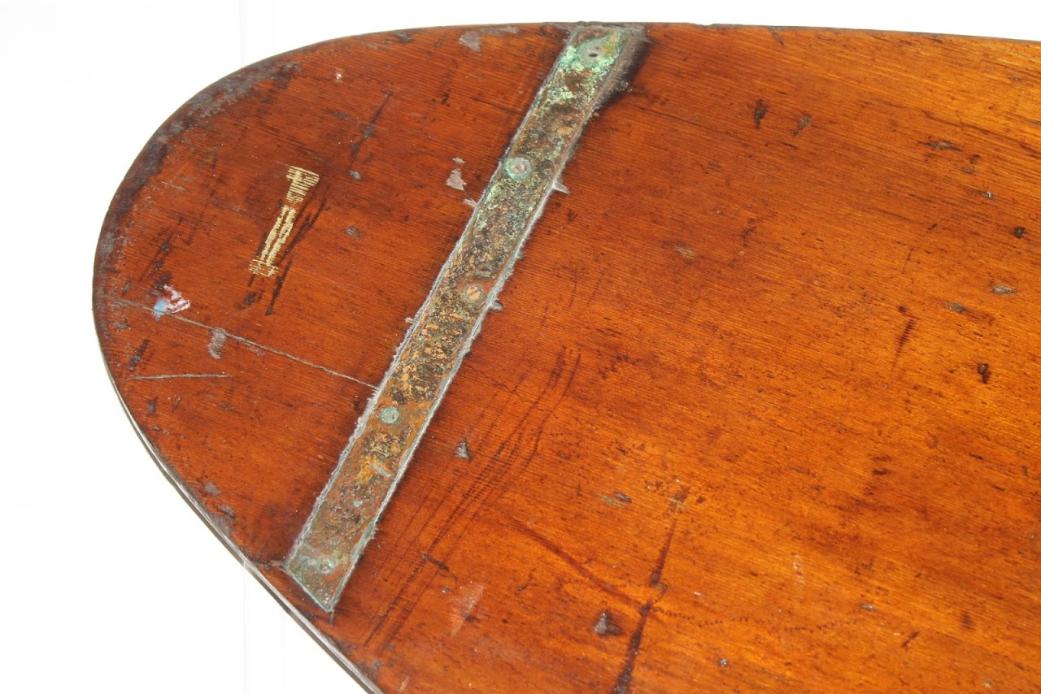
What’s in vapes? Toxins, heavy metals, maybe radioactive polonium

If you asked me what’s in e-cigarettes, disposable vapes or e-liquids, my short answer would be “we don’t fully know”.
The huge and increasing range of products and flavours on the market, changes to ingredients when they are heated or interact with each other, and inadequate labelling make this a complicated question to answer.
Analytical chemistry, including my own team’s research, gives some answers. But understanding the health impacts adds another level of complexity. E-cigarettes’ risk to health varies depending on many factors including which device or flavours are used, and how people use them.
So vapers just don’t know what they’re inhaling and cannot be certain of the health impacts.
What Do We Know?
Despite these complexities, there are some consistencies between what different laboratories find.
Ingredients include nicotine, flavouring chemicals, and the liquids that carry them – primarily propylene glycol and glycerine.
Concerningly, we also find volatile organic compounds, particulate matter and carcinogens (agents that can cause cancer), many of which we know are harmful.
Our previous research also found 2-chlorophenol in about half of e-liquids users buy to top-up re-fillable e-cigarettes. This is one example of a chemical with no valid reason to be there. Globally, it’s classified as “harmful if inhaled”. Its presence is likely due to contamination during manufacturing.
How About Polonium?
One potential ingredient that has been in the news in recent weeks is radioactive polonium-210, the same substance used to assassinate former Russian spy Alexander Litvinenko in 2006. The Queensland government is now testing vapes for it.
Polonium-210 can be found in traditional cigarettes and other tobacco products. That’s because tobacco plants absorb it and other radioactive materials from the soil, air and high-phosphate fertiliser.
Whether polonium-210 is found in aerosols produced by e-cigarettes remains to be seen. Although it is feasible if the glycerine in e-liquids comes from plants and similar fertilisers are used to grow them.
It’s Not Just The Ingredients
Aside from their ingredients, the materials e-cigarette devices are made from can end up in our bodies.
Toxic metals and related substances such as arsenic, lead, chromium and nickel can be detected in both e-liquids and vapers’ urine, saliva and blood.
These substances can pose serious health risks (such as being carcinogenic). They can leach from several parts of an e-cigarette, including the heating coil, wires and soldered joints.

That’s Not All
The process of heating e-liquids to create an inhalable aerosol also changes their chemical make-up to produce degradation products.
These include:
formaldehyde (a substance used to embalm dead bodies)
acetaldehyde (a key substance that contributes to a hangover after drinking alcohol)
acrolein (used as a chemical weapon in the first world war and now used as a herbicide).
These chemicals are often detected in e-cigarette samples. However due to different devices and how the samples are collected, the levels measured vary widely between studies.
Often, the levels are very low, leading to proponents of vaping arguing e-cigarettes are far safer than tobacco smoking.
But this argument does not acknowledge that many e-cigarette users (particularly adolescents) were or are not cigarette smokers, meaning a better comparison is between e-cigarette use and breathing “fresh” air.
An e-cigarette user is undoubtedly exposed to more toxins and harmful substances than a non-smoker. People who buy tobacco cigarettes are also confronted with a plethora of warnings about the hazards of smoking, while vapers generally are not.
How About Labelling?
This leads to another reason why it’s impossible to tell what is in vapes – the lack of information, including warnings, on the label.
Even if labels are present, they don’t always reflect what’s in the product. Nicotine concentration of e-liquids is often quite different to what is on the label, and “nicotine-free” e-liquids often contain nicotine.
Products are also labelled with generic flavour names such as “berry” or “tobacco”. But there is no way for a user to know what chemicals have been added to make those “berry” or “tobacco” flavours or the changes in these chemicals that may occur with heating and/or interacting with other ingredients and the device components. “Berry” flavour alone could be made from more than 35 different chemicals.
Flavouring chemicals may be “food grade” or classified as safe-to-eat. However mixing them into e-liquids, heating and inhaling them is a very different type of exposure, compared to eating them.
One example is benzaldehyde (an almond flavouring). When this is inhaled, it impairs the immune function of lung cells. This could potentially reduce a vaper’s ability to deal with other inhaled toxins, or respiratory infections.
Benzaldehyde is one of only eight banned e-liquid ingredients in Australia. The list is so short because we don’t have enough information on the health effects if inhaled of other flavouring chemicals, and their interactions with other e-liquid ingredients.
Where To Next?
For us to better assess the health risks of vapes, we need to learn more about:
what happens when flavour chemicals are heated and inhaled
the interactions between different e-liquid ingredients
what other contaminants may be present in e-liquids
new, potentially harmful, substances in e-cigarettes.
Finally, we need to know more about how people use e-cigarettes so we can better understand and quantify the health risks in the real world.![]()
Alexander Larcombe, Associate Professor and Head of Respiratory Environmental Health, Telethon Kids Institute
This article is republished from The Conversation under a Creative Commons license. Read the original article.
Do I have the right bicycle helmet and how can I tell if it’s any good? A bike helmet researcher explains
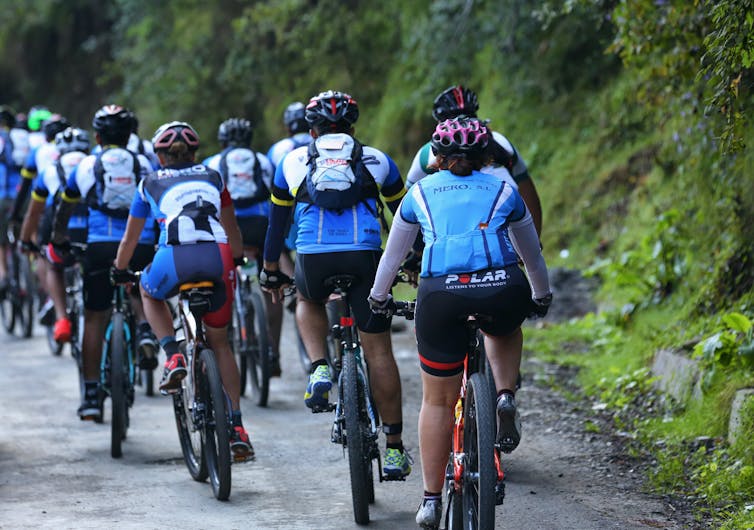
If you ride a bike and want to cut your risk of traumatic head injury, you should wear a helmet. A major Australian review of 40 different studies and 64,000 injured cyclists worldwide showed wearing a bicycle helmet reduces the risk of serious head injury by nearly 70%.
But there’s a bewildering array of designs out there. How do you know if yours is up to scratch or when it’s time to replace it?
I’m a head injury biomechanics researcher who has researched on bicycle helmet designs. Here’s what you need to know about choosing a bike helmet.

The Parts Of The Helmet
A typical bicycle helmet consists of a plastic shell, foam-like liner and the straps that keep it on your head.
The shell prevents any sharp penetration. The liner – usually made of expanded polystyrene foam or expanded polypropylene – absorbs the impact energy that would otherwise be colliding dangerously with your head.
In Australia, bicycle helmets must be certified to the mandatory Australian and New Zealand standard (the technical name for this standard is “AS/NZS 2063 — Bicycle helmets”).
This is a very robust safety regulation, and means the helmet has to be tested for:
impact attenuation (how well it absorbs impact),
load distribution (how well force is spread out over a larger area, so as to reduce the risk),
strength, and
effectiveness of the strap retention system (how well the helmet stays on your head).
So check your helmet to see if it says “AS/NZS 2063” on it somewhere (usually on a sticker inside it).
However, it’s worth noting these tests mostly look at the helmet’s ability to reduce the translational force (a force which causes an object to move in a single direction) of a direct impact.
They don’t properly consider the damage done by what’s called “rotational forces” – when the head is hit at an angle, causing it to shift abruptly.
This can cause the brain to rotate inside the skull, leading to severe and irreversible brain damage.
Bike Helmet Technology Is Always Changing
A recent review by colleagues and I at Swinburne University of Technology looked at bicycle helmet design technologies that may reduce the risk caused by rotational forces.
The best known one is called a “multi-directional impact protection system” (sometimes abbreviated as MIPS). This design allows the helmet shell to rotate around the inner liner, so the helmet absorbs some of the angular forces that would otherwise be transmitted to your head.
You can tell whether a helmet is MIPS-equipped by looking for a small yellow MIPS logo from the outside or a thin yellow liner beneath the pads on the inside.

Another fancy helmet technology is called an “omni-directional suspension system” (ODS), which has double liner layers connected by special rubbery materials. If you want this feature, look for a white, red and black ODS logo on the helmet shell.
Then there are “shearing pads inside” helmets (also known as SPIN helmets), which features silicone-injected pads in a structure that moves inside the shell.
These help redirect rotational forces when the rider’s head is hit in an accident. Helmets with this feature usually have a SPIN logo on the helmet shell or blue strips on the inside.
A few bicycle helmets use special collapsible liners to reduce the stiffness of shearing in the helmet. Helmets that feature this technology may have words like AIM (which stands for angular impact mitigation), WaveCel and HEXR on them.
My team at Swinburne is developing a bio-inspired flexible structure which can potentially be used as a bicycle helmet liner, and we are currently conducting tests in our Impact Engineering Laboratory. We’re also working on a helmet design featuring an inflatable airbag in a traditional bike helmet.
How To Pick A Helmet
When choosing a helmet in the shop, pick one that fits comfortably yet firmly on your head and can’t be tilted for more than an inch in any direction.
It should be snug but not annoyingly tight; you’re less likely to wear it if it’s uncomfortable.
Ensure the helmet complies with the national or international bicycle helmet standards, which should be stated on the label inside the helmet.
You may consider buying a helmet featuring one of the advanced protection technologies mentioned earlier (things like AIM, MIPS, SPIN or ODS), as these can help mitigate rotation-induced traumatic brain injury if your head gets hit at an angle.
Pick a helmet with a thicker liner, as long as it’s still comfortable enough to wear properly when riding. Thicker liners tend to absorb more impact energy because they have a longer crushing zone (a bit like how a car with a longer hood in the front has a longer crush zone before the impact hits the driver).
Ideally, choose one just firm enough to minimise impact forces without “bottoming out” (where the impact crushes and flattens the liner).
Denser foams resist very hard impacts better before crushing to their ultimate limit. Once a foam reaches its crush limit, the remaining impact energy is transmitted to your head. Softer foams compress or crush more easily in lighter impacts, giving better protection against milder injuries.
You never know what kind of accident you will have, so it’s better to choose a helmet with both dense and soft foam layers in the liner.

Should You Replace Your Helmet Every Few Years Anyway?
The US Consumer Product Safety Commission says it might be prudent replace your bike helmet between five and ten years after you bought it.
But an Australian Competition and Consumer Commission (ACCC) spokesperson told The Conversation the lifespan of a bicycle helmet is not set by time alone; it depends on its use pattern.
The ACCC suggests a bicycle helmet should be replaced if:
it’s showing obvious signs of wear and tear (a helmet that is used more often is likely to show more wear and tear sooner)
it’s showing sign of damage (cracks, pieces missing, compression of the foam, frayed straps)
it has been involved in an accident and has received a severe blow (even if it appears undamaged, you should destroy and replace it).

Kwong Ming (KM) Tse, Senior lecturer in Department of Mechanical Engineering and Product Design Engineering, Swinburne University of Technology
This article is republished from The Conversation under a Creative Commons license. Read the original article.
‘City killers’ and half-giraffes: how many scary asteroids really go past Earth every year?
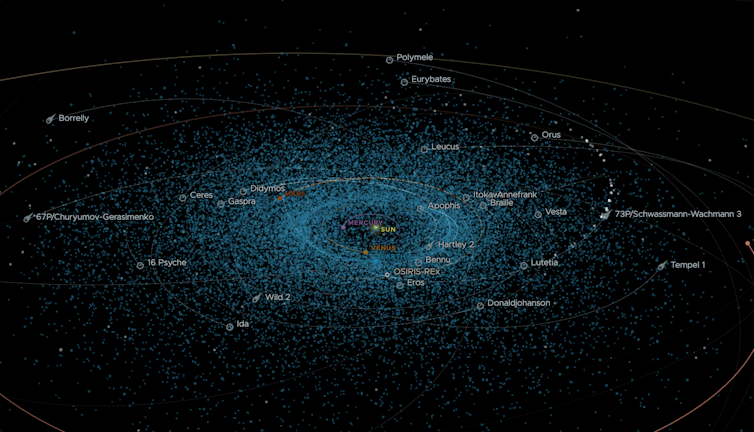
Asteroids are chunks of rock left over from the formation of our Solar System. Approximately half a billion asteroids with sizes greater than four metres in diameter orbit the Sun, travelling through our Solar System at speeds up to about 30 kilometres per second – about the same speed as Earth.
Asteroids are certainly good at capturing the public imagination. This follows many Hollywood movies imagining the destruction they could cause if a big one hits Earth.
Almost every week we see online headlines describing asteroids the size of a “bus”, “truck”, “vending machine”, “half the size of a giraffe”, or indeed a whole giraffe. We have also had headlines warning of “city killer”, “planet killer” and “God of Chaos” asteroids.
Of course, the threats asteroids pose are real. Famously, about 65 million years ago, life on Earth was brought to its knees by what was likely the impact of a big asteroid, killing off most dinosaurs. Even a four-metre object (half a giraffe, say) travelling at a relative speed of up to 60 kilometres per second is going to pack a punch.
But beyond the media labels, what are the risks, by the numbers? How many asteroids hit Earth and how many can we expect to zip past us?
What Is The Threat Of A Direct Hit?
In terms of asteroids hitting Earth, and their impact, the graphic below from NASA summarises the general risks.
There are far more small asteroids than large asteroids, and small asteroids cause much less damage than large asteroids.
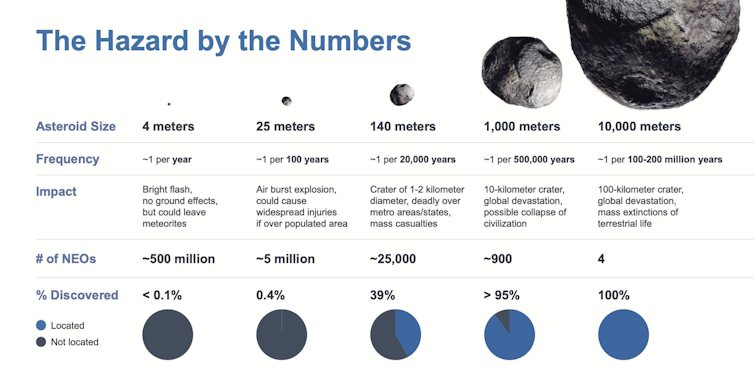
So, Earth experiences frequent but low-impact collisions with small asteroids, and rare but high-impact collisions with big asteroids. In most cases, the smallest asteroids largely break up when they hit Earth’s atmosphere, and don’t even make it down to the surface.
When a small asteroid (or meteoroid, an object smaller than an asteroid) hits Earth’s atmosphere, it produces a spectacular “fireball” – a very long-lasting and bright version of a shooting star, or meteor. If any surviving bits of the object hit the ground, they are called meteorites. Most of the object burns up in the atmosphere.
How Many Asteroids Fly Right Past Earth?
A very simplified calculation gives you a sense for how many asteroids you might expect to come close to our planet.
The numbers in the graphic above estimate how many asteroids could hit Earth every year. Now, let’s take the case of four-metre asteroids. Once per year, on average, a four-metre asteroid will intersect the surface of Earth.
If you doubled that surface area, you’d get two per year. Earth’s radius is 6,400km. A sphere with twice the surface area has a radius of 9,000km. So, approximately once per year, a four-metre asteroid will come within 2,600km of the surface of Earth – the difference between 9,000km and 6,400km.
Double the surface area again and you could expect two per year within 6,400km of Earth’s surface, and so on. This tallies pretty well with recent records of close approaches.
A few thousand kilometres is a pretty big distance for objects a handful of metres in size, but most of the asteroids covered in the media are passing at much, much larger distances.
Astronomers consider anything passing closer than the Moon – approximately 300,000km – to be a “close approach”. “Close” for an astronomer is not generally what a member of the public would call “close”.
In 2022 there were 126 close approaches, and in 2023 we’ve had 50 so far.
Now, consider really big asteroids, bigger than one kilometre in diameter. The same highly simplified logic as above can be applied. For every such impact that could threaten civilisation, occurring once every half a million years or so, we could expect thousands of near misses (closer than the Moon) in the same period of time.
Such an event will occur in 2029, when asteroid 153814 (2001 WN5) will pass 248,700km from Earth.
How Do We Assess Threats And What Can We Do About It?
Approximately 95% of asteroids of size greater than one kilometre are estimated to have already been discovered, and the skies are constantly being searched for the remaining 5%. When a new one is found, astronomers take extensive observations to assess any threat to Earth.
The Torino Scale categorises predicted threats up to 100 years into the future, the scale being from 0 (no hazard) to 10 (certain collision with big object).
Currently, all known objects have a rating of zero. No known object to date has had a rating above 4 (a close encounter, meriting attention by astronomers).
So, rather than hearing about giraffes, vending machines, or trucks, what we really want to know from the media is the rating an asteroid has on the Torino Scale.
Finally, technology has advanced to the point we have a chance to do something if we ever do face a big number on the Torino Scale. Recently, the DART mission collided a spacecraft into an asteroid, changing its trajectory. In the future, it is plausible that such an action, with enough lead time, could help to protect Earth from collision.![]()
Steven Tingay, John Curtin Distinguished Professor (Radio Astronomy), Curtin University
This article is republished from The Conversation under a Creative Commons license. Read the original article.
The strange history of ice cream flavours – from brown bread to Parmesan and paté

English Heritage is now selling what it calls “the best thing since sliced bread” at 13 of its sites – brown bread ice cream, inspired by a Georgian recipe. The announcement of the flavour mentions several more outlandish Georgian flavours trialled by English Heritage before it landed on brown bread, such as Parmesan and cucumber.
English Heritage is not alone in its efforts to beguile visitors with historical treats. In Edinburgh, the National Trust for Scotland’s Gladstone’s Land features an ice cream parlour linked to the dairy which stood there in 1904. The property sells elderflower and lemon curd ice cream based on a recipe from 1770, and visitors can go on several food-themed tours.
While brown bread ice cream, praised for its caramel nuttiness, may be a more familiar flavour to contemporary eaters than other historical offerings, the iced delights eaten in Britain in previous centuries took a huge variety of flavours and forms.
Agnes Marshall, the authority on ice cream during the late 19th century, published two cookbooks specifically about “ices” (1885) and “fancy ices” (1894). They included flavours from an elaborately moulded and coloured iced spinach à la crème, to little devilled ices in cups.

The latter consisted of a chicken pâté spiked with curry powder and Worcestershire sauce, egg yolks and anchovies, which was then mixed with gravy, gelatine and whipped cream, before being frozen in decorative cups and served “for a luncheon or second-course dish”.
Earlier texts contain even more outlandish flavours alongside the typical, sweet offerings.
French foodie Monsieur Emy’s L’Art de Bien Faire les Glaces d’Office (1768) has recipes for truffle, saffron and various cheese-flavoured ice creams.
The History Of Ice Cream
By the time Marshall was publishing, ice cream was far more accessible to the public than in earlier centuries. Prior to the 1800s, ice was collected from frozen waterways and stored in underground ice houses, largely restricted to large estates with the necessary land, wealth and resources.
From the 1820s, however, ice was imported to Britain from Europe and then the US and stored in ice wells and warehouses. The importation of larger stocks of ice reduced costs, while simultaneously, innovators were designing apparatus for mechanical freezing.
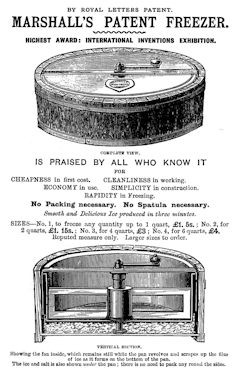
It would be a long time until ice was easily produced within the home, but cheaper ice made ice cream more readily available and implements were devised so it could be made at home. Both Emy and Marshall’s cookbooks depicting ice cream makers and Marshall’s patent freezer enlisted the same freezing technique as Emy’s Sarbotiere et son Seau (pot freezer and bucket).
Ice and salt were placed around a bucket, within which a custard or water mixture was stirred or rotated until it froze. Marshall’s innovation was the shallow pan, which gave an increased surface area for faster freezing. Equipped with such a freezer (and perhaps Marshall’s patent Ice Cave, for storing the ices), middle-class housewives could produce ice cream in their own kitchens.
Ice Cream And Leisure
Ice cream is well suited for engaging visitors at heritage properties today, not because of the history of how it was produced within the home but because of its holiday connotations. Whether it is a “99”, an “oyster” enjoyed at the beach, or the nearing jingle of an ice cream truck, ice cream has clear cultural and emotional links to recreation and enjoyment. This was also true in the past.
In 19th century Britain, street vendors (many of them Italian immigrants) began selling penny licks, or “hokey-pokey” from stalls or carts in the streets. In contrast to the immaculately-moulded delicacies in Marshall’s cookbook – which required the purchase of several pieces of equipment – this ice cream was to be enjoyed while out and about. It was also cheap, as implied by “penny” in the title.
Customers would purchase their ice upon a glass “lick”, eat it and then return the lick to the vendor for reuse. With growing numbers of seaside resorts and the rise of the leisure industry over the 19th century, ices were enjoyed while on holiday or daily excursions and at public events like exhibitions or fairs.

It is the portability of ice cream, as well as its culinary appeal, that has led to its lasting place in our leisure time – a delicious treat that can be enjoyed, one-handed, as part of a larger experience. The act of eating ice cream prepared from a Georgian or Victorian recipe therefore connects today’s visitors to a long tradition of enjoying ices recreationally.
While heritage properties are unlikely to embrace the more unsanitary ways ice cream used to be eaten, serving up historical recipes gives visitors a chance to savour a new sensory layer of the past. That taste can be linked into larger histories. From ice cream, we can learn about technological developments, changing attitudes towards sanitation, global travel, the availability of ingredients throughout time, trends, fashion and leisure habits.
Delving into the history of food – from the tins in our cupboards, to a cup of tea, or an ice cream at the beach – can bring new perspective to both the past and the present.

Looking for something good? Cut through the noise with a carefully curated selection of the latest releases, live events and exhibitions, straight to your inbox every fortnight, on Fridays. Sign up here.![]()
Lindsay Middleton, Food Historian and Knowledge Exchange Associate, University of Glasgow
This article is republished from The Conversation under a Creative Commons license. Read the original article.
Foreign interference through social media is an active threat. Here’s what Australia can do

Last week, a special Senate committee released a report on foreign interference through social media.
It makes for scary reading. In addition to widely publicised criticisms of WeChat and TikTok – social media platforms owned by Chinese companies – the committee found US-based platforms like X (formerly known as Twitter), Meta, LinkedIn and YouTube have been targeted by foreign interference campaigns.
Yet no one has been convicted for foreign interference since Australian law reforms on this were passed in 2018. So, what’s going on?
What Did The Report Find?
The inquiry heard evidence of actual interference in Australia carried out using social media, such as fake Russian accounts used to stalk Ukrainians in Australia, and death threats made against foreign journalists.
Among its 17 recommendations, the report proposes transparency standards for social media companies. This includes requiring companies to have a physical presence in Australia (such as offices). A lack of this presence was one of the main reasons WeChat couldn’t be compelled to give evidence during the inquiry.
The report also recommends companies which don’t comply with the transparency standards should face massive fines or even be banned from operating in Australia.
TikTok and WeChat were also called out by the committee, with pressure building to ban those platforms from critical businesses like banks, airports and electricity providers. This is in addition to bans already in place for government-issued devices, as well as some of the large consultancy firms that work for the government.
The report also highlights the threat posed by generative AI in fuelling disinformation. On top of this, it recommends a full review of our espionage and foreign interference laws.
Our Current Foreign Interference System
Australia already has some of the toughest laws in the world when it comes to criminalising threats to our national security, like espionage, foreign interference, and stealing classified information. These reforms were introduced in 2018 specifically to address the rising threat posed by foreign actors.
But foreign interference hasn’t gone away. In 2021, parliament was handed another report, this time by the Joint Committee for Intelligence and Security, which looked at national security risks in universities. That report found Australian universities are at risk of being infiltrated by foreign agents looking to steal scientific research and technology.
In 2022, the Australian Security Intelligence Organisation (ASIO) revealed its officers had disrupted an actual attempt to interfere with an election in Australia.
A wealthy individual with deep connections to a foreign government had hired an employee to identify electoral candidates who would support the interests of said foreign government. They then plotted to advance the candidates’ political prospects through generous support and favourable articles on foreign language news platforms. But their plans were disrupted by ASIO before they could act.
Despite clear instances of foreign interference occurring in Australia, only two people have been charged under the 2018 laws. The first case alleged that Di Sanh Duong – a prominent member of the Melbourne business community – was in league with Chinese intelligence officers.
The second charge involved Sydney businessman Alexander Csergo, again alleging he provided reports to Chinese intelligence. Both are still awaiting trial.

Why Have There Been So Few Cases?
In part, few people have been charged for foreign interference because the evidence needed to prosecute someone might divulge how Australian law enforcement and spy agencies keep their eyes out for this kind of activity.
This is where the laws designed to keep our national security information confidential in court have been strongly criticised.
Prosecutions of this kind also need to be approved by the Attorney-General. It is entirely possible the Attorney-General has declined to prosecute a person because the evidence didn’t stack up. However, that same law doesn’t prevent a person from being charged or held in remand.
Without more details from our security agencies – which aren’t likely to be forthcoming – we may never know how many people have been charged with a foreign interference offence but aren’t subsequently prosecuted because the Attorney-General did not consent to do so.
Another possibility why few people have been prosecuted for foreign interference is that it can be difficult to obtain the evidence needed to prove a particular person committed foreign interference. This is because it is easy to use anonymising technologies when engaging in foreign interference online, so it may not be possible to actually identify who committed the offence.
Even if the person can be identified, if they are located overseas they would have to be extradited to Australia to face prosecution. This can be a challenging – if not impossible – process.
What Needs To Be Done
Further reforms to Australia’s espionage and foreign interference laws probably aren’t necessary. The laws are already strong enough and, if anything, are too broad as they are. For example, they have the capacity to criminalise the legitimate work of journalists and academics. This can undermine core liberal democratic rights such as press freedom and academic freedom.
Rather than reform espionage and foreign interference laws, the government could focus on making changes to regulate the conduct of social media companies. For example, social media companies could be required to take reasonable steps to prevent foreign interference from occurring via their platforms. Failure to do so could be regulated in a number of ways, such as civil and/or criminal penalties if appropriate.
However, in doing so it is important the government works with social media companies to ensure we get the laws right.

In addition to law reform, government needs to resource law enforcement and intelligence agencies so they can take the actions needed to enforce existing foreign interference laws.
New transparency standards and reformed legislation won’t make a difference if the Australian Federal Police won’t – or can’t – investigate and help prosecute those responsible. If the committee’s recommendations go ahead, putting a banning power in the hands of a minister is only helpful when this power gets used.
We shouldn’t forget the power of users either. Australians could consider whether they should join the 30% of WeChat users who have already ditched the platform over interference and surveillance risks.
Additionally, we all have a role to play in fighting disinformation and social media hatred. Being responsible sharers of content and checking our facts could go just as far in combating disinformation as locking up those responsible.![]()
Brendan Walker-Munro, Senior Research Fellow, The University of Queensland and Sarah Kendall, PhD Candidate in Law, The University of Queensland
This article is republished from The Conversation under a Creative Commons license. Read the original article.
A brief illustrated guide to ‘scissors congruence’ − an ancient geometric idea that’s still Fuelling cutting-edge mathematical research

In math class, you probably learned how to compute the area of lots of different shapes by memorizing algebraic formulas. Remember “base x height” for rectangles and “½ base x height” for triangles? Or “𝜋 x radius²” for circles?
But if you were in math class in ancient Greece, you might have learned something very different. Ancient Greek mathematicians, such as Euclid, thought of area as something geometric, not algebraic. Euclid’s geometric perspective, recorded in his foundational work “Elements,” has influenced research programs across centuries – even the work of mathematicians today, like the two of us.

Modern mathematicians refer to Euclid’s concept of “having equal area” as “being scissors congruent.” This idea, based on cutting up shapes and pasting them back together in different ways, has inspired interesting mathematics beyond just computing areas of triangles and squares. The story of scissors congruence demonstrates how classical problems in geometry can find new life in the strange world of abstract modern math.
Euclid’s Notion Of Area
Today, people think of the area of a shape as a single number that can be computed using algebraic formulas or calculus. So what does it mean to think of area as something geometric the way the ancient Greeks did?
Imagine you’re back in math class and you have a pair of scissors, some tape and a piece of construction paper. Your teacher instructs you to make a new flat, two-dimensional shape using all of the construction paper and only straight-line cuts. Using your scissors, you cut the paper into a bunch of pieces. You start moving these pieces around – maybe you rotate them or flip them over – and you tape them back together to form a new shape.

Using your algebraic formulas for area, you could check that the area of your new shape is equal to the original area of the construction paper. No matter how a 2D shape is cut up – as long as all the pieces are taped back together without overlap – the area of the old and the new shape will always be equal.

For Euclid, area is the measurement that is preserved by this geometric “cutting-and-pasting.” He would say that the new shape you made is “equal” to the original piece of construction paper – mathematicians today would say the two are “scissors congruent.”
What can your new shape look like? Because you’re only allowed to make straight-line cuts, it has to be a polygon, meaning none of the sides can be curved.

Could you have made any possible polygon with the same area as your original piece of paper? The answer, amazingly, is yes – there’s even a step-by-step guide from the 1800s that tells you exactly how to do it.
In other words, for polygons, Euclid’s notion of area is exactly the same as the modern one. In fact, you may have even used Euclid’s idea of area before in computations without knowing it.
For example, you can use scissors congruence to compute the area of a pentagon. Since area is preserved if you cut the pentagon up into smaller triangles, you can instead find the area of these triangles (using “½ base x height”) and add them up to get the answer.

Hilbert’s Third Problem
Perhaps the most infamous appearance of scissors congruence is on the famous German mathematician David Hilbert’s list of problems, which consisted of some of the most important mathematical questions of the 1900s. Of the original 23 problems Hilbert proposed, some have been solved, some have been shown to be unsolvable and others are still unresolved. The third problem on the list, and the first to be resolved, is about scissors congruence.
Instead of two-dimensional polygons, Hilbert asked about their three-dimensional cousins: polyhedra. Euclid’s notion of scissors congruence was known to be an accurate description of two-dimensional area, but could it be a good notion of three-dimensional volume?

The answer came within a year, provided by one of Hilbert’s students, Max Dehn. Dehn’s solution to the problem was very different from the two-dimensional case. He showed that when polyhedra are cut up, volume is not the only thing that is preserved. There is another preserved measurement, now called the Dehn invariant, which is constructed from the lengths of edges and the angles between the faces of the polyhedron.
If two polyhedra are scissors congruent, then they have to have the same Dehn invariant. So, if Dehn could find two polyhedra with the same volume but different values of this invariant, that would prove the answer to Hilbert’s third problem is no – scissors congruence doesn’t precisely capture 3D volume.

This is exactly what Dehn did, showing that the invariants associated to a cube and tetrahedron with the same volume are different. This means that there’s no possible way to cut up a tetrahedron into a finite number of pieces and reassemble them back into a cube with the same volume.
Are volume and the Dehn invariant all we need to know? If two polyhedra have the same volume and the same Dehn invariant, does that tell us they’re scissors congruent? It took mathematicians another 60 years to answer this question. In 1965, Jean-Pierre Sydler confirmed that the answer is yes, closing this chapter on scissors congruence.
Strange Shapes And Stranger Connections
But the story doesn’t end there. Mathematics is full of shapes living in higher dimensions – like 4D, 100D, 3,485D or any dimension you can imagine – which are impossible to visualize. An active new research area called generalized scissors congruence seeks to uncover whether Hilbert’s question about scissors congruence can also be stated – and maybe even solved – for these strange shapes.

However, what it means for two things to be scissors congruent is now far more complicated. While Hilbert and Dehn cared about things like volume and angles, other mathematicians could exchange these physical traits for something far less tangible.
A recent research program pioneered by mathematicians Jonathan Campbell and Inna Zakharevich proposes a unifying framework for generalized scissors congruence. This framework is built using a very abstract, seemingly unrelated mathematical toolkit called algebraic K-theory.

The big idea of K-theory is that mathematical objects can be understood by how they decompose into fundamental building blocks – much like molecules are broken up into atoms. With a little bit of adjustment, mathematicians can harness the machinery of K-theory and apply it to generalized scissors congruence problems.
This use of K-theory reimagines the problem of scissors congruence and opens the doors for future research. But at the end of the day, scissors congruence is a concrete idea that you don’t need fancy math to understand – just some patience, creativity, a pair of scissors and a lot of tape.![]()
Maxine Calle, Ph.D. Candidate in Mathematics, University of Pennsylvania and Mona Merling, Assistant Professor of Mathematics, University of Pennsylvania
This article is republished from The Conversation under a Creative Commons license. Read the original article.
Taylor Swift’s Eras Tour is a potent reminder that the internet is not real life

In the weeks leading up to June 16, 2023, when I attended the Pittsburgh leg of Taylor Swift’s Eras Tour, the online chatter about the 33-year-old singer had become draining.
The internet was ablaze with rumors about Swift dating Matty Healy, the lead singer of the English pop-rock band The 1975. Some Swifties – the term used for diehard Taylor Swift fans – berated the pop superstar for dating Healy, who’d become mired in controversy for appearing on a podcast whose hosts made racist comments about the rapper Ice Spice.
As the Pittsburgh leg of the tour approached, I wondered if I were about to dive headfirst into an angry mob of tens of thousands of Swifties.
On the day of the show, Acrisure Stadium was mobbed with 72,000 people, but the Swifties in attendance were far from angry.
In that moment we became deeply connected by our shared love and admiration for Swift’s music. Sociologist Emile Durkheim described this phenomenon as “collective effervescence,” the unique surge in feeling when large groups of people come together for a shared purpose.
“It was rare, I was there, I was there,” Swift belted out during “All Too Well.”
I was there, too, as life events touched by Swift flashed by: sitting at my first desktop computer as a teenager in Kathmandu, Nepal, replaying “Love Story” on LimeWire; my first week in the U.S., during the 2009 MTV Video Music Awards, when Kanye West infamously interrupted Swift; how Swift’s eighth studio album, “Folklore,” brought me back to life after it seemed as if the world were on the verge of imploding in 2020.
Collective Delusion
The Eras Tour was not my first experience of collective effervescence. Nor was it the first time I felt such a strong disconnect between the online and offline worlds.
Right before the pandemic began, there was the painfully quiet fizzling out of the Bernie 2020 movement. As a volunteer for that campaign, I had the remarkable experience of connecting with other Americans who wanted a Bernie Sanders presidency.
I especially appreciated how this role connected me to the people who make up the Nepali diaspora in the U.S. We hoped to improve our immigrant experiences, whether it involved no longer fearing the deportation of loved ones or easier access to health care.
But then repeated news cycles about “toxic Bernie Bros” seemed to drain the movement’s momentum. Mainstream media outlets reported that Sanders’ base was made up of white male cyberbullies. Negative tweets had been amplified, and the words and behaviors of a few Sanders supporters all of a sudden were being portrayed as representative of an entire movement.
The contrast between what was being said online versus my own experiences was jarring: Here I was working to find transportation for 80-year-old Nepali grandmas who didn’t speak English but wanted to vote for Sanders.
Post-election analysis would show that the Bernie Bro trope was entirely constructed; there was no evidence to show that young white men made up a majority of Sanders’ supporters. The movement, in fact, consisted of a diverse coalition of people from marginalized races and genders.

A Vocal Minority Sets The Agenda
Online narratives distort real life more often than you might realize.
Research consistently shows that a small minority of people who have social media accounts post the vast majority of content.
In what’s termed the “90-9-1 rule,” 90% of users on these websites only “lurk” or read content, 9% of the users reply or re-post with occasional new contributions, and only 1% of the users frequently create new content.
Pioneered by Jakob Neilson, the 90-9-1 rule is one of many theories within internet studies that describe participation rates, and different scholars find support for different variations of this rule. Reddit, for example, has over 1 billion monthly active users, but according to a 2017 conference paper, an overwhelming majority of Reddit users are lurkers. X, the website and app formerly known as Twitter, had around 350 million users as of 2023; however, research from 2019 found that 75% of its users were lurkers.
In other words, most of the discussions happening on websites like Reddit and Twitter come from a vocal minority of users – whose posts are then curated and boosted by algorithms.
Nonetheless, in the past decade, the news media have increasingly constructed narratives about collective reality based on what happens in these websites.
Of course, toxic online behavior exists in all online communities. But it represents the words of a smaller minority of users within the already small minority of people who post content online. Media narratives that emphasize certain groups as toxic based on online behavior – whether they are describing fandom or politics – fall into the trap of confusing the internet with real life.
In the weeks when Swift was dating Healy, a vocal minority of Swifties came head-to-head with a vocal minority of Healy’s defenders. Then the celebrity pair ended their relationship, and collective attention moved on from that topic almost immediately.
Several weeks of nonstop debate, attacks and hand-wringing ended up being utterly meaningless – except to social media companies that converted this brief obsession into clicks, engagement and ad revenue.
My forthcoming book, “Attention and Alienation,” brings renewed focus to an increasingly demystified phenomenon: The online attention economy maximizes profits by designing algorithms that boost engagement, particularly by promoting negativity and outrage.
Oligarchy Of The ‘Extremely Online’
Sometimes the consequences of mistaking the internet for real life are dire.
Take reproductive health. Online rage about the Supreme Court’s decisions to overturn Roe. v. Wade peaked within a few days and people moved on to different topics.
Today, reports about reproductive health care take up very little news media space compared with garden-variety trending topics like “Barbenheimer” – the double blockbuster release of the movies “Barbie” and “Oppenheimer” on July 21, 2023.
In the real world, many people continue to suffer from lack of access to lifesaving reproductive health care across the U.S., while the online chattering class celebrates the radical feminism of the “Barbie” movie.
Perhaps it’s time to sideline social media and the internet when evaluating the nature of our collective reality. Reality exists outside of our devices, whereas social media algorithms push whatever keeps us tethered to the screen. There is little evidence to support the idea that online discourse represents collective experiences.
That might be easier said than done: 94% of journalists say they use social media for their jobs.
But as an internet researcher – and Taylor Swift fan – I am hopeful that experiences like the Eras Tour will wake up more people to the fact that human beings are more united than social media algorithms would have us believe.![]()
Aarushi Bhandari, Assistant Professor of Sociology, Davidson College
This article is republished from The Conversation under a Creative Commons license. Read the original article.
Through space and rhyme: How hip-hop uses Afrofuturism to take listeners on journeys of empowerment

It is perhaps only natural, as hip-hop celebrates its 50th anniversary, that people look to the genre’s future. But for some rappers, the future has always been part of the story.
Ever since August 1973, hip-hop artists have turned to Afrofuturism – a mix of science fiction, politics and liberating fantasy – to inform their lyrics and their look.
As a professor of African diaspora religious philosophies and a fan of hip-hop, I’ve long been interested in intersections between Afrofuturism and hip-hop. I have found that hip-hop artists from the 1970s onward have employed Afrofuturism as a means to help Black Americans overcome isolation and racism. They do so by taking listeners on journeys in and beyond the here and now, from an often imagined past to an imaginative future. And through that journey comes greater self-clarity, self-empowerment and self-determination.
Black Diaspora Ancestors
Author and lecturer Mark Dery is credited with coining the term “Afrofuturism” in his 1994 essay “Black to the Future.” In it, he describes the concept as “speculative fiction that treats African-American themes and addresses African-American concerns in the context of twentieth century technoculture.” More broadly, he adds, Afrofuturism uses tech-filled imagery to envision a better future.
Academics have since further explored the meaning of Afrofuturism. In her 2013 book “Afrofuturism: The World of Black Sci-Fi and Fantasy Culture,” independent scholar Ytasha Womack describes the cultural phenomenon as “an intersection of imagination, technology, the future, and liberation.”

Although the term appeared in the 1990s, Afrofuturism has been applied retroactively to describe Black writers, artists and musicians. In the United States, Afrofuturism was shepherded by generations of Black visionaries from the time of institutional slavery to the Civil Rights era. In fact, it predates hip-hop’s beginnings in 1973, and it developed independently from hip-hop throughout the years.
Octavia Butler, for example – the “mother of Afrofuturism” – decided that it was necessary to write her lived experience into science fiction, which was dominated by white male authors. From the 1970s to 2000s, she combined African mythology with social activism to conjure images of alternate Black worlds.
But perhaps more important in terms of its influence on hip-hop is the music of those associated with Afrofuturism, especially George Clinton, leader of the funk band Parliament-Funkadelic. Clinton blended sonic sounds, wore ornate Pan-African clothing and incorporated spaceship stagecraft called “The Mothership.”

Hip-hop artists often include snippets of Clinton’s music, such as on rapper and producer Dr. Dre’s album “The Chronic.”
Aliens And Alienation
Hip-hop artists influenced by Afrofuturism have long been aware that American society made many Black, Indigenous and other people of color feel different – less than human, or even like aliens – and expressed this through their art. And like socially conscious hip-hop, Afrofuturism has always had a political element.
Commentator Taylor Crumpton explains, “Afrofuturism has been woven into social movements that worked against white supremacy to move toward a future where radicalism is viewed, not as something to be fought, but a societal good.”
Numerous Black hip-hop songs that portray strange settings, space travel or life on other planets reinforce Afrofuturism’s emphasis on difference and otherness.

Take, for example, Public Enemy’s “Fear of a Black Planet,” Afrika Bambaataa & Soulsonic Force’s “Planet Rock” or Ras G’s “Brotha From Anotha Planet.” Similar to experimentalist jazz bandleader Sun Ra, who claims aliens selected him to preach cosmic enlightenment on Earth, the Atlanta-based duo Outkast – whose very name suggests alienation – refer to themselves as “ATliens”.

Such hip-hop artists offer mesmerizing messages, sounds and beats that seem to come from another world. They help listeners see life as an outsider. In so doing, the artists reclaim the alien moniker as an act of resistance.
Higher Levels Of Consciousness
Afrofuturism aims to elevate human consciousness. Like Sun Ra’s jazz fusion ensemble “Akestra,” which deliberately designed music to help people see themselves and the world differently, Afrofuturism seeks to decolonize human minds.
Cultural critic Greg Tate describes how Afrofuturism entered mainstream public awareness in 2018 with the release of the Marvel movie “Black Panther.” The film depicts an African kingdom whose advanced technology leads to a better world.
Kendrick Lamar, winner of the best rap album at the 2023 Grammys, recorded five of 14 songs on the Afrofuturist “Black Panther” movie soundtrack. One of them was “All the Stars.”
Journalist Taylor Hosking noted that in the music video for the song, “Lamar is on a voyage to (and through) Africa that starts in an ark-like vessel with a sea of hands waving below. The hands might call to mind the bodies of those who drowned during the Middle Passage, as well as a crowd of fans at a concert.”
Indeed, Lamar fuses African Americans’ desire to know what Africa was like prior to colonization to a futuristic pilgrimage that reimagines what it would be like to return to one’s ancestral roots.
The journey home may be different for everyone, but knowing the past can enhance one’s understanding of the present and outlook on the future.
Take Nothing For Granted
In “Africa As an Alien Future,” academic Ruth Mayer observes how Afrofuturism’s collapsing of past, present and future results in “strange sights – alien, aquatic, artificial – which force us not only to reconsider the past, but most of all the present we like to take for granted.”
Tupac Shakur and Dr. Dre’s dystopic video for “California Love,” for example, which was set in California in 2095 and includes a cameo appearance by George Clinton himself, evokes vivid images of turf war battles in a post-apocalyptic, climate change-ridden, desert wasteland with sparse water.
Afrofuturists challenge societal assumptions about Black Americans’ role in their country’s history, both then and in the future. This is a reason why I teach in my “Hip-Hop and Religion” class Tupac’s “Thugz Mansion.” In the song, Tupac not only reaffirms a core tenet of Afrofuturism – Black people will in fact survive and thrive in the future – he also visualizes a realm for them where peace is pervasive:
Dear mama don’t cry, your baby boy’s doing good /
Tell the homies I’m in heaven and they ain’t got hoods /
Seen a show with Marvin Gaye last night, it had me shook /
Drinking peppermint Schnapps, with Jackie Wilson, and Sam Cooke /
Then some lady named Billie Holiday /
Sang sitting there kicking it with Malcolm, ’til the day came /
All in all, Afrofuturism counsels marginalized peoples to reassess past wounds and present injustices, while reassuring them that there are possible futures where they can feel they belong. ![]()
Roy Whitaker, Associate Professor of Africana Philosophy of Religions and American Religious Diversity, San Diego State University
This article is republished from The Conversation under a Creative Commons license. Read the original article.
Efforts to find safe housing for homeless youth have gone backwards. Here’s what the new national plan must do differently
David MacKenzie, University of South Australia and Tammy Hand, UNSW SydneyWhat needs to change to greatly reduce youth homelessness in Australia? Now is the time to find answers to this question, and not just because it’s National Homelessness Week.
The federal government is developing a National Housing and Homelessness Plan and says public consultations will begin soon. In recent years, there have been two parliamentary inquiries into homelessness in Victoria and across Australia. Then came a Productivity Commission review of the National Housing and Homelessness Agreement, which expired on June 30 this year.
More than a decade ago, the Rudd government made homelessness a national priority. A 2008 white paper, The Road Home, advanced three key strategies:
- “turning off the tap” – early intervention and prevention
- “improving and expanding services” – the existing service system
- “breaking the cycle” – supported housing to prevent homelessness reoccurring.
Yet today more people need help because of homelessness than 15 years ago. The ambitious agenda of 2008 has not been fulfilled.
The forthcoming plan might just be a second chance for Australia to get it right.
Homelessness Is More Than ‘Sleeping Rough’
Homelessness conjures images of someone sleeping in a doorway, alley or city park. “Rough sleeping” is, after all, the visible homelessness that people see. But there are other forms of homelessness that are more hidden.
Some vocal advocates seek to model the Australian homelessness response on that of the United States. In the US, nearly 600,000 people are sleeping rough or in shelters. The rate of homelessness is at least ten times the rate in Australia.
A problem in the US is that homelessness is very narrowly defined. Fortunately, in Australia, homelessness has been understood and defined more broadly as not having a secure and safe home. So the good news is the new homelessness plan is unlikely to make the mistake of adopting the narrow US focus on rough sleeping.

Homelessness funding has largely gone into crisis management – that is, after people become homeless. An expanded role for “prevention” work coupled with supported housing options in each community would be a valuable strategic reform.
The Productivity Commission review recommended “prevention and early intervention programs should be a higher priority under the next agreement”, backed by “a separate pool of funding”. The commission even suggested:
The nearly $3 billion [annually] given to first home buyers works against improving affordability. This money would be better spent preventing homelessness.
Too many young Australians who become homeless and disengage from education then experience long-term disadvantage. The cost to Australia of their lost opportunities amounts to hundreds of millions of dollars a year.
We Have Examples Of Intervention That Works
There are promising early intervention models for at-risk young people that are ready to be scaled up. Examples include the COSS Model, Kids Under Cover, Ruby’s Reunification and Home Stretch programs. If implemented adequately, programs like these would greatly reduce the flow of young people into homelessness.
Housing affordability in Australia has worsened over a long time. For people whose homelessness cannot be averted, the immediate need is access to a crisis service, rapid rehousing and then supported housing options.
The Albanese government’s A$10 billion Housing Australia Future Fund could begin to turn the housing crisis around, but it would be only a beginning. All sides of politics need to get behind greater investment in high-quality social housing, shared equity home purchase programs (the government or another investor covers some of the purchase price in return for a share of equity in the home) and increased Commonwealth Rental Assistance. Government subsidies for the private housing sector, such as negative gearing, also need to be reviewed.
Homeless young people have little chance of getting into mainstream social housing when they most need supported housing to get their lives back on track. The social housing business model is not set up to provide supported housing for adolescents and young adults.
One notable innovation is the world’s first model of social housing for youth developed by My Foundations Youth Housing. It provides up to five years’ supported residency with rents scaling up annually. Most residents move on to other accommodation when ready to do so.
Get The Plan Right And It Can Be A Game-Changer
Expanding the social housing options for young people would have a significant impact. Should the Senate finally pass the Housing Australia Future Fund legislation, young people (15-24 years) could be guaranteed a specific share of that funding, as has been done for women escaping domestic violence and older women at risk of homelessness. This funding would go into expanding social housing for young people.
A key structural reform would be to reorganise support services for at-risk and homeless young Australians on a community-by-community basis. What’s needed is a rigorous approach to needs-based funding for both early intervention and post-homelessness support and supported housing.
Will the National Housing and Homelessness Plan be a game-changer for vulnerable young Australians? Well, that remains to be seen. We hope Australia can avoid a rerun of what happened after the 2008 white paper.![]()
David MacKenzie, Associate Professor, University of South Australia and Tammy Hand, Adjunct Senior Research Fellow, Gonski Institute for Education, UNSW Sydney
This article is republished from The Conversation under a Creative Commons license. Read the original article.
10 years of homegrown horror hits: Talk To Me and the golden age of Aussie horror
Jessica Balanzategui, RMIT UniversityThe past decade has been a golden one for Australian horror, bookended by The Babadook in 2014 and the current sensation Talk to Me.
The global premiere of Jennifer Kent’s groundbreaking supernatural bogeyman film at the 2014 Sundance Film Festival caused ripples that became a wave.
The Babadook attracted international acclaim, winning the New York Film Critics Circle Award for Best First Feature. The Exorcist’s director, William Friedkin, called it the most terrifying film he’d ever seen.
Talk to Me, the directorial feature debut of brothers Danny and Michael Philippou, also premiered internationally at Sundance, where it sparked a bidding war.
Now in cinemas, Talk to Me has surpassed industry projections to gross more than US$10 million (A$15.2 million) in North America on its opening weekend, and opened at number four in Australia. Talk to Me’s success story is not just commercial but critical: the film currently has a 94% approval rating on Rotten Tomatoes.
This horror high water mark carries the legacy of Australia’s strong horror history, while signalling the shedding of some cultural biases that have constrained our culture of innovation in spookery.
The Australian New Wave
Australia’s golden horror decade has roots in the Australian New Wave, a particularly productive period for Australian film from the 1970s to the late 1980s dominated by two key horror subgenres on opposing ends of the taste spectrum.
The high-brow Australian Gothic includes critically esteemed dramas Picnic at Hanging Rock (1975) and Walkabout (1971). These films are structured by enigmatic narratives with horror-tinged edges, in which the ethereal beauty of the bush also bears quasi-supernatural menace.
Low-brow Ozploitation films were popular in drive-in theatres, but often critically derided for their “tasteless” violence and sex and for cribbing flagrantly from Hollywood horror.
Classics of the genre include Razorback (1984), pitched as “Jaws on trotters” (the film features a murderous bush hog), and Patrick (1978), about a man in a coma with psychokinetic (and psychosexual) powers.
Ozploitation is often seen as the rebelliously gory, commercially oriented antagonist to the Australian Gothic’s highbrow works of art.
Destroying The High/Low Culture Binary
This binary persisted into the early 21st century. The international commercial success of homegrown horror hits such as Saw (2004) and Wolf Creek (2005) was often accompanied by domestic critical derision: Margaret Pomeranz and David Stratton refused to review Wolf Creek 2 (2013).
The horror films of the past decade tend to trample over this high/low genre binary.
These films experiment with art cinema aesthetics and deploy narrative strategies of prestige drama, echoing the Australian Gothic. However the supernatural elements are an explicit narrative structuring device, unashamedly emphasising their horror identities.
The ghosts and bogeymen of films like The Babadook, Relic (2020) and Talk to Me provoke shock and disgust, while also poetically expressing psychological turmoils that evade coherent explanation.
In The Babadook, this turmoil erupts from shared grief between mother and son. In Natalie Erika James’ debut feature Relic, a grandmother’s descent into dementia impels the reverberation of spectral traumas across three generations. In Talk to Me, a blossoming teen friendship is possessed by the unquiet spirit of the protagonist’s dead mother.
Alongside this nuanced dramatic core, Talk To Me pushes the boundaries of good taste with gleeful abandon in true Ozploitation style. It features gruesome possession-induced self-harm and more than 100 swear words. The narrative centres on a darkly comic analogy (instead of drug-taking, the teens become addicted to the occult pleasures of the talismanic hand) that would be at home in a grindhouse drive-in.
This play with high/low culture boundaries filters into Talk To Me’s play with audience emotions and expectations.
At times while watching, my body was tensely primed for a gory eye-gouging; instead I was met with a gentle moment of connection between two characters. At other moments, tender sequences give way unexpectedly to viscous spurts of blood.
The ghouls of this golden decade are at home on the red carpets of festivals such as Sundance, yet they also drip with the blood and bodily fluids of their Ozploitation forebears.
A Collective Energy
Our current golden age of horror has grown out of a collective creative energy.
The Philippou brothers worked on The Babadook as 19-year-olds and credit Kent’s influence as key to their creative approach.
The Babadook was the debut film from Australian production company Causeway Films, and Talk To Me is their latest picture, led by producer Samantha Jennings.
Jennings and Causeway have been critical to the collective currents that have propelled our golden horror decade. They also produced the conceptually layered zombie horror-drama Cargo (2017) and witch folk horror You Won’t Be Alone (2021), Australia’s submission for the Academy Awards for Best International Feature.
This decade of ingenuity has demonstrated Australian horror films can find international success blending the highbrow and lowbrow, yet the constraining thinking of the New Wave-era continues to haunt the local screen sector.
Kent’s The Babadook received a limited release on only 13 screens in Australia after being deemed too “art-house”. James’ internationally acclaimed Relic was not screened theatrically on home soil until three years after its Sundance premiere (a screening I co-organised with ACMI). You Won’t Be Alone might have been Australia’s Oscars submission, but it did not receive a single nomination at our local AACTA Awards.
The last decade has showcased that Australian horror can be worthy of domestic and critical attention and a gory good time with commercial appeal. Perhaps the success of Talk to Me both at the box office and with critics will encourage us to listen.![]()
Jessica Balanzategui, Senior Lecturer in Media, RMIT University
This article is republished from The Conversation under a Creative Commons license. Read the original article.
A spectacular fireball just streaked across Melbourne – but astronomers didn’t see it coming

The first hours after a fireball sighting are like a detective mystery. Last night around midnight, people across Melbourne took to social media to report sightings of a bright light slowly streaking across the sky.
Video footage clearly shows the fireball break apart, with these fragments in turn burning up, meaning this object was big.
An Unexpected Piece Of Space Junk
There have been reports across Victoria of a loud explosion. Known as sonic booms, such sounds imply the pieces survived long enough to enter the lower atmosphere – otherwise they wouldn’t be audible from the ground. In turn, this tells us at least a part of this fireball was dense.
Additionally, the glow of the fireball had clearly discernible colours, particularly orange, in some videos. This tells us the object isn’t a space rock, but is human-made, with a significant amount of plastics or metals burning up (familiar to anyone in high school chemistry class burning materials in the Bunsen burner).
So, it’s likely we just witnessed several tonnes of space junk – anything humans have put into orbit that isn’t under our control any longer – re-enter Earth’s atmosphere. However, nothing was predicted for reentry on the global space debris tracking site SatView.
According to an early analysis by US-based astronomer Jonathan McDowell, the fireball may have been the third stage of a Soyuz 2 rocket carrying the navigation satellite GLONASS-K2. This was launched by Roscosmos (the Russian space agency) on August 7 from the Plesetsk Cosmodrome about 800km north of Moscow.
The incredible brightness of the fireball is thanks to the tremendous speed at which objects re-enter Earth’s thin upper atmosphere, 25,000 kilometres per hour or more.
When you rub your hands together, they get warm from the friction between them. Do that a thousand times faster and you can start to imagine them glowing white hot from the heat. If the friction is between the metal of the space junk and Earth’s thin atmosphere at an altitude of 100km, we can get a very bright glow.
You Can Help Astronomers With The Details
To help us confirm what the fireball was and where it came from, we need witnesses to download the Fireballs in the Sky App and recreate the passage of that trail as best they can.
From all those sightings we can triangulate the trajectory and determine where any surviving pieces might have landed and try to collect them. Reports so far are conflicting and we need more data. It appears it came into the atmosphere from the north-west across Victoria to Tasmania in the south-east, but it’s too soon to tell what its exact path was.
Most space junk doesn’t make it to Earth. The incredible heat of 5,000 Kelvin or greater generated by the re-entry burns up almost all such pieces.
Some hardier engine blocks can make it to the ground, however, which is why alerts about space junk re-entering the atmosphere are sent out to aircraft in particular.
However, space junk travels so fast, even a very small mistake in the calculation of the re-entry will have it show up hundreds of kilometres away instead. For most purposes, such warnings are not as helpful as they could be.
To improve this system, we need better tracking stations on the ground and advances in the modelling of the interaction between space junk and the upper atmosphere to improve our forecasts.
Thankfully buildings, let alone people, are tiny targets relative to the vast unpopulated reaches of land and sea. While there have been reported hits, these are thankfully incredibly rare, making space junk hardly a danger for us on Earth.
As astronomers now rush to work out the details of this beautiful fireball, it also marks a spectacular opening for Australia’s National Science Week, with thousands of live talks explaining science as widely as possible, just like this event.![]()
Alan Duffy, Director of the Space Technology and Industry Institute, Swinburne University of Technology
This article is republished from The Conversation under a Creative Commons license. Read the original article.
Prosecraft has infuriated authors by using their books without consent – but what does copyright law say?

This week, US writer Benji Smith took down his controversial website, Prosecraft, roughly a day after a social media storm erupted, with authors – who had just begun to discover the site – furious about their work being used without their consent.
Prosecraft requires an algorithm to crawl through millions of words of text to produce an analysis of the language. It drew on “more than 25,000 books” to allow authors to compare their text to writers they admire.
Prosecraft offered an analysis by highlighting the “vividness” of the prose and providing a statistical analysis of the arrangement of words and phrases, the word count, and a basic rundown of the story arc. Its related site, Shaxpir, offers paid subscriptions.
“I hate to break it to anyone thinking of paying for this kind of service, but there’s a limit to what data can teach you about writing,” said Celeste Ng, who helped spread the word to affected authors including Stephen King, Lauren Groff and Jodi Picoult.
She continued: “you get better at it by reading & writing & thinking more. Not by faux data analysis.”
Smith believed Prosecraft could help uncover the intricacies of the writing techniques of famous authors that their otherwise dense prose might obscure. His logic is not entirely dissimilar to that of baseball manager Billy Beane in Moneyball: statistical analysis reveals patterns most people miss, or experts only get close to through intuition.
Smith’s Shaxpir site remains up and running. Authors are calling for him to take that down, too. And some, such as Australian author Holden Sheppard, whose young adult novel The Brink was used by Prosecraft, are asking Smith to “delete the data you mined from us”.
Taking down Prosecraft, Smith posted a statement.
“Since I was only publishing summary statistics, and small snippets from the text of those books, I believed I was honoring the spirit of the Fair Use doctrine, which doesn’t require the consent of the original author,” his statement says.
“Since I never shared the text that I acquired by crawling the internet, I believed that I was in compliance with the relevant laws.”
But what do the relevant laws say?
Shadow Libraries: The ‘Achilles Heel’ Of AI
By Smith’s own admission, Prosecraft uses more than 25,000 books. None of this would be possible without a “shadow library”: the Achilles’ heel of AI technologies.
A new term in the language of copyright law, “shadow library” has evolved from a growing body of legal disputes between businesses based on artificial intelligence and published human authors.
In copyright terms, the copying of a book so it can be stored in a shadow library is an act of infringement.
The trouble is, it would hardly be worthwhile for an individual author to sue over the copying of their book. Yet, thousands of authors suing the creator of a shadow library is a different question altogether. This is particularly true if the creator of the shadow library is a small business.
Herein lies the point of controversy around copyright law and AI.
Copyright Depends On Human Actions
If a person undertakes the act of copying a book to place it in a shadow library, this amounts to an act of copyright infringement.
However, if the AI technology they have developed then trawls through that shadow library to produce many different forms of language analysis, this is not likely to be an infringement of copyright: almost all the relevant laws contemplate human actions.
The opening line of the infringement provisions of the US Copyright Act reads, “Anyone who violates any of the exclusive rights of the copyright owner …” (Emphasis added.) Further references within section 501 of the US Copyright Act also make the assumption of human action and human agency quite plain.
Australia’s copyright laws operate on a very similar basis.
The point of difference between US and Australian law most likely exists around fair use and fair dealing. Fair use is an open-ended exception where the use of a copyright work is considered against four factors. Among these is the purpose of the use. In contrast, fair dealing is confined to specific purposes: such as parody or satire, reporting the new, and criticism or review.
This is relevant because, while the analysis created by AI might be beyond the remit of copyright law, the decision to display that analysis on a website or to provide it as a service is very much done by a human being.
Therein lies the importance of exceptions to copyright ownership.
The US has the fair use doctrine. Contained within fair use is the principle of “transformative use”. The more the use of a copyrighted work transforms it (rather than outright reproduces it), the more likely it is to be considered fair use.
This logic favours Prosecraft and Shaxpir, even where the analysis displayed on those sites includes snippets of text from other authors. The key issue is that the purpose of the use is very different from that of the original author. Rather than being written to entertain, the snippet and analysis are provided in order to deconstruct technique.
‘Transformative Use’ And Australian Law
Australia amended its laws after the Australia-US Free Trade Agreement, to mirror some of the principles of US copyright law.
The famous US case of Campbell vs Acuff-Rose, in which 2-Live Crew’s transformative fair use parody of Roy Orbison’s song Pretty Woman established that a commercial parody can qualify as fair use, was no doubt considered.
In amending its laws, Australia legislated that parody or satire could form the basis of a fair dealing exception. A specific transformative use exception was not created.
So, it is significantly less clear as to whether the use contemplated by Prosecraft or Shaxpir would be considered fair dealing in Australia.
Australia has either missed a trick or dodged a bullet by failing to include transformative use as a fair dealing exception. It depends where you stand in the ongoing conflict between AI tech and human authors. But Australia’s laws are less AI-friendly than the US.
For the moment, published human authors are banking on the idea that if they can knock out the shadow library, they can hobble the reach of AI tech.
That might work against a small player such as Smith – but whether it would hold up against a larger commercial enterprise is less clear.![]()
Dilan Thampapillai, Associate Professor, University of New South Wales, UNSW Sydney
This article is republished from The Conversation under a Creative Commons license. Read the original article.
Book Of The Month - August + September 2023: Australia Circumnavigated : The Voyage Of Matthew Flinders In HMS Investigator, 1801-1803
by Flinders, Matthew, 1774-1814, author of Volumes I and II
As this is actually two books it will stay up for the first month of Spring 2023 too - enjoy!
This two-volume work provides the first edited publication of Matthew Flinders' journals from the circumnavigation of Australia in 1801-1803 in HMS Investigator, and of the ’Memoir’ he wrote to accompany his journals and charts. These are among the most important primary texts in Australian maritime history and European voyaging in the Pacific. Flinders was the first explorer to circumnavigate Australia. He was also largely responsible for giving Australia its name.
His voyage was supported by the Admiralty, the Navy Board, the East India Company and the patronage of Sir Joseph Banks, President of the Royal Society. Banks ensured that the Investigator expedition included scientific gentlemen to document Australia’s flora, fauna, geology and landscape features. The botanist Robert Brown, botanical painter Ferdinand Bauer, landscape artist William Westall, Pittwater and Broken Bay indigenous man Bungaree and the gardener Peter Good were all members of the voyage.
On this long voyage Bungaree used his knowledge of Aboriginal protocol to negotiate peaceful meetings with local Indigenous people.
Years later, in A Voyage to Terra Australis (1814), Flinders wrote that Bungaree's "good disposition and open and manly conduct had attracted my esteem". Flinders described the affectionate relationship between Bungaree and the cat Trim who sailed on Flinder’s ships: ‘If he [Trim] had occasion to drink, he mewed to Bongaree and leapt up onto the water cask; if to eat he called him down below and went straight to his kid, where there was generally a remnant of a black swan. In short, Bongaree was his great resource, and his kindness was repaid with caresses.’
After landfall at Cape Leeuwin, Flinders sailed anti-clockwise round the whole continent, returning to Port Jackson when the ship became unseaworthy.
After a series of misfortunes, including a shipwreck and a long detention at the Ile de France (now Mauritius), Flinders returned to England in 1810. He devoted the last four years of his life to preparing A Voyage to Terra Australis, published in two volumes, and an atlas. Flinders died on 19 July 1814 at the age of forty. The journals, edited, comprise a daily log with full nautical information and ’remarks’ on the coastal landscape, the achievements of previous navigators in Australian waters, encounters with Aborigines and Macassan trepangers, naval routines, scientific findings, and Flinders' surveying and charting. The journals also include instructions for the voyage and some additional correspondence. The ’Memoir’ explains Flinders’ methodology in compiling his journals and charts and the purpose and content of his surveys.
A Few Extras From The Pages Of The Past
SHIP NEWS.
On Thursday arrived His Majesty's Ship INVESTIGATOR, Captain MATTHEW FLINDERS; she sailed from hence in July last, to continue the survey of the coasts of New Holland. After being entangled among the reefs, and having grounded, owing to Capt. Flinders's anxiety not to leave any material part unexamined: He surveyed the East coast, as far as Cape Palmerston, and found two harbours, which the distance that Capt. Cook passed along that part did not allow him to observe.
The Investigator afterwards found a practicable and expeditious passage through the Strait between New Holland and New Guinea (for an account of which see the preceding Column); and then surveyed the Gulph of Carpentaria very minutely, finding many Islands and good harbours there. The decayed state of the ship obliged the Commander to return to this Port sooner than he otherwise intended; and after an unsuccessful search for the Trial Rocks, he passed on the South side of King's Island, through Bass's Straits, on the 1st instant.
The Officers and Ship's Company have generally been very healthy, until a short time before their arrival, when getting into cold weather, after being so many months in the Torrid Zone, they were generally attacked with a Dysentery, which we are sorry to say carried off Mr. Charles Douglass, Boatswain, a very good Officer; Serjeant James Greenhugh of the Royal Marine Forces, a very valuable Non-Commissioned Officer; W. Hilner and John Draper, Quartermasters; and C. Smith, a seaman; the loss of whom is much lamented by Capt. Flinders. Twelve sick seamen were landed on her arrival, of whose recovery there is every hope.
Capt. Flinders having thus far ascertained the existence of a safe passage for Ships through Torris' Straits, (which he performed in three days), will greatly facilitate and shorten the intercourse between this Colony and our Possessions in India: He is very particular in his cautions respecting the war-like disposition of the inhabitants of the Islands lying in these Straits, which will require vessels going this passage, to be in some measure armed and prepared for any hostile attacks.
We are sorry to add, that the future advantages expected from Capt. Flinders's Perseverance and Activity in his pursuits, are likely to suffer a delay, owing to the state of the Investigator's hull, which will be surveyed as soon as possible. His Excellency having given Captain Flinders Permission to take Eleven Seamen, Prisoners, on a Provisional Emancipation, we are happy to state, from Captain Flinders's authority, that their conduct has given him and his Officers great satisfaction; especially that of Francis Smith, who received a Free Pardon on the ship's anchoring in the Cove.
At day-light yesterday morning sailed His Majesty's armed Tender Lady Nelson, Lieut. Courtoys Commander, for Risdon Cove, Van Diemen's Land. On board that Vessel were embarked, John Bowen, Esq. appointed to command and superintend the settlement in-tended to be formed at that place; also, Mr. Jacob Mountgarrett, appointed Surgeon, with Three Privates, Ten Male, and Six Female Prisoners. The Porpoise was also to sail on the same service, with the remainder of the Soldiers, Settlers, Prison-ers, Provisions, and Stores; but the decayed state of the Investigator requires the Commander of the Porpoise being on the survey of that ship, which, when completed, the Porpoise will sail for the above destination.
SHIP NEWS. (1803, June 12 - Sunday). The Sydney Gazette and New South Wales Advertiser (NSW : 1803 - 1842), p. 4. Retrieved from http://nla.gov.au/nla.news-article625626

HM Sloop Investigator: etching by Geoffrey Ingleton, 1937, courtesy State Library of New South Wales
COPY of a LETTER FROM MATTHEW FLINDERS, ESQ
COMMANDER OF HIS MAJESTY'S SLOOP INVESTIGATOR, TO HIS EXCELLENCY THE GOVERNOR.
" H. M. S. INVESTIGATOR,
June 10, 1803.
" SIR,
"Judging that it may be very useful to Ships bound to India from this Port to know that the TORRES' STRAIT is both practicable, and may be expeditiously made, I have to inform Your EXCELLENCY, that in His Majesty's Sloop under my Command I safely passed from the South Sea to the Indian Ocean by it in Three days, lying at anchor each night, in Tolerable safety. It is not in my power at present to furnish Your Excellency with a Survey, or with so much Information concerning this important Passage as I hope hereafter to do; but judging that such Information as we have collected may be of some immediate advantage, I inclose the heads of it under the form of Directions to a Vessel wishing to try the Passage and I have the honour to be
"Your Excellency's most obedient Servant,
" MATTHEW FLINDERS."
HIS EXCELLENCY GOVERNOR KING, &c. &c,
SOME DIRECTIONS FOR SAILING THROUGH TORRES' STRAITS.
Small reefs having been seen and many others probably lying some distance to the eastward of the Strait, it is necessary to run cautiously from the eastward for a day or two, before making the body of the reefs. Enter them by a Passage in latitude 9° 18' South, and longitude 145° 6' East; and which, according to the Pandora's Chart, is 3 leagues wide. Steer for Murray's Island, which lies in 9° 53' South, and 144° 18' East, and may be seen at from 6 to 10 leagues distance ; but as there is a Reef to the East-ward of the Island, it will be necessary to go round this. The Investigator passed to the North side, approaching the island from the North-East ; but it would be more direct to pass on the south side of the Reef, should it be equally free from danger. Pass on the North side of Murray's Island, and steer as straight for the North-eastern most of the Prince of Wales Islands in 10° 31' South, as the Reefs will allow ; a ship will, however, be obliged to run four or five leagues on a more Westerly course before this can be done, sometimes over strong ripplings of tide, and through Passages of not more than a mile in width. We were at first very cautious of these ripplings, but afterwards paid them little attention when the water was not dis-coloured. On making the Prince of Wales Islands, pass close to their North ends in 10° 31' leaving a Reef which is dry at low water, on the starboard hand ; Booby Isle, which is low and white will then be seen to the W. S. W. ; and except the two Reefs in Captain Cook's Chart, lying to the North-westward, I know of nothing afterwards to prevent a ship from steering directly towards Timor.
During the passage through the Strait, a trusty Officer at the mast-head should direct the ship's course ; the lead should be kept going, and in the first part of the passage a boat should go ahead with sounding signals, the ship following at an easy rate. At least two hours before dark, look out for an Island or Reef, under the lee of which the ship may be each night at anchor ; Murray's Island will usually be one of these, but it is necessary to be guarded against the Natives who appear to be numerous and warlike.
With these precautions I judge that a ship will pass from the South Sea, through Torres' Strait in Two, Three, or Four days, any time between the first of April and the end of October ; and it is likely she might pass the contrary way in as short a time, from the middle of November to the end February; but for this I know of precedent.
MATTHEW FLINDERS.
H.M.S. INVESTIGATOR,
JUNE 10, 1803.
SOME DIRECTIONS FOR SAILING THROUGH TORRES' STRAITS. (1803, June 12). The Sydney Gazette and New South Wales Advertiser (NSW : 1803 - 1842), p. 4. Retrieved from http://nla.gov.au/nla.news-article625625
On Wednesday last His Majesty's Ship Porpoise hauled along-side the Investigator at the New Moorings, when Mr. SCOTT was Superseded at his own Request in the Command of the Porpoise; and Lieut. FOWLER, of the Investigator, was appointed to command her. Captain MATTHEW FLINDERS put the Investigator out of Commission, by discharging most of that Ship's Crew into the Porpoise, for whom room was made by the greater part of the Porpoise's People being Discharged the Service at their own Request ; Seventeen of whom immediately shipped on board the Bridgewater ; and Five of those who come from England in the Porpoise were allowed to become Settlers, on the same Conditions as the Reduced Soldiers of the New South Wales Corps.
The Porpoise is now Fitting for her Voyage to England, and will probably sail about the 5th of next Month.
Dr. BROWN, Naturalist; Mr. BAUER, Natural History Painter; and Mr. ALLEN, Miner to the Voyage of Discovery the Investigator was employed on, remain in the Colony, until it is determined whether another Ship is sent to complete the Object of the Investigator's Voyage. SYDNEY. (1803, July 24). The Sydney Gazette and New South Wales Advertiser (NSW : 1803 - 1842), p. 2. Retrieved from http://nla.gov.au/nla.news-article625689
POSTSCRIPT.
CAPTAIN FLINDERS, late Commander of His Majesty's Sloop Investigator, and Mr. PARK, Commander of the Ship Cato, arrived at Government House at half past 3 in the Afternoon of the 8th Instant, with the following disgreeable Intelligence, as communicated in the following LETTER to His EXCELLENCY.
Sydney, New South Wales,
Sept. 9, 1803.
"SIR,
"I have to inform you of my arrival here yesterday, in a Six-oar'd Cutter belonging to His Majesty's Armed Vessel PORPOISE, commanded by Lieut. FOWLER; which Ship, I am sorry to state to Your Excellency, I left on shore upon a Coral Reef, without any prospect of her being saved, in Latitude 22° 11' South, and Longitude 155° 13' East, being 196 miles to the N. 38° E. from Sandy Cape, and 729 miles from this Port : The Ship CATO, which was in Company, is entirely lost upon the same Reef, and broken to pieces without any thing having been saved from her ; but the crew, with the exception of Three, are with the Whole of the Officers, Crew, and Passengers of the Porpoise, upon a small Sand bank near the Wrecks, with sufficient Provisions and Water saved from the Porpoise to subsist the whole, amounting to 80 Men, for Three Months.
"Accompanied by the Commander of the Cato, Mr. JOHN PARK, and Twelve Men, I left Wreck Reef in the Cutter with Three Weeks' Provisions, on Friday, August 26th, in the morning, and on the 28th in the evening made the Land near Indian Head ; from whence I kept the coast on board to this place.
I cannot state the Extent of Wreck Reef to the Eastward, but a Bank is visible in that direction six or seven miles from the Wrecks. In a West direction we rowed along the Reef twelve miles, but saw no other dangers in the Passage towards Sandy Cape.---There are several Passages through the Reef, and Anchorage in from 15 to 22 fathoms upon a sandy bottom, the Flag-staff upon Wreck-reef Bank bearing South-East to South-South-West, distant from three quarters to one-and-quarter mile.
"After the above Statement it is unnecessary for me to make Application to Your Excellency to furnish me with the means of Relieving the Crews of the two Ships from the precarious situation in which they are placed, since your Humanity and former un-remitting Attention to the Investigator and Porpoise are Sureties that the earliest and most effectual means will be taken, either to bring them back to this Port, or to send them and myself onward towards England.
"I inclose to Your Excellency a Letter from Lieut. Fowler upon the occasion ; and as he refers to me for the Particulars of the Wreck, an Account thereof is also inclosed.
I think it proper to notice to Your Excellency, that the great exertions of Lieut. Fowler and his Officers and Company, as well the Passengers belonging to the Investigator in saving His Majesty's Stores, have been very praiseworthy; and I judge that the precautions that were taken will exonerate the Commander of the Porpoise from the blame that might otherwise be attached to the Loss of His Majesty's Armed Vessel.
I have the honour to be
Your Excellency's Obedient humble Servant,
"MATTHEW FLINDERS."
*** We hope to state the Particulars of this untoward Event in our next Week's Paper.
POSTSCRIPT. (1803, September 11). The Sydney Gazette and New South Wales Advertiser (NSW : 1803 - 1842), p. 4. Retrieved from http://nla.gov.au/nla.news-article625779
Dear Lord,

VP Day + Vietnam Veterans Day (Northern): 2023 Services
Call Of The Surf: 1932
AMA Welcomes Successful 60-Day Dispensing Vote
- up to $180 a year, per medicine for general patients
- up to $43.80 a year, per medicine for concession card holders.
- cardiovascular disease
- Crohn disease
- gout
- heart failure
- high cholesterol
- hypertension
- osteoporosis
- ulcerative colitis.
- Be receiving RPMA (for pharmacies in Modified Monash Model 3–7), or
- Be open at least 20 hours per week with a registered pharmacist on site for 48 weeks of the year (for pharmacies in Modified Monash Model 2), and
- Have script volumes in the prior year of less than the relevant cut-off per MM classification.
Pittwater’s Warmest Welcome!

Aged Care Taskforce Principles Welcomed
Pharmacy UTI Prescribing Clinical Trial Misses The Mark For Quality Care: NSW AMA
- there is an increase in antibiotic use amongst patients
- patients accessing the trial would have otherwise accessed an emergency department
- patients would simply have managed the condition themselves
- a patient’s GP will receive notification regarding what has been prescribed by a pharmacist to ensure safe prescribing practices in future as well as an opportunity to investigate underlying health issues
- this is an appropriate use of resources
First Fuel Discount Helps Seniors Across NSW Fill Up For Less

- Woolworths: 5% off WISH e-gift cards
- IGA: 5% off gift cards
- AGL: up to $200 in sign up credits when switching to the AGL Seniors Saver plan. That’s $100 for electricity and $100 for gas. Offer available to new and moving customers only
- Energy Australia: exclusive guaranteed 12% off electricity and 10% off gas rates
- Insure and Go: 15% off Insure and Go travel insurance policies
- Norton: 56% off Norton 360 Deluxe (first year subscription)
- RSPCA: 50% senior pet adoption + 10% off RSPCA veterinary services
New App Is A Step Towards Helping People With Parkinson’s Disease Walk More Confidently
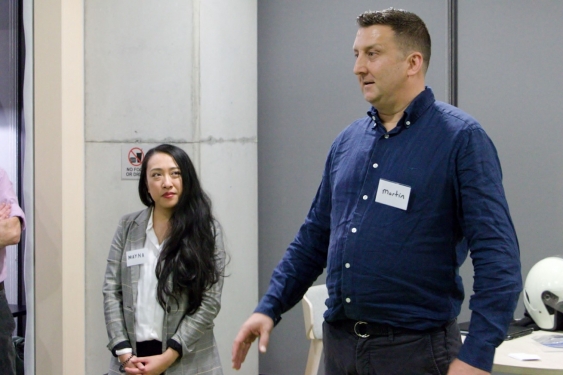

Older People Must Be Consulted On New Aged Care Act; Peak Aged Care Advocacy Bodies
- Understanding the new Aged Care Act
- Why we need a new act?
- How does it incorporate international conventions and human rights?
- The Statement of Rights – why it is important and how it differs from the Charter of Rights
- Understanding the approach to supported-decision making
- Current consultations available for older people
- hosted by Craig Gear OAM, CEO, OPAN
- Theresa Flavin, Member, OPAN’s Older Persons Reference Group
- Mel Metz, Assistant Secretary-Aged Care Legislative Reform, Department of Health and Aged Care
- Wendy Lacey, Adjunct Professor, Faculty of Business, Government & Law, University of Canberra

Government States That Nurses Are Back In Nursing Homes
- on average, there is a registered nurse on-site in aged care homes 98 per cent of the time
- on average, there is a registered nurse on-site in aged care homes for 23.5 hours a day
- 86 per cent of facilities now have a nurse on-site 24/7
- the majority of the remaining homes are very close to 24/7 coverage
- we expect these numbers will continue to improve every month.
AI Can Improve Healthcare For Australians But With Robust Rules In Place: AMA
10,000 Older Patients To Avoid EDs: Urgent Care Services Expand Across Sydney: Northern Sydney Local Health District Included
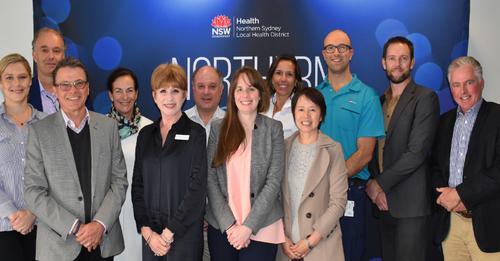 Around 10,000 older patients will have access to more tailored and timely healthcare in the comfort of their own home, to relieve pressure on hospitals and avoid unnecessary trips to the emergency department.
Around 10,000 older patients will have access to more tailored and timely healthcare in the comfort of their own home, to relieve pressure on hospitals and avoid unnecessary trips to the emergency department.2024 NSW Seniors Festival Grants Program Applications Open
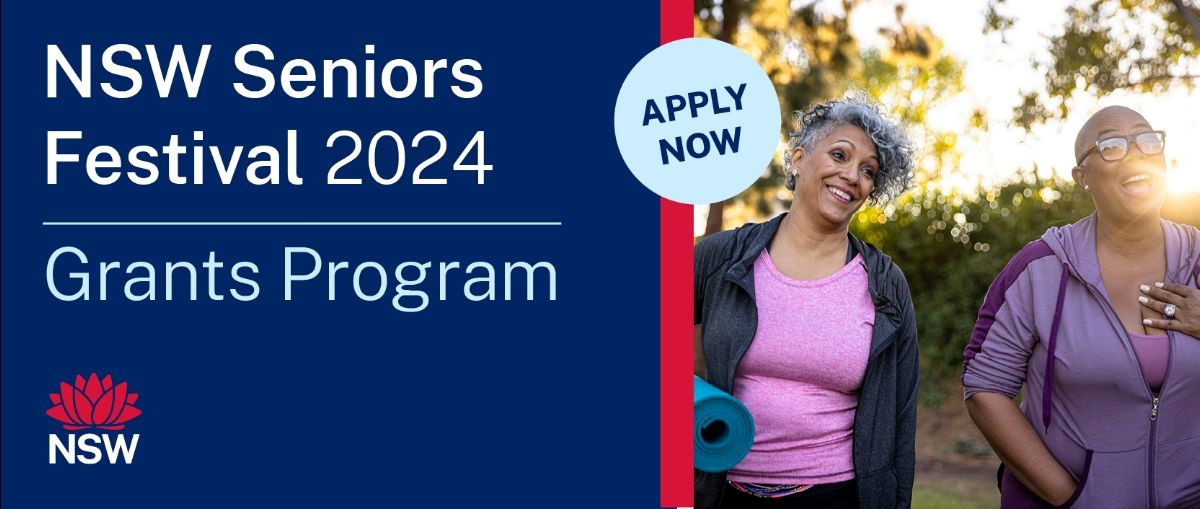
- supporting a broad range of local community organisations
- supporting programs and activities in regional NSW
- fostering partnerships with community groups and services
- providing programs and activities for diverse communities in NSW
- supporting projects that empower older people to stay connected
- assisting organisations to increase capacity of current programs and activities.
- Up to $5,000 for local community programs and activities.
- $5,001 - $10,000 to local government organisations for large scale community and regional programs and activities – funding is available to local government organisations only.
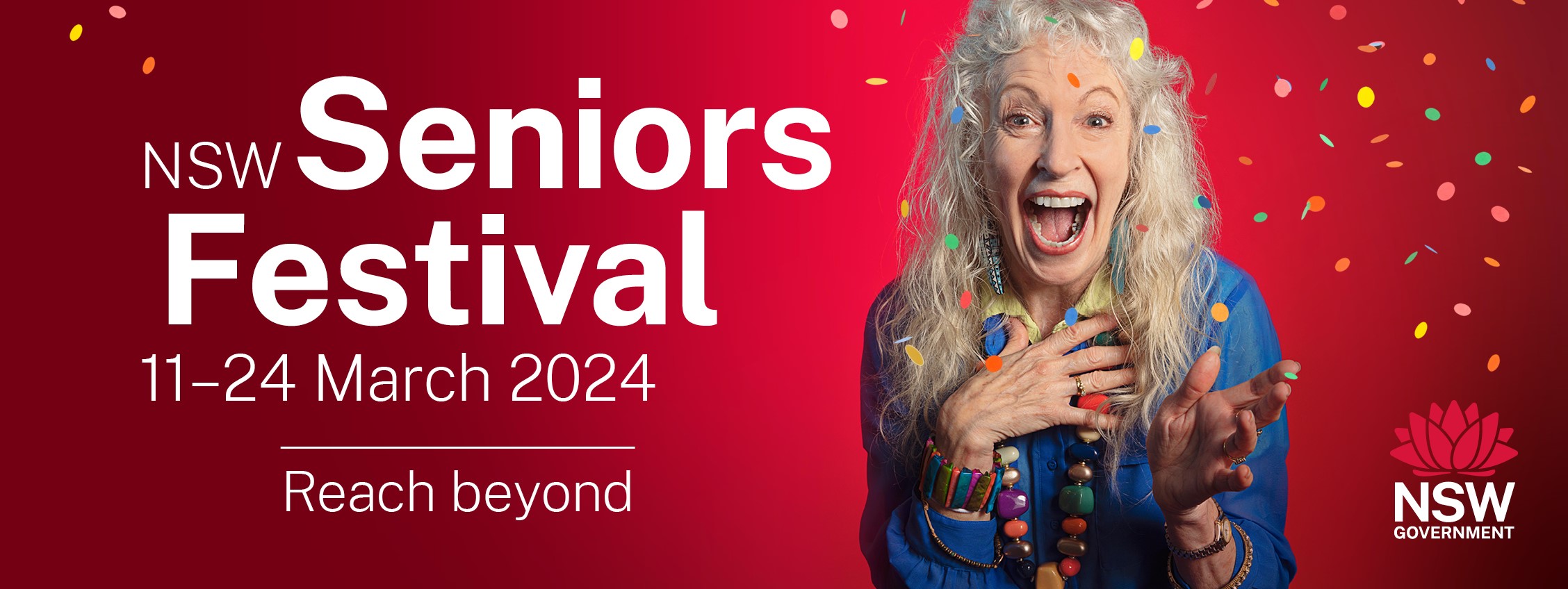
Ageing in a housing crisis: growing numbers of older Australians are facing a bleak future

The collision between an ageing population and a housing crisis has left more older people in Australia enduring housing insecurity and homelessness. Our research, released today, explores how the scale of these problems among older people has grown over the past decade.
Our report, Ageing in a Housing Crisis, shows safe, secure and affordable housing is increasingly beyond the reach of older people. This growing housing insecurity is system-wide. It’s affecting hundreds of thousands of people across all tenures, including home owners and renters.
The federal government released Australia’s first national wellbeing framework, Measuring What Matters last month. It recognises “financial security and access to housing” as essential for a secure, inclusive and fair society. However, urgent policy action is needed to reshape the Australian housing system so all older people have secure, affordable housing.
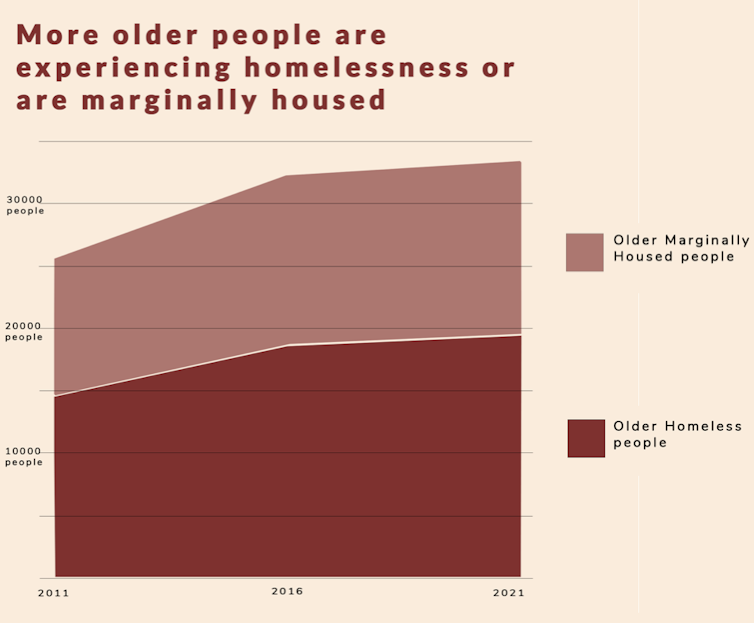
Older People Are Increasingly At Risk
We analysed the most recent Australian Bureau of Statistics (ABS) census data and homelessness estimates. More older people lived in marginal housing – defined by the ABS as including crowding (less severe), improvised dwellings and caravans – and more were homeless in 2021 than a decade earlier.
OLDER PEOPLE EXPERIENCING HOMELESSNESS BY GENDER AND CATEGORY IN 2011, 2016 AND 2021
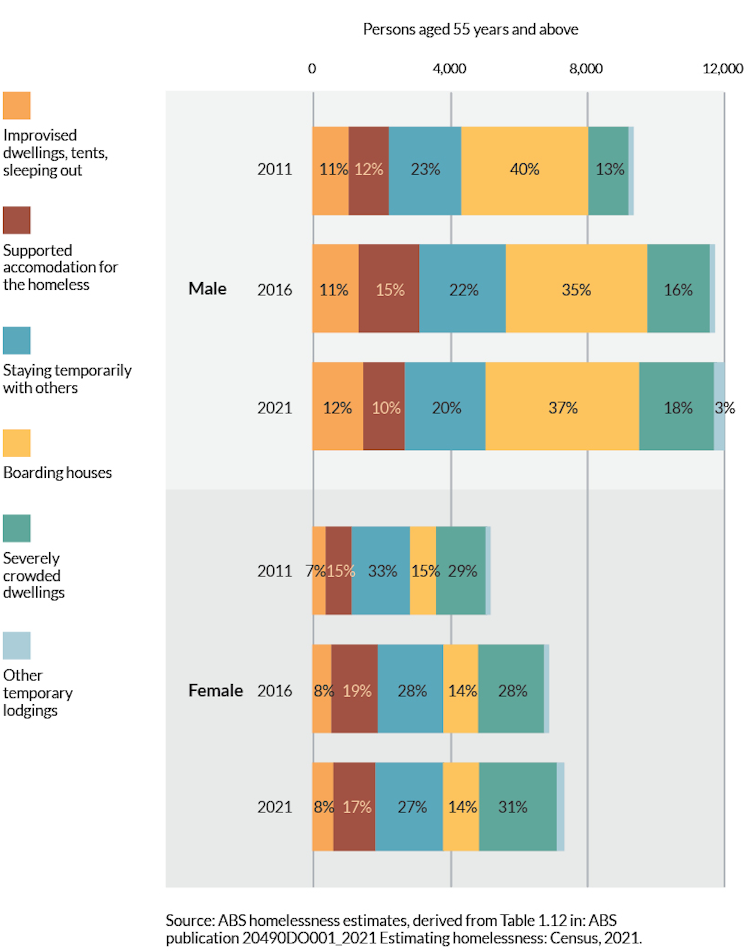
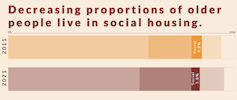
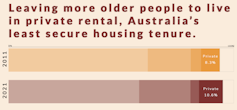
The proportion of older people in private rental housing has also increased. This means more older people are exposed to the insecurity of renting and rising rents. Our work shows they are struggling to afford private rental housing.
The lowest-income households are the hardest hit. The private rental market is failing to supply housing they can afford. The shortfall in subsidised social housing is huge.
Older people who receive government benefits and allowances are at most risk because their incomes are not keeping up with housing costs.
In 2019-20 only 19% of older people on very low incomes (the lowest 20% of household incomes) lived in households whose rent was affordable. This means four out of five were spending more than 30% of their income on rent (the affordability benchmark for low-income households). Two in five were paying severely unaffordable rents – more than 50% of their income.

For older people who don’t own their homes, rising housing prices create financial risk rather than windfall. At the same time, more older people have mortgages. This increases their risk of housing insecurity or financial stress in retirement.
Ageing Magnifies Unaffordable Housing Impacts
Rising housing costs, falling home ownership rates, mortgage debt carried into retirement, insecure private rental tenures and the worsening shortage of social housing are markers of system-wide housing insecurity.
Insecure or marginal housing affects all generations. However, for older people the risks are made worse by limited income-earning ability, increasing frailty, illness and/or caring responsibilities, growing need for at-home support, and age-based discrimination. These factors make it even harder to meet rising housing costs.
Housing insecurity widens the gap between the housing older people have and the housing they need to live safe, secure and dignified lives as they age.
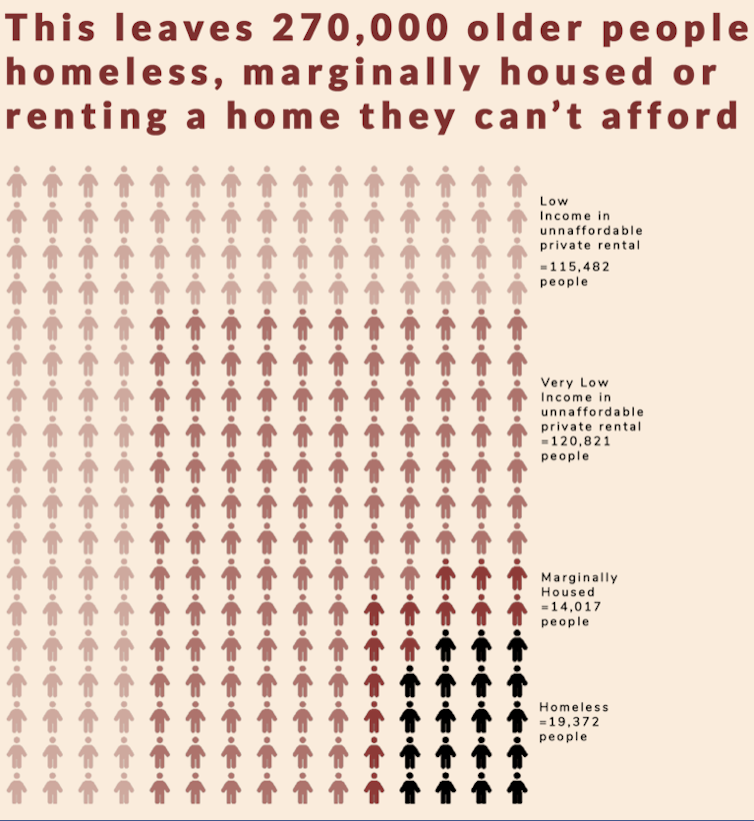
System-Wide Risks Demand System-Wide Action
Growing housing insecurity among older people is a result of system-wide problems. This means system-wide solutions are needed.
We call for:
adequate social housing supply that reflects population growth and ensures it’s available for older people across all states and territories, including by increasing aged-specific options and reducing the age at which social housing applicants are given priority to 45-55
stronger national tenancy regulations that prioritise homes over profit
dedicated marginal and specialist homelessness services that are well designed with and for older people who have experienced housing insecurity and support systems
support for people to remain in their own homes, across all tenures.
Responses and assistance models must allow for gender diversity, income difference, Aboriginal and/or Torres Strait Islander people’s cultural needs, as well as those of other culturally and linguistically diverse older people. Disability, caring responsibilities, history of trauma, and individuals’ unique housing pathways and experiences must all be considered.
Older people must have a say in reshaping the housing system. The Albanese government is developing a National Housing and Homelessness Plan. It’s essential that this plan, along with state, territory and local government implementation plans, consider the voices, experiences, concerns and aspirations of older people.
Housing Reform Is Good For Everyone
Older people are only one part of the population facing housing insecurity and homelessness. A comprehensive national housing plan must respond to all generational needs. Housing solutions for older people must not come at the expense of – or compete with – the needs of other generations.
Housing insecurity and homelessness in childhood, younger years and early adult life all warrant meaningful and urgent housing solutions. Making sure all people have lifelong access to secure housing will begin to reverse the growing problems identified by our report. Otherwise, Australia faces a future where more and more older people struggle with inadequate and unaffordable housing.
National reform that includes a focus on generational needs can deliver a housing system that provides affordable homes for everyone. This will ensure everyone is able to maintain community connections, which for older people means being able to age in safe, secure and affordable homes.![]()
Emma Power, Associate Professor, Geography and Urban Studies, Western Sydney University; Amity James, Associate Professor and Discipline Lead Property, Curtin University; Francesca Perugia, Senior Lecturer, School of Design and the Built Environment, Curtin University; Margaret Reynolds, Research Fellow, Centre for Urban Transitions, Swinburne University of Technology; Piret Veeroja, Research Fellow, Centre for Urban Transitions, Swinburne University of Technology, and Wendy Stone, Professor of Housing & Social Policy, Centre for Urban Transitions, Swinburne University of Technology
This article is republished from The Conversation under a Creative Commons license. Read the original article.
What is POTS? And how is it related to long COVID?

POTS or “postural orthostatic tachycardia syndrome” is a poorly recognised condition we’ve been hearing more about recently.
When people stand up, get out of bed or off the sofa, their heart races and they feel dizzy and fatigued, severely impacting their quality of life. Everyday tasks, such as washing their hair in the shower or working, become challenging because people cannot stay upright.
Before COVID, this debilitating condition was not widely talked about. But during the pandemic, we’ve been learning about the strong similarities with long COVID.
In fact, our recent research shows more than three-quarters of people with long COVID we studied had POTS.
What Triggers It?
Multiple studies, including our own, have shown viral infection is the most common trigger for POTS.
Then came the pandemic, with almost 800 million people infected so far with SARS-CoV-2, the virus that causes COVID. The World Health Organization says 10-20% of people infected with COVID are likely to develop long COVID – when unexplained symptoms persist three months or more after the infection.
Now, more research is showing how long COVID resembles POTS. Many people with long COVID show similar symptoms.
What We And Others Have Found
Our recent study found nearly 80% of people with long COVID had POTS. In people who had both and were of similar age, symptoms were indistinguishable from those who got POTS from other causes.
The people in our study either attended a specialist cardiology clinic for people with POTS or long COVID, or came via a long COVID support group on social media. So we cannot generalise our results to people managing their long COVID at home or with their GP.
Earlier this year, a review said about 30% of people with people with “highly symptomatic” long COVID also had POTS. Most (73%) met criteria for POTS and other types of dysfunction of the autonomic nervous system.
Taken together, we can conclude that many, but not all, cases of long COVID can be explained by POTS – a condition we’ve known about for years and know how to manage.
What Happens If You Have POTS?
We suspect some cases of POTS result from a hyper-vigilant immune response to an invading pathogen, such as a virus. This, or another trigger, affects the autonomic nervous system.
This part of the nervous system balances a vast array of functions including maintaining blood flow to vital organs, digestion, temperature control, sweating and even sexual function.
Even if the autonomic nervous system is marginally disturbed, it leads to the physiological equivalent of anarchy.
The simplest of daily tasks – such as washing your hair in the shower – can result in profound symptoms of dizziness, a racing heart, breathlessness, brain fog and general exhaustion.
In other research published earlier this year, we found people with POTS have a poor quality of life – poorer than people with chronic illnesses such as HIV, cancer, or cardiovascular and kidney disease.

A Long Path To Diagnosis
Many patients are also forced to negotiate a diagnostic odyssey littered with tales of disbelief and dismissal by medical professionals, friends and family. Diagnosis can take years.
In our submission to the parliamentary inquiry into long COVID, we shared the experiences of people with POTS symptoms and their frustration at the lack of recognition by the medical profession. One health worker said:
I am a nurse myself and specifically brought up that I believed I had POTS after COVID infection. I was treated like a hypochondriac and told I had anxiety, which was absolutely ludicrous as I had physical symptoms […] I had many presentations to [the emergency department] with no help or diagnosis whatsoever.
We Can Do Better
Prompt diagnosis is vital in the face of what we suspect are rising numbers of newly diagnosed cases associated with long COVID.
Although many people with POTS report they were referred to multiple specialists before they were diagnosed, this is not always necessary.
GPs can ask you to do a ten-minute standing test to help diagnose it. They can also exclude other common causes of POTS symptoms, such as lung and heart conditions.
There is no known cure for POTS. However, once diagnosed, there are multiple things that can improve and manage the condition. A questionnaire your GP can give you can help prioritise which symptoms to manage. You then work with your trusted GP to manage these.
Increasing fluid and salt intake (under the supervision of your GP), and using full-length compression tights is recommended. These help control heart rate and blood pressure, and reduce dizziness.

Avoiding triggers is important. These include avoiding standing still for extended periods, hot showers, large meals high in carbohydrates, and hot environments.
Many people also benefit from medicines to help control their blood pressure and heart rate.
How About Referral?
If referral to specialist services are required, this can be complex and expensive. There are no specialised clinics for POTS in public hospitals. Instead, POTS is mainly managed in the private sector.
Referral options can be overwhelming. People may benefit from referral to a range of health professionals to manage their symptoms, including a physiotherapist, psychologist, occupational therapist or exercise physiologist – ideally ones familiar with POTS.
All these barriers means access to diagnosis and treatment largely depends on someone having sufficient money, or being confident enough to navigate the health system.
If you have symptoms such as those we’ve described, see your GP for assessment. For more information about the condition, see the Australian POTS Foundation website, which also lists doctors and allied health professionals who are “POTS aware”.![]()
Marie-Claire Seeley, PhD Candidate, Australian Dysautonomia and Arrhythmia Research Collaborative, University of Adelaide and Celine Gallagher, Postdoctoral Fellow, Australian Dysautonomia and Arrhythmia Research Collaborative, University of Adelaide
This article is republished from The Conversation under a Creative Commons license. Read the original article.
Is red meat bad for you? And does it make a difference if it’s a processed burger or a lean steak?

A juicy burger is a staple in many Australians’ diet. Yet research shows regularly eating red meat can increase your risk of developing type 2 diabetes, heart disease and certain cancers.
But is eating a beef burger worse for your health than eating a lean grass-fed steak? And how much red meat should we really be eating?
Types Of Red Meat
First of all, it’s good to clarify that red meat refers to all mammalian muscle meat. So that includes beef, lamb, pork, veal, mutton and goat.
Then we can distinguish red meat types by how the animal has been raised and how the meat is processed. Here are some key terms to know.
Conventional meat, also called grain-fed, is meat from animals that are grass-fed for part of their lives and then given a grain-based diet for the remainder. Most red meat available in major supermarkets is grain-fed.
Grass-fed meat comes from animals that have grazed on pasture for their entire lives. This means grass-fed meat tends to have higher levels of unsaturated fats than conventional meat, and is why some research suggests it’s healthier. Grass-fed meat is also likely to cost more.
Organic meat is seen as a premium product as it has to meet government standards for organic produce. For example, meat labelled as organic cannot use synthetic pesticides or use hormones or antibiotics to stimulate growth.
Processed meats have been preserved by smoking, curing or salting, or by adding chemical preservatives. Examples include sausages, ham, bacon and hot dogs.

What Is The Nutritional Value Of Red Meat?
Red meat contains many nutrients that are important for health, including protein, vitamin B12, iron and zinc. Red meat is a good source of iron and zinc as they are more easily absorbed by the body from meat than from plant foods.
Red meat is often high in saturated fats, but this can range widely from less than 1% to over 25% depending on the cut and whether it’s trimmed of fat or not. Minced meat typically ranges from 2% to 9% saturated fat depending on whether its extra lean or regular.
To limit intake of saturated fats, opt for leaner mince and leaner cuts of meat, such as pork tenderloins or beef steak with the fat trimmed off.
Wagyu beef (which simply translates to Wa = Japanese and Gyu = cow) has been touted as a healthier alternative to conventional red meat, as it tends to be higher in unsaturated fats. But research is limited, and ultimately it still contains saturated fat.
Processed meats, such as bacon, salami and sausages, contain beneficial nutrients, but they are also high in saturated fat, sodium and contain preservatives.
Is Red Meat Bad For Your Health? And Does The Type Matter?
It’s widely reported eating too much red meat is bad for your health, because it can increase your risk of heart disease, type 2 diabetes and some cancers.
But most of the evidence for this comes from observational studies, which cannot determine whether red meat intake actually causes the condition.
Most evidence is observational because it’s simply not ethical or feasible to ask someone to eat large amounts of meat every day for many years to see if they develop cancer.
So let’s take a look at the evidence:
Heart disease and type 2 diabetes
In a review of 37 observational studies, the authors found weak evidence of an association between eating unprocessed red meat and heart disease and type 2 diabetes.
But for processed meat, a recent review showed that for each additional 50g of processed meat consumed per day, the risk of heart disease increased by 26% and the risk of type 2 diabetes increased by 44%, on average.
Cancer
Leading international organisations have declared there’s strong evidence consumption of red and processed meat increases the risk of colorectal cancer.
For example, in a study of nearly 500,000 people, each additional 50g of red meat consumed per day increased the risk of colorectal cancer by 18%. And each additional 25g of processed meat consumed per day, equivalent to a slice of ham, increased the risk by 19%.
While research has linked consumption of red and processed meat with increased risk of other types of cancer, such as lung, pancreatic and breast, the evidence is not consistent.
It also matters how red meat is cooked. For example, cooking a steak over a high heat, especially an open flame, chars the outside. This causes chemical compounds to form that have been shown to cause cancer in very high doses in animal models, and some studies in humans have found an association with increased cancer rates.
When it comes to how the animal was raised or its breed, based on current evidence, it’s unlikely the nutritional differences will have a substantial impact on human health. But research is limited in this area.
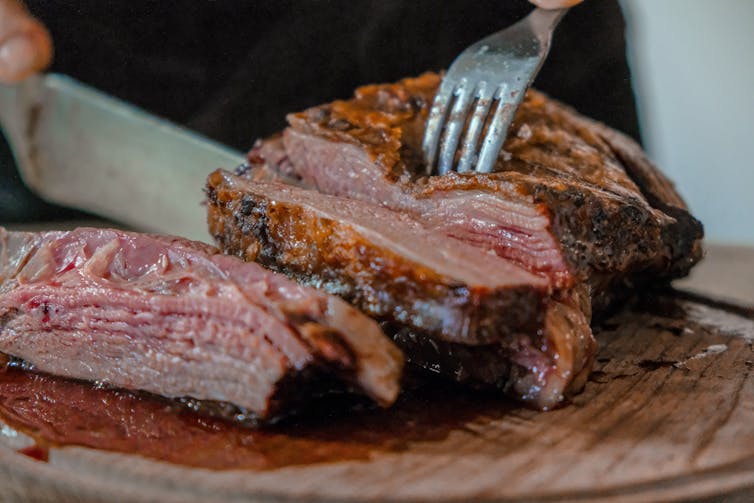
How Much Red Meat Should You Eat?
Our national dietary guidelines recommend the average adult eats a maximum of 455g of cooked lean red meat per week (or less than 65g a day, equivalent to one small lamb chop). This is also what’s recommended by the national Cancer Council.
For heart health specifically, the national Heart Foundation recommends eating less than 350g of cooked, unprocessed red meat per week (or less than 50g a day).
Many dietary guidelines around the world now also recommend limiting red meat consumption for environmental reasons. To optimise both human nutrition and planetary health, the EAT-Lancet commission recommends consuming no more than 98g a week of red meat and very low intakes of processed meat.
So What Does All Of This Mean For Your Diet?
The bottom line is that red meat can still be enjoyed as part of a healthy diet, if not eaten in excess. Where possible, opt for unprocessed or lean cuts, and try to grill less and roast more. Consider swapping red meat for lean chicken or fish occasionally too.
If you are looking for alternatives to meat that are better for your health and the environment, minimally processed plant-based alternatives, such as tofu, beans and lentils, are great options.![]()
Katherine Livingstone, NHMRC Emerging Leadership Fellow and Senior Research Fellow at the Institute for Physical Activity and Nutrition, Deakin University
This article is republished from The Conversation under a Creative Commons license. Read the original article.
ACCC Denies Authorisation For ANZ To Acquire Suncorp Bank
Worldcoin is scanning eyeballs to build a global ID and finance system. Governments are not impressed

Millions of people worldwide are lining up to stare into a silver sphere about the size of a bowling ball so their irises can be scanned in exchange for online identity verification and “free” cryptocurrency.
The silver spheres, known as “Orbs”, are part of the Worldcoin platform, which officially launched in July 2023 after an 18-month testing phase. Led by Sam Altman (chief executive of OpenAI, the company behind ChatGPT) and entrepreneur Alex Blania, Worldcoin offers users a “digital passport” known as World ID and small allocations of a cryptocurrency token also called Worldcoin (WLD), “simply for being human”.
Worldcoin aims to provide a “proof of personhood” to distinguish humans from artificial intelligence (AI) systems online.
However, critics say the company is essentially bribing people to hand over highly sensitive biometric data. Governments are taking note: the Worldcoin platform has already been suspended in Kenya, and is under investigation in several other countries.
Gaze Into The Orb
Users can download the WorldApp on their mobile phone, then find their “nearest Orb”. The Orb uses iris scans to uniquely identify a person.
Once the person has their iris scanned, they receive a World ID which will function as an online ID much like a Google or Facebook login. World ID is meant to be different because it can prove the user is human – and more private, because it does not link to other personal information about the user.

Despite the “digital passport” label, World ID is not intended to reveal or verify a user’s identity in the conventional sense. It merely establishes the user as “a unique and real person”, rather than a bot.
In most countries, the user is also entitled to units of WLD cryptocurrency once their iris scan is complete.
The Worldcoin website currently lists 60 Orb locations worldwide, particularly in Europe, Asia, North America and South America, and notes there will also be Orb “pop-ups”.
At the time of writing, there appear to be no Orb locations in Australia, so people in Australia cannot earn WLD tokens “for being human”. But they can purchase the WLD cryptocurrency via certain cryptocurrency exchanges and download the World App, which also functions as a cryptocurrency wallet.
Cash For Eyeballs Jeopardises Human Rights
Altman is a key player in the AI boom that supposedly makes Worldcoin necessary, so critics have suggested he is “simply profiting from both AI’s problem and solution”.
When the Worldcoin platform officially launched, after signing up some 2 million users in a testing phase, Altman said the Orbs were scanning a new user every eight seconds.
In Kenya, the launch saw “tens of thousands of individuals waiting in lines over a three-day period to secure a World ID”, which Worldcoin attributed to “overwhelming” demand for identity verification.
Independent reporting suggests the promise of “free” cryptocurrency was a more common motive. In most locations, Worldcoin offers a “genesis grant” of 25 units of its WLD cryptocurrency when users scan their irises. (The value of WLD fluctuates, but the grant has been worth around US$50, or $A75, over the past month.)
People queuing for the Orb in Kenya told the BBC “I want to register because I’m jobless and I’m broke,” and
I really like Worldcoin because of the money. I’m not worried about the data. As long as the money comes.
Orb operators are also paid for each user they sign up.
Critics have labelled this strategy of paying people to scan their irises as dystopian and equivalent to bribery.
Offering money for sensitive data arguably makes privacy – a human right – a luxury only the wealthy can afford. People experiencing poverty may risk future harms to meet their immediate survival needs.
‘Cataloguing Eyeballs’: The Risks Of Using Biometric Data
Worldcoin uses irises for verification because every iris is unique and therefore difficult to fake. But the risks of handing over such data are very high. Unlike a driver’s licence or a passport, you cannot replace your iris if the data is compromised.
Surveillance whistleblower Edward Snowden has criticised Worldcoin for “cataloguing eyeballs”, and tweeted about the unacceptable risks:
Don’t use biometrics for anything. […] The human body is not a ticket-punch.
Worldcoin claims the iris scans are deleted after being converted into a unique iris code, which becomes the user’s World ID. The World ID is then stored on a decentralised blockchain, with the aim of preventing fakes or duplicates.
However, the iris scan is only deleted if the user opts for the “Without Data Storage” option (which may mean they need to return to an Orb to re-verify in the future). If the user selects the “With Data Storage” option, Worldcoin states the iris scan is sent via encrypted communication channels to its distributed data stores where it is encrypted at rest.
In either case, the user must simply trust the company to delete the biometric data, or appropriately secure it against misuse.
There have been many instances in which Silicon Valley companies have promised to secure data and to strictly limit its use, only to break those promises by disclosing the data to other companies or government agencies or failing to secure it against attack.
Journalist Eileen Guo also points out that Worldcoin has not yet clarified whether it still uses stored biometric data to train AI models and whether it has deleted biometric data collected during its test phase.
And despite the supposed security of biometric scanning, there have already been reports of fraudulent uses of the Worldcoin system. For example, black market speculators are alleged to have persuaded people in Cambodia and Kenya to sign up for Worldcoin and then sell their World IDs and WLD tokens for cash.
Regulatory Action
Regulators in several countries are taking action. The Kenyan government has now suspended Worldcoin’s activities, stating regulatory concerns surrounding the project “require urgent action”.
The Communications Authority of Kenya and Office of the Data Protection Commissioner say they are concerned about the offer of money in exchange for consent to data collection; how securely the data are stored; and “massive citizen data in the hands of private actors without an appropriate framework”.
The German privacy watchdog is investigating Worldcoin’s business practices with support from the French privacy regulator, which called Worldcoin’s data practices “questionable”. The UK Information Commissioner’s Office has announced it will investigate Worldcoin, referring to the high risk of processing special category biometric data.
While there are no Orbs in Australia yet, the federal privacy regulator has previously found some companies in breach of the privacy law for failing to obtain valid consent for the use of biometric data and collecting it when it was not reasonably necessary.![]()
Katharine Kemp, Associate Professor, Faculty of Law & Justice, and Deputy Director, Allens Hub for Technology, Law & Innovation, UNSW Sydney
This article is republished from The Conversation under a Creative Commons license. Read the original article.
Study Highlights Importance Of Mineral Iron In Ocean Ecosystems
State-Of-The-Art Technology Arrives At New Nepean Hospital Pathology Laboratory
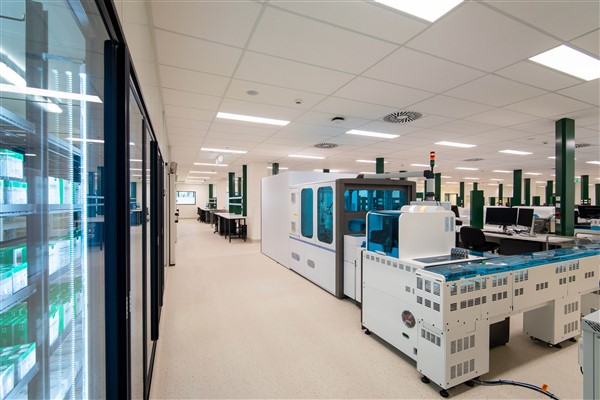 The latest in cutting-edge medical technology is being rolled out in a new state-of-the-art pathology laboratory at Nepean Hospital, as part of a $29 million investment in NSW Health Pathology laboratories across western Sydney and regional NSW, the state government has announced.
The latest in cutting-edge medical technology is being rolled out in a new state-of-the-art pathology laboratory at Nepean Hospital, as part of a $29 million investment in NSW Health Pathology laboratories across western Sydney and regional NSW, the state government has announced.- a new adult intensive care unit
- renal services
- medical imaging
- more than 100 inpatient beds.
Whale-Like Filter-Feeding Discovered In Prehistoric Marine Reptile

Australia’s First Purpose-Built Cystic Fibrosis Specialist Service Ward Opens At Westmead Hospital
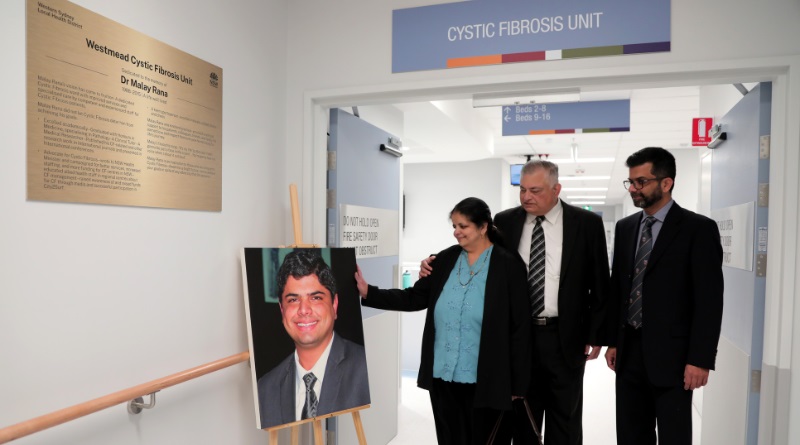
$2 Million To Support Motor Neurone Disease Research In NSW
Out With The Life Coach- In With The Chatbot
 As we start to edge out of winter, improving our diet and boosting our exercise start to appear on our agenda. But, when it comes to encouraging a healthier lifestyle, it may surprise you that artificial intelligence could be your best friend.
As we start to edge out of winter, improving our diet and boosting our exercise start to appear on our agenda. But, when it comes to encouraging a healthier lifestyle, it may surprise you that artificial intelligence could be your best friend.- An extra 735 steps per day,
- one additional serving of fruit and vegetables per day, and
- An additional 45 mins of sleep per night.
Disclaimer: These articles are not intended to provide medical advice, diagnosis or treatment. Views expressed here do not necessarily reflect those of Pittwater Online News or its staff.